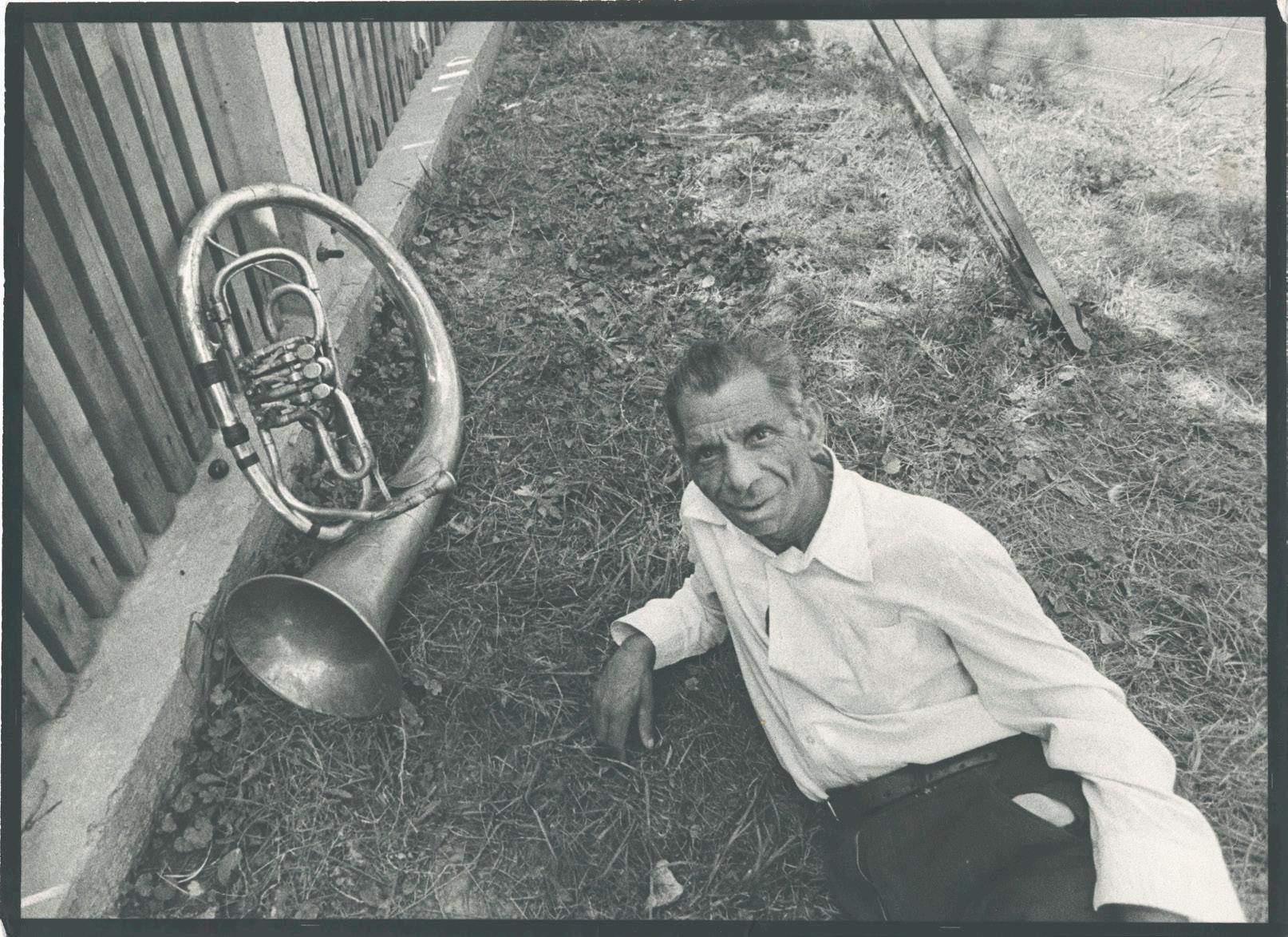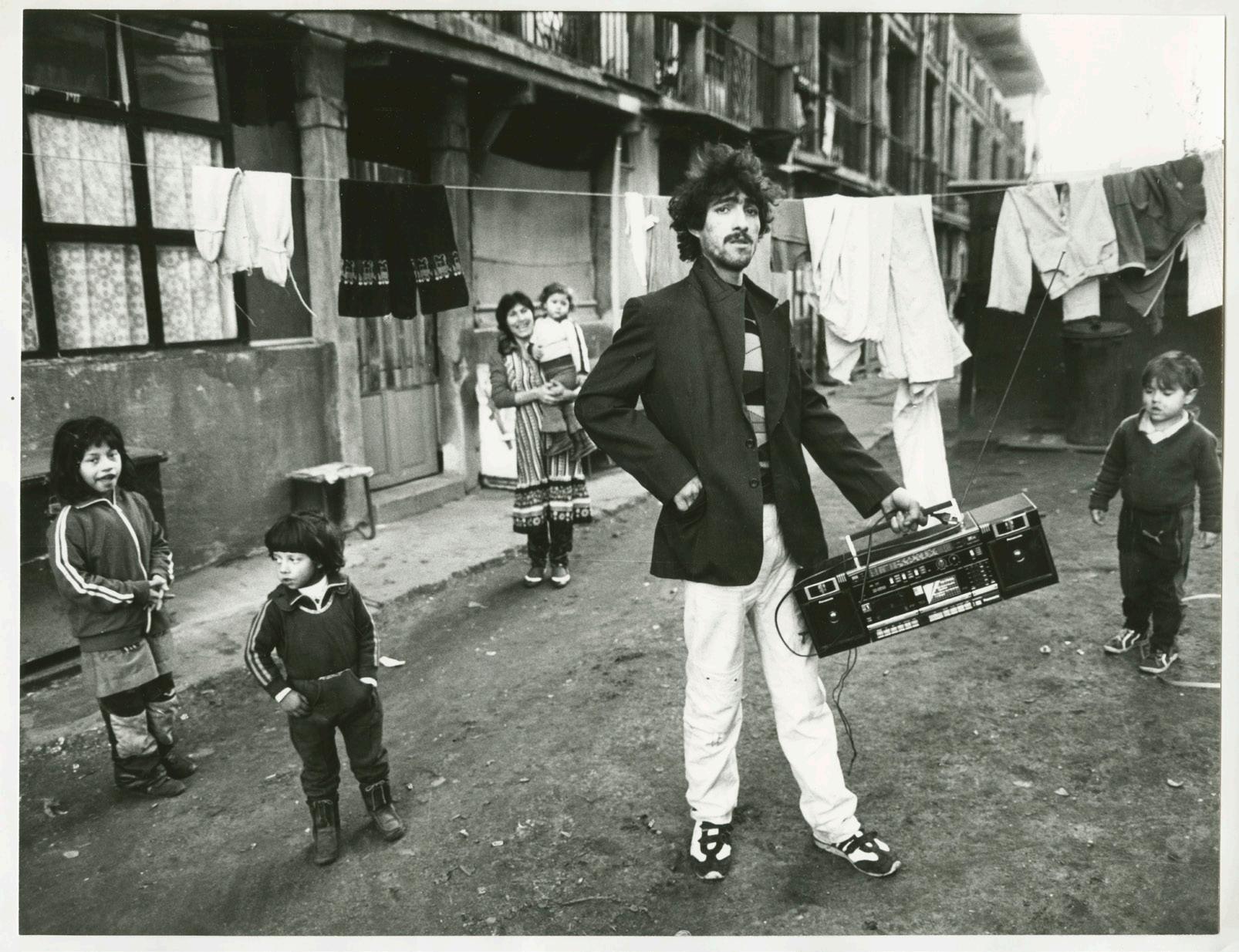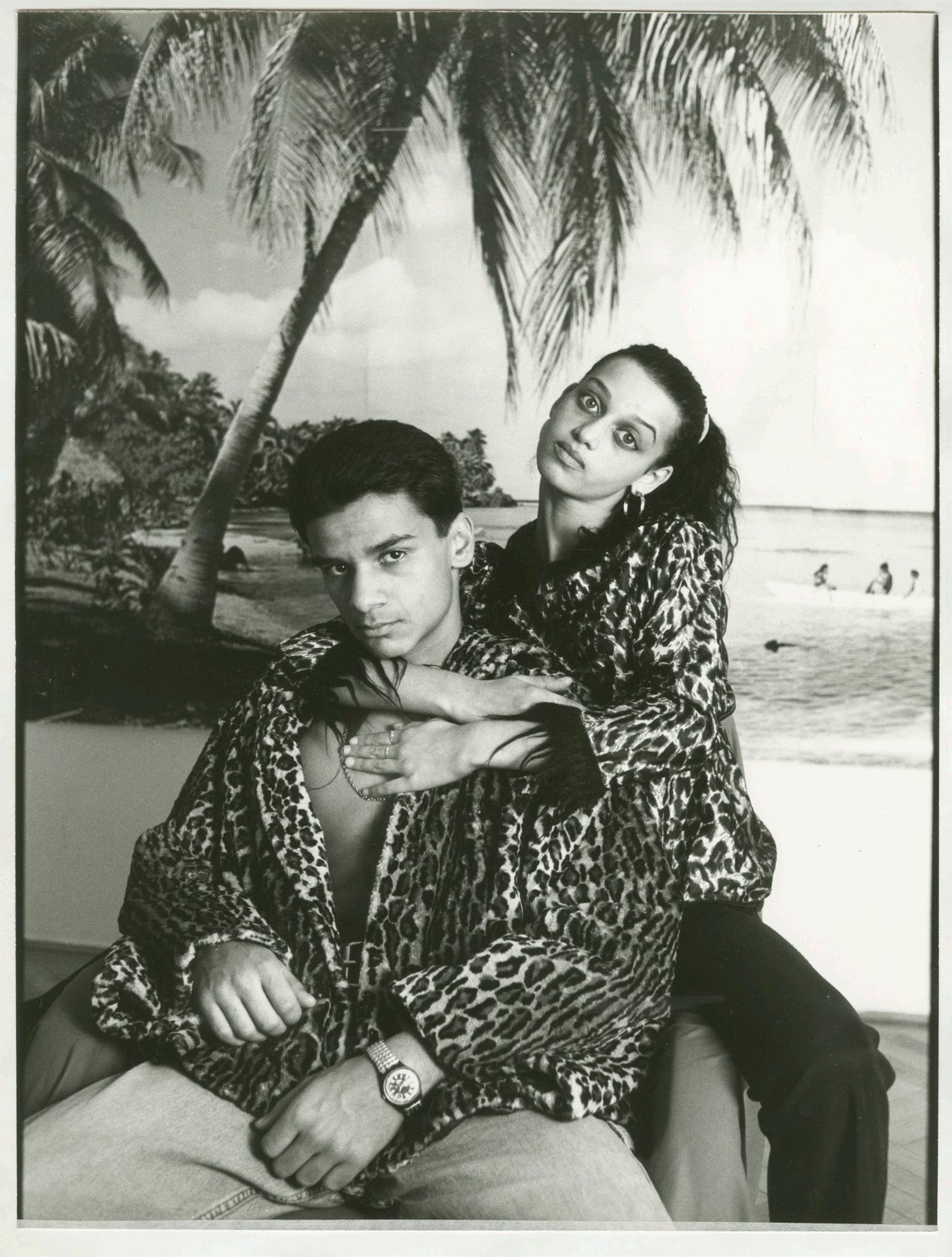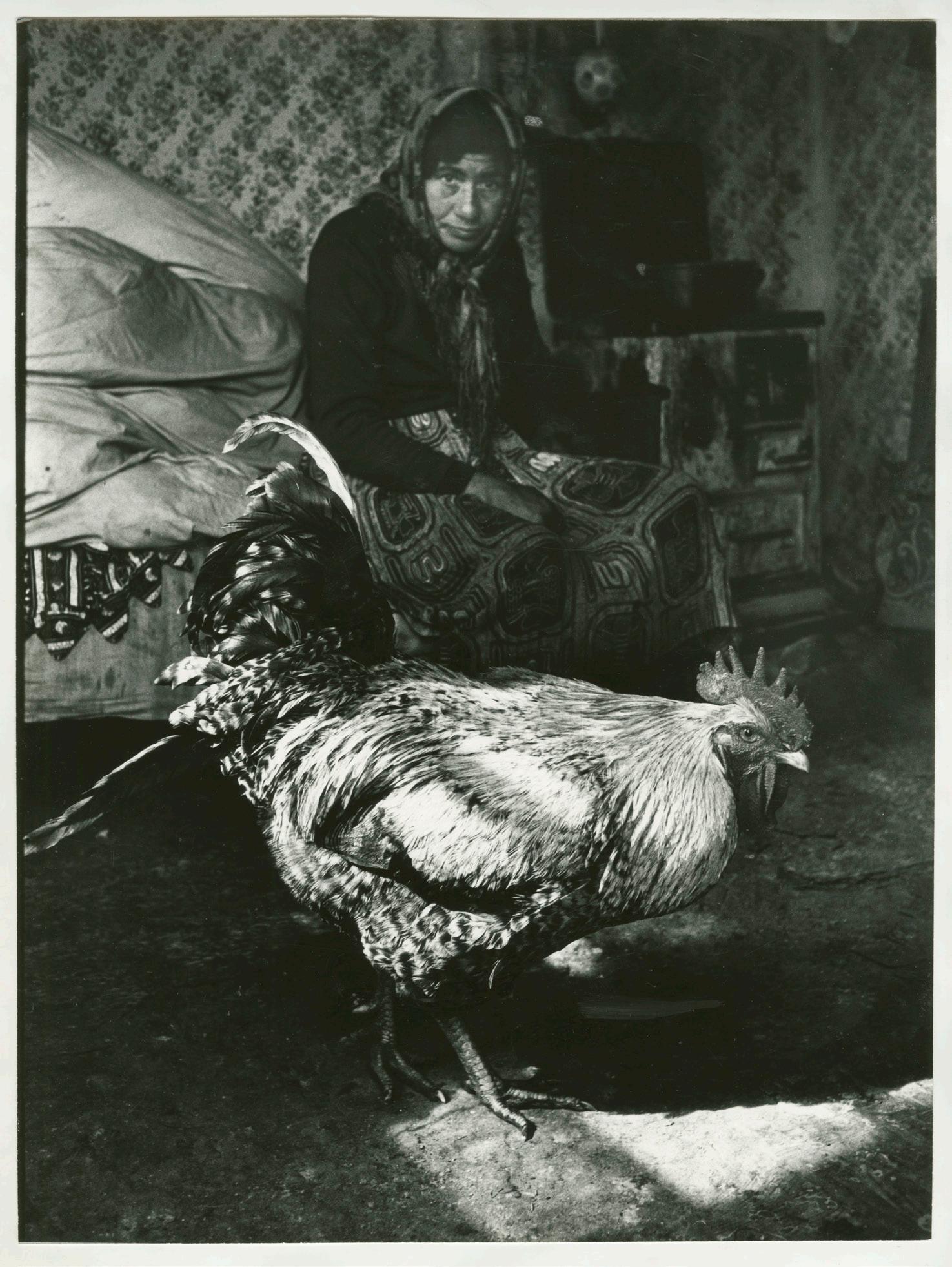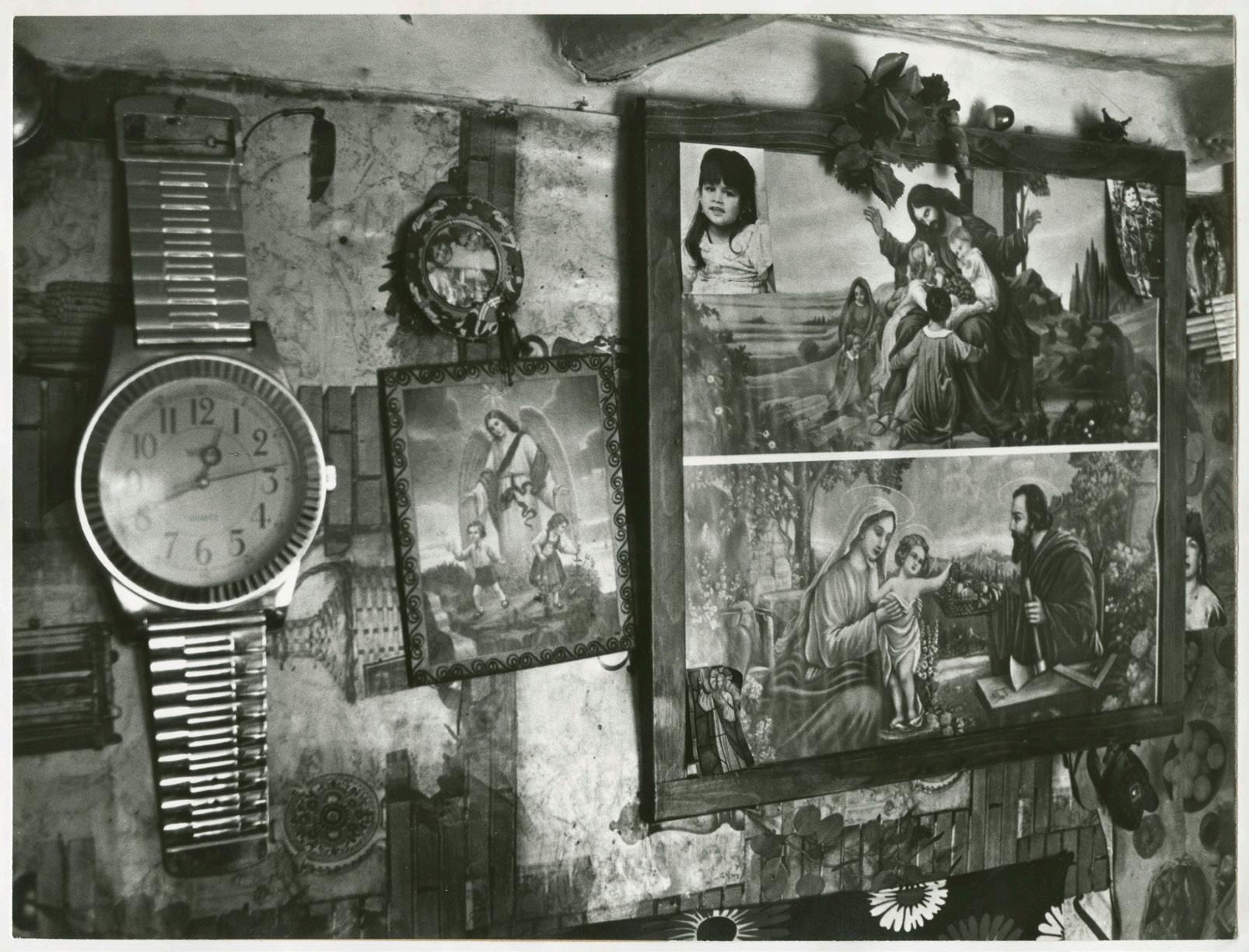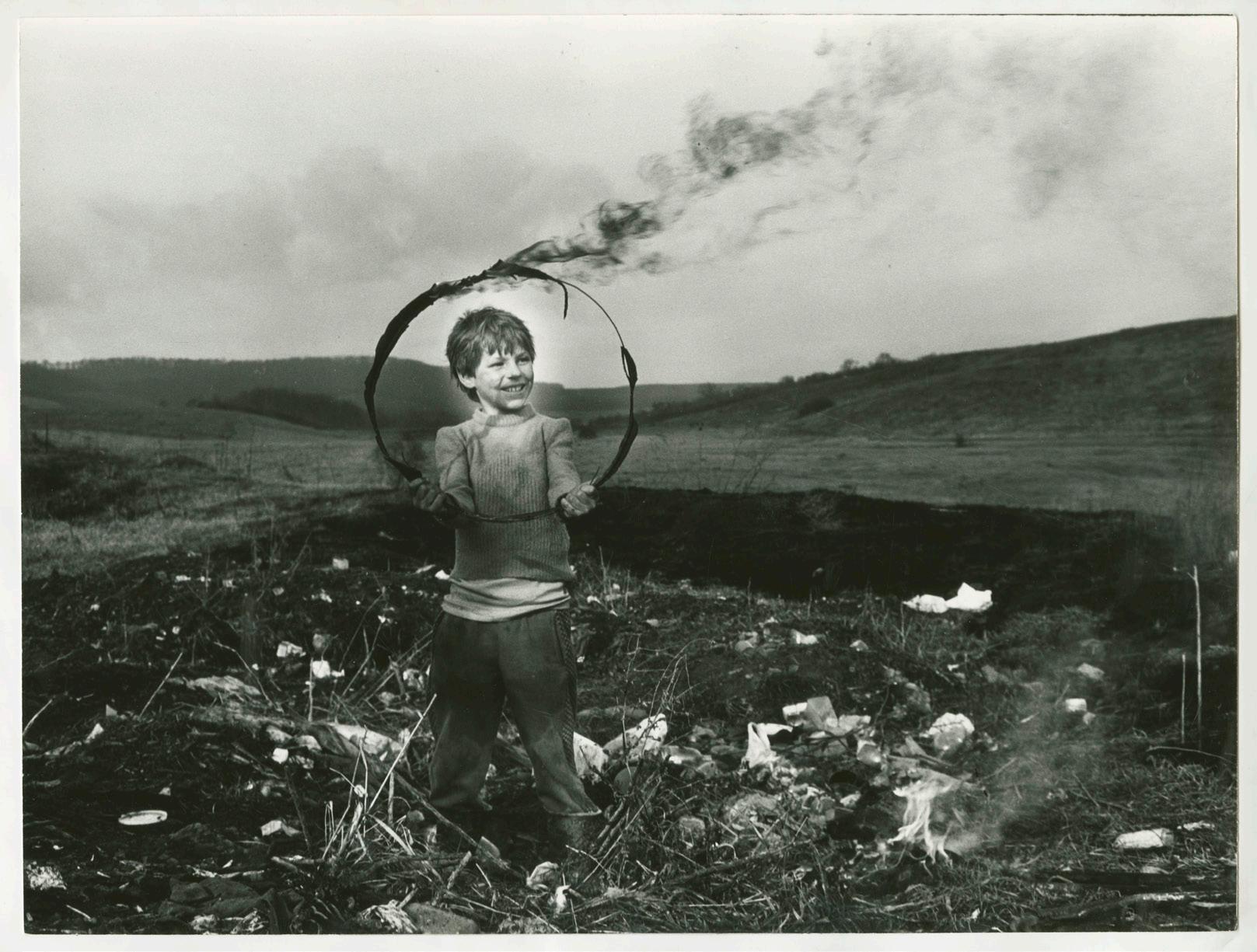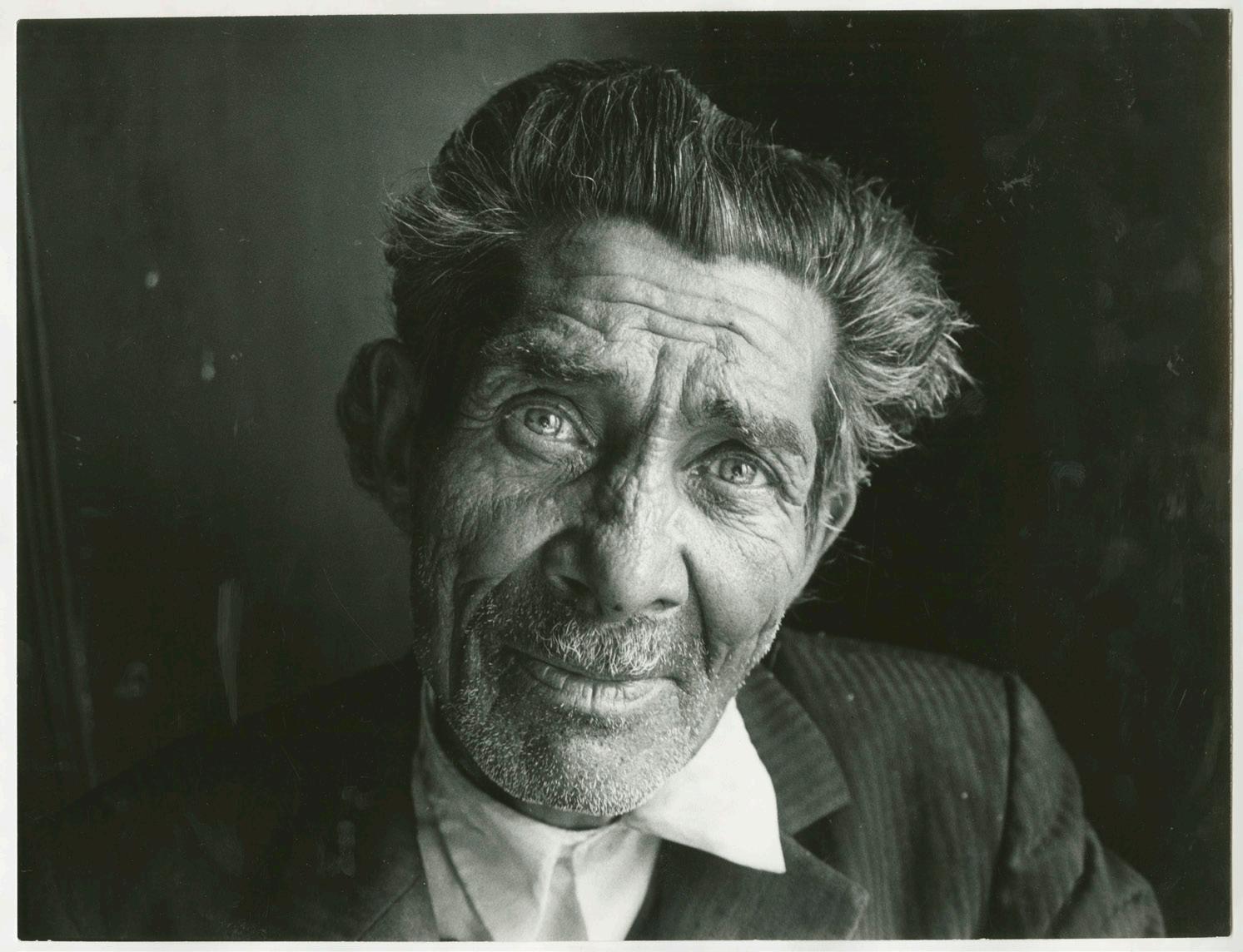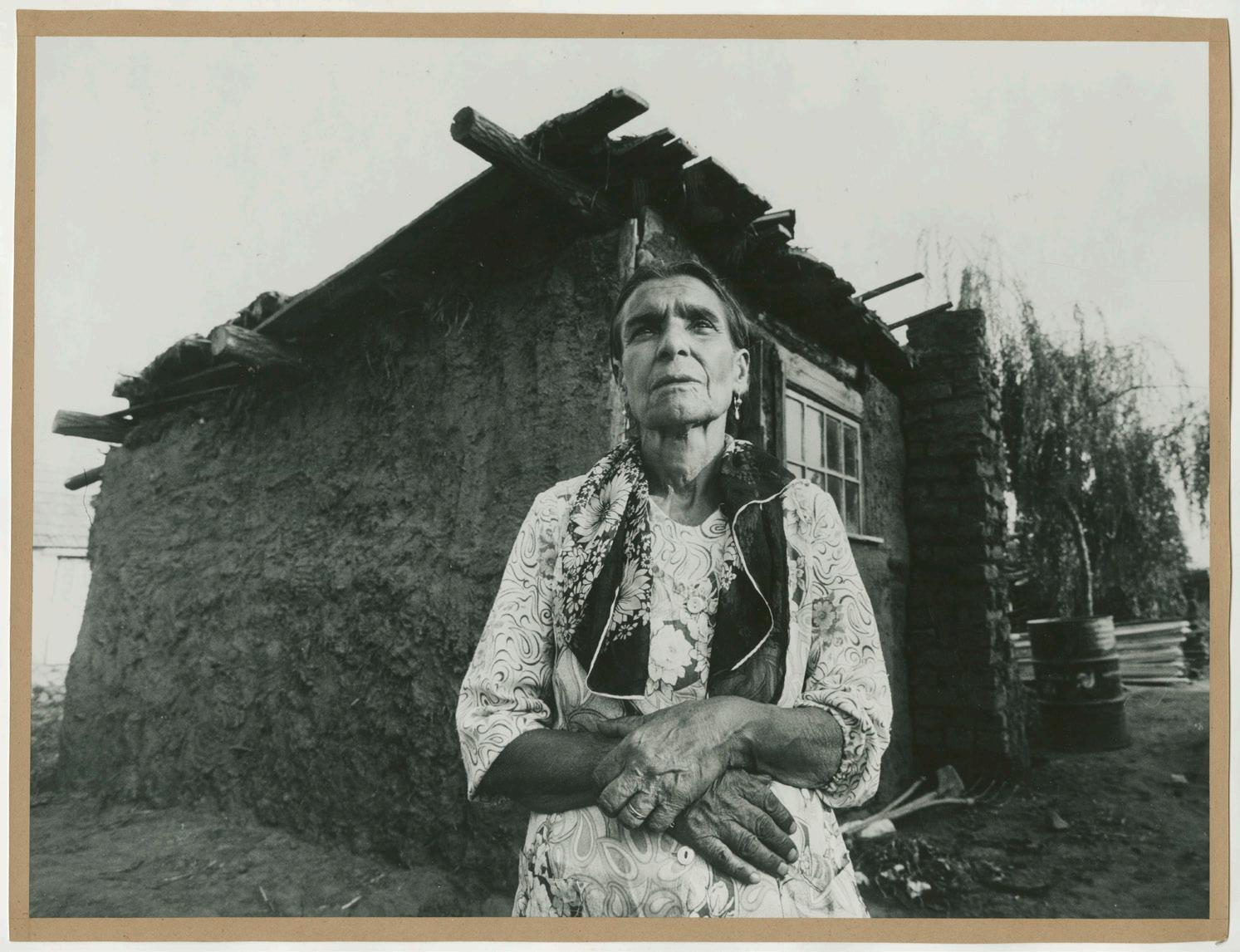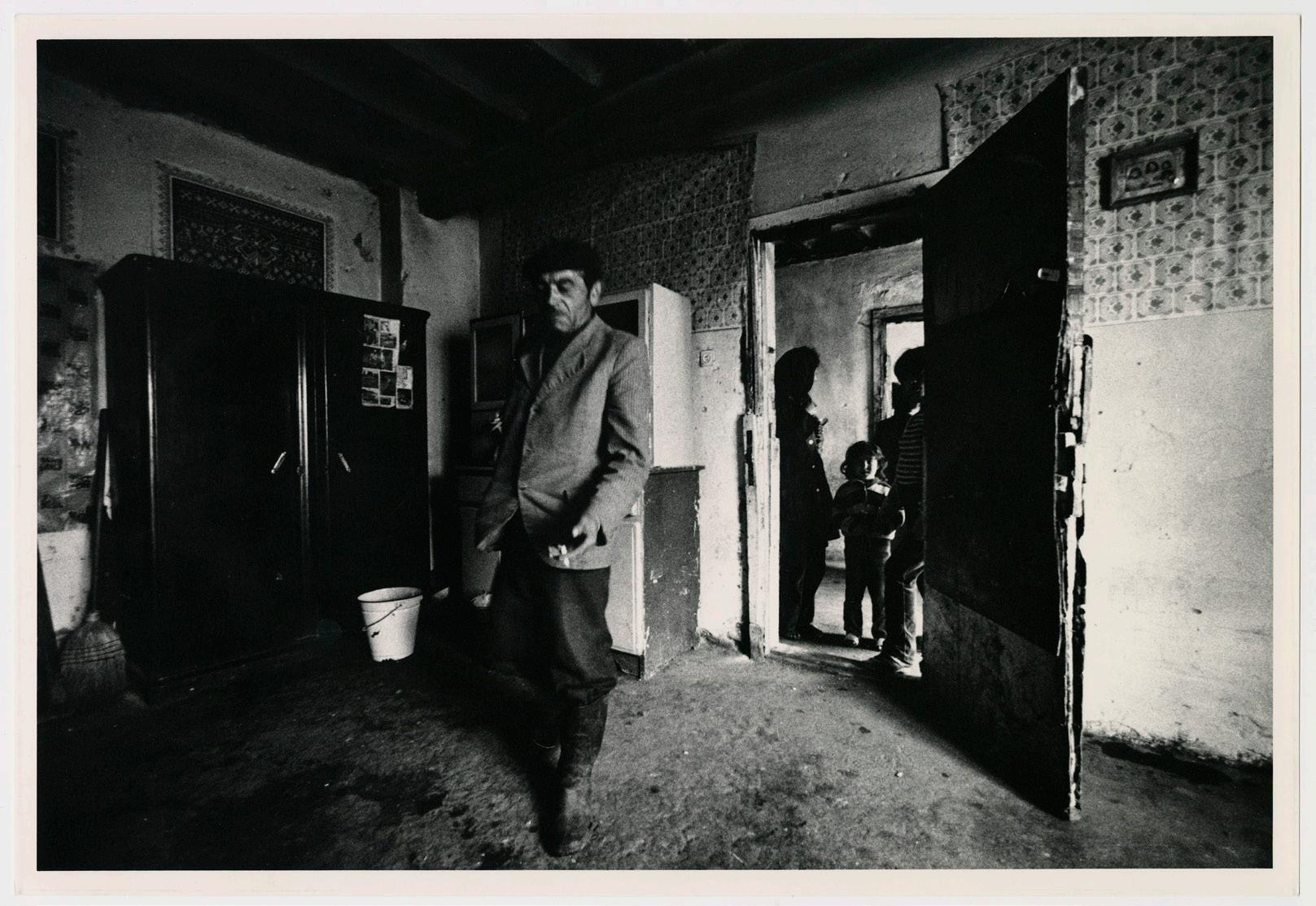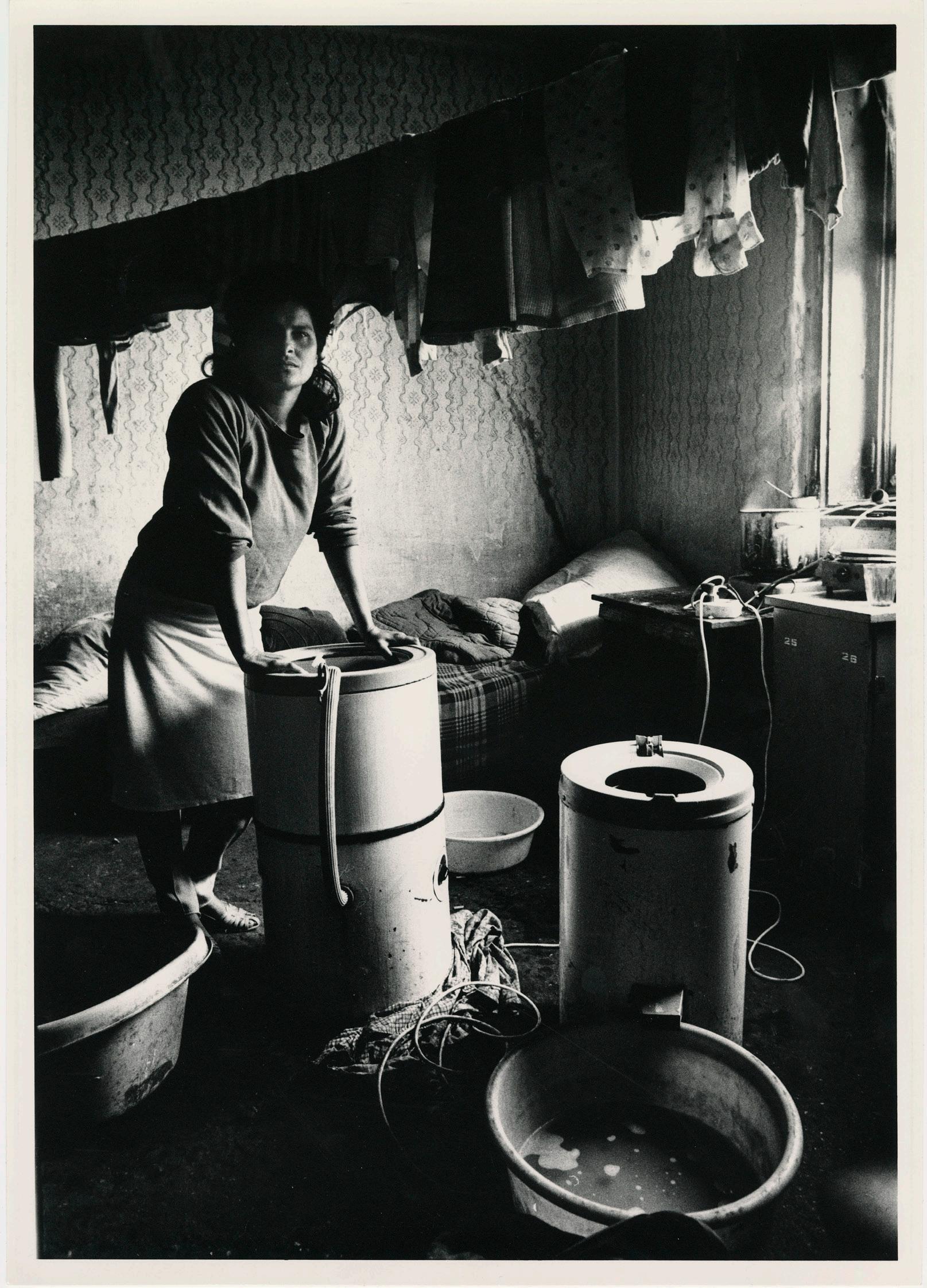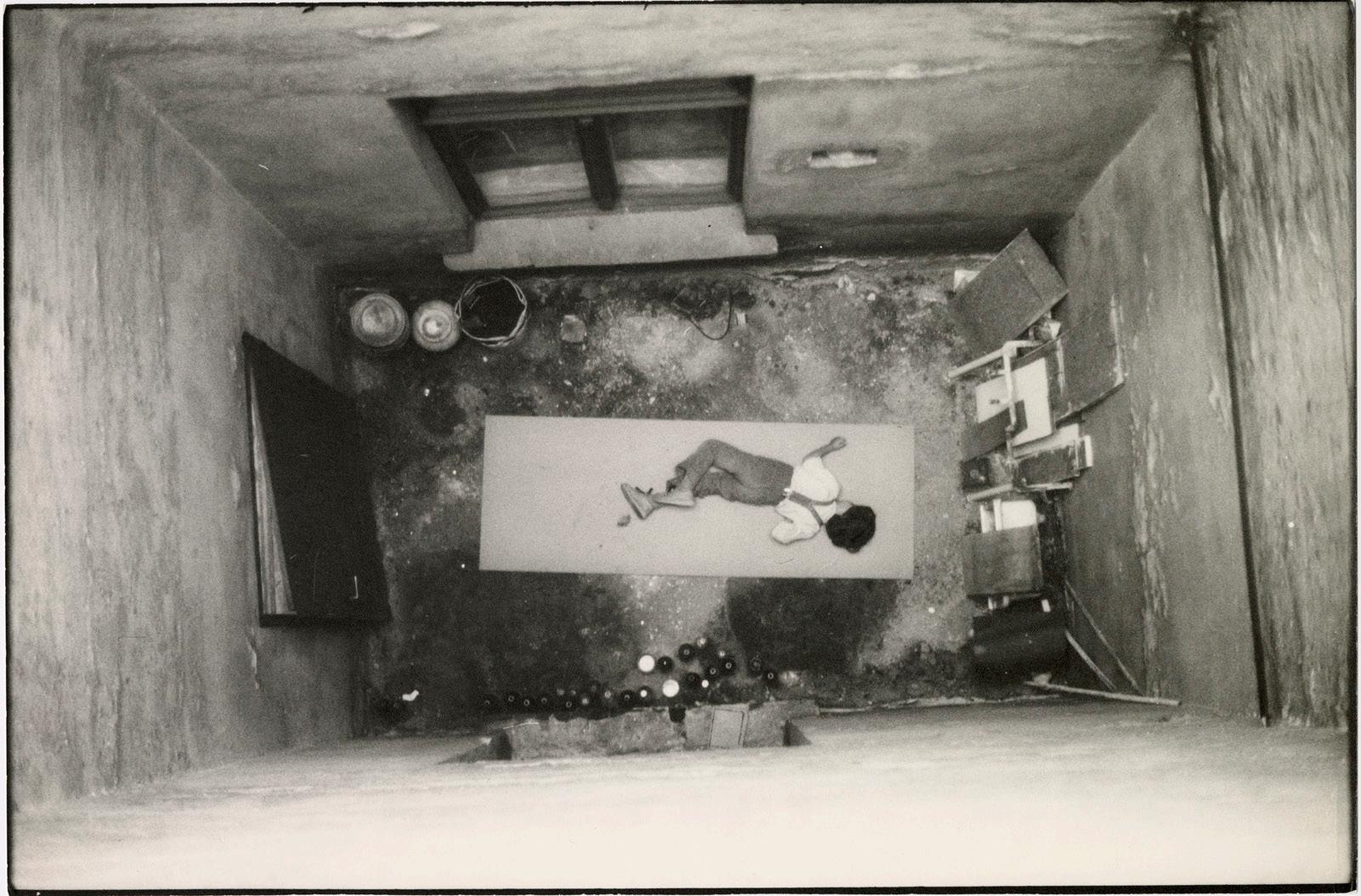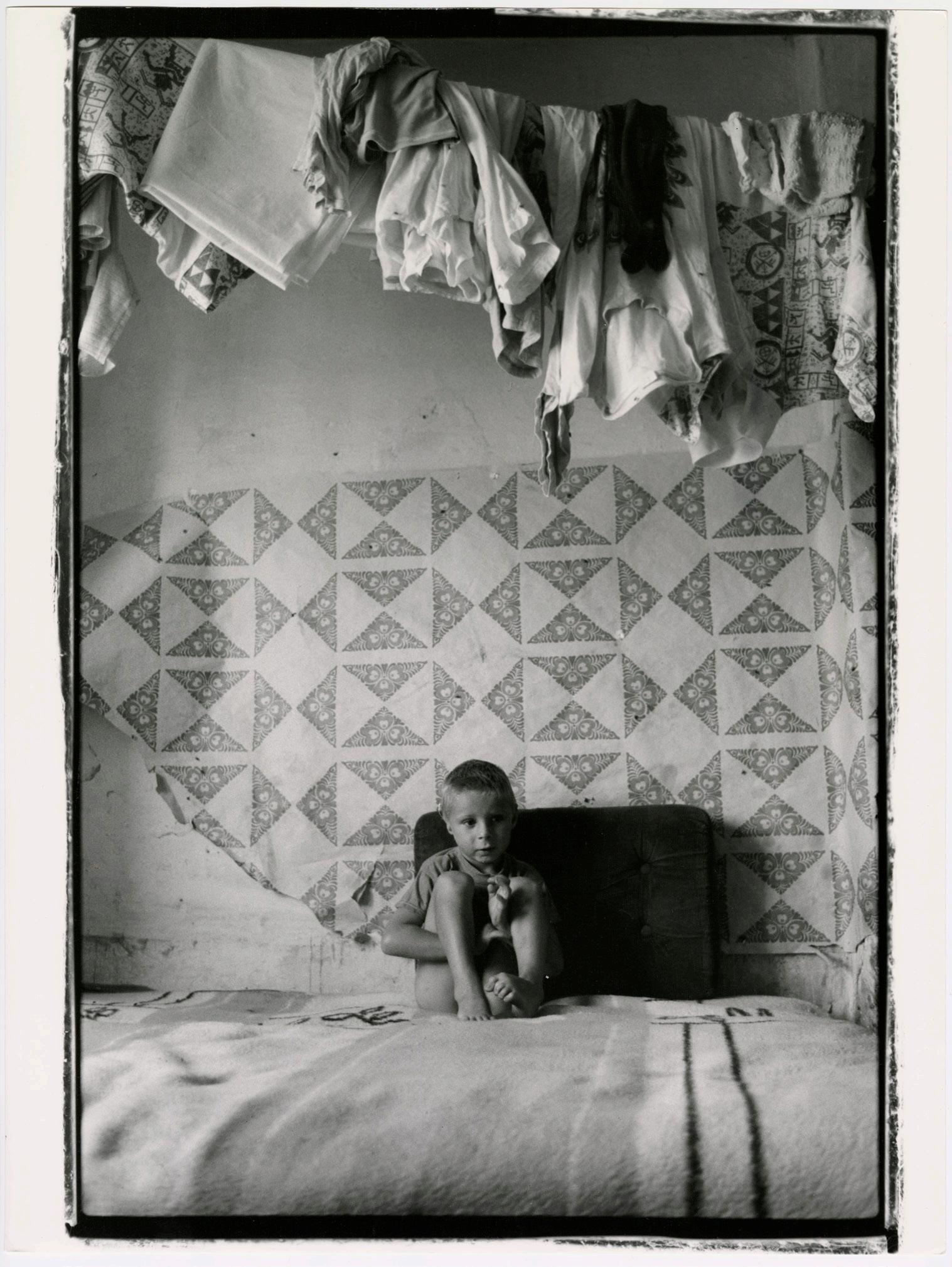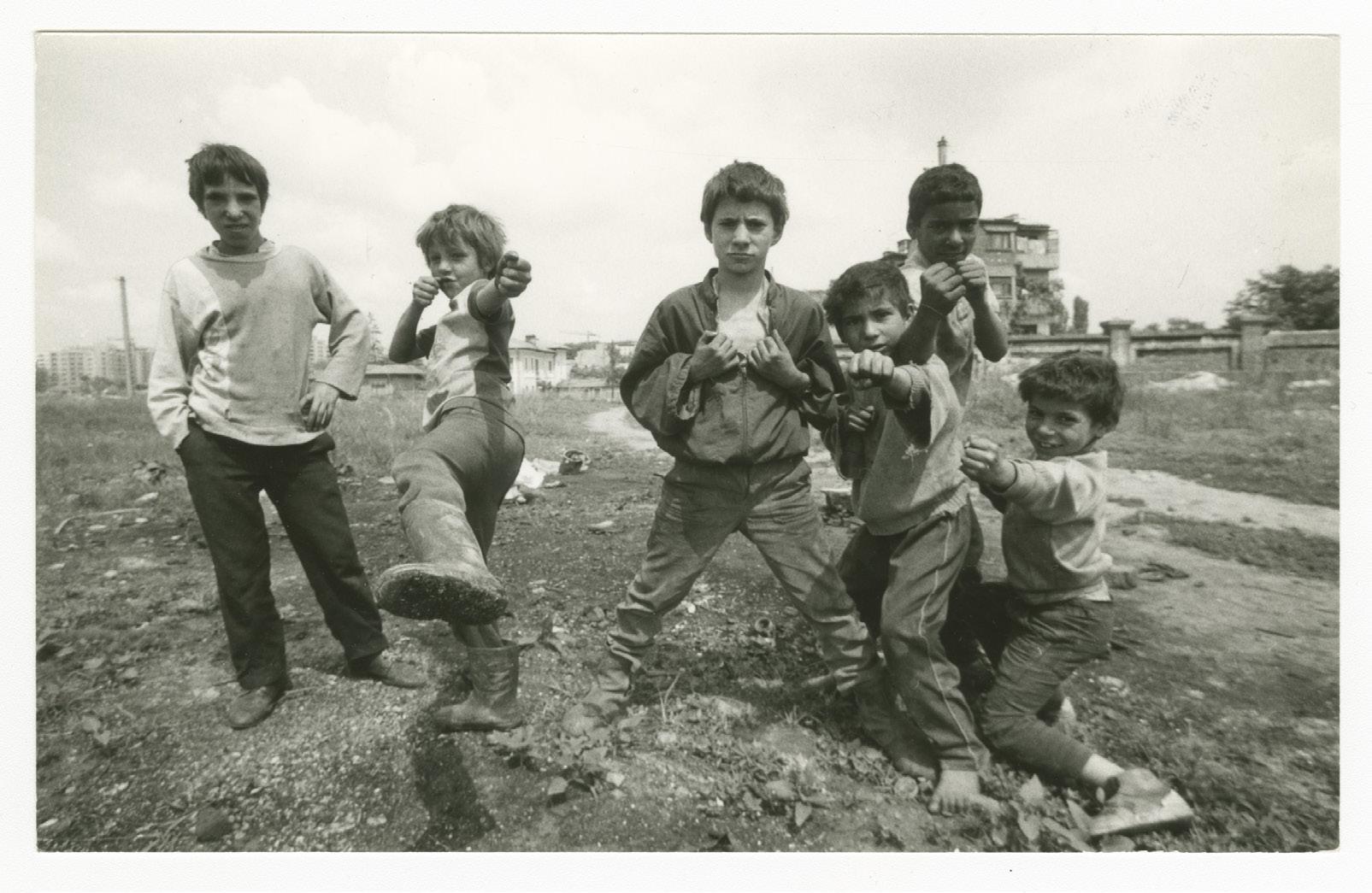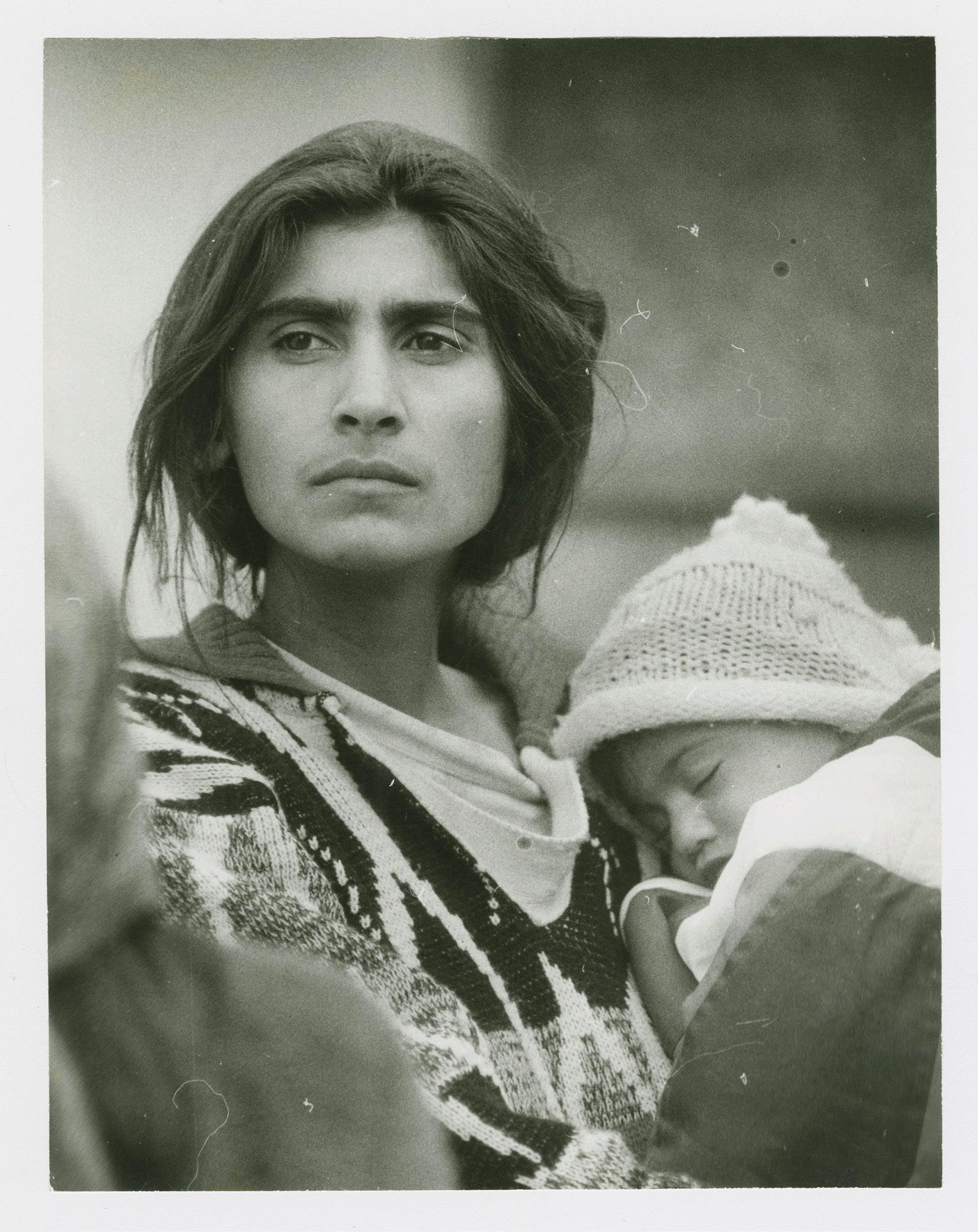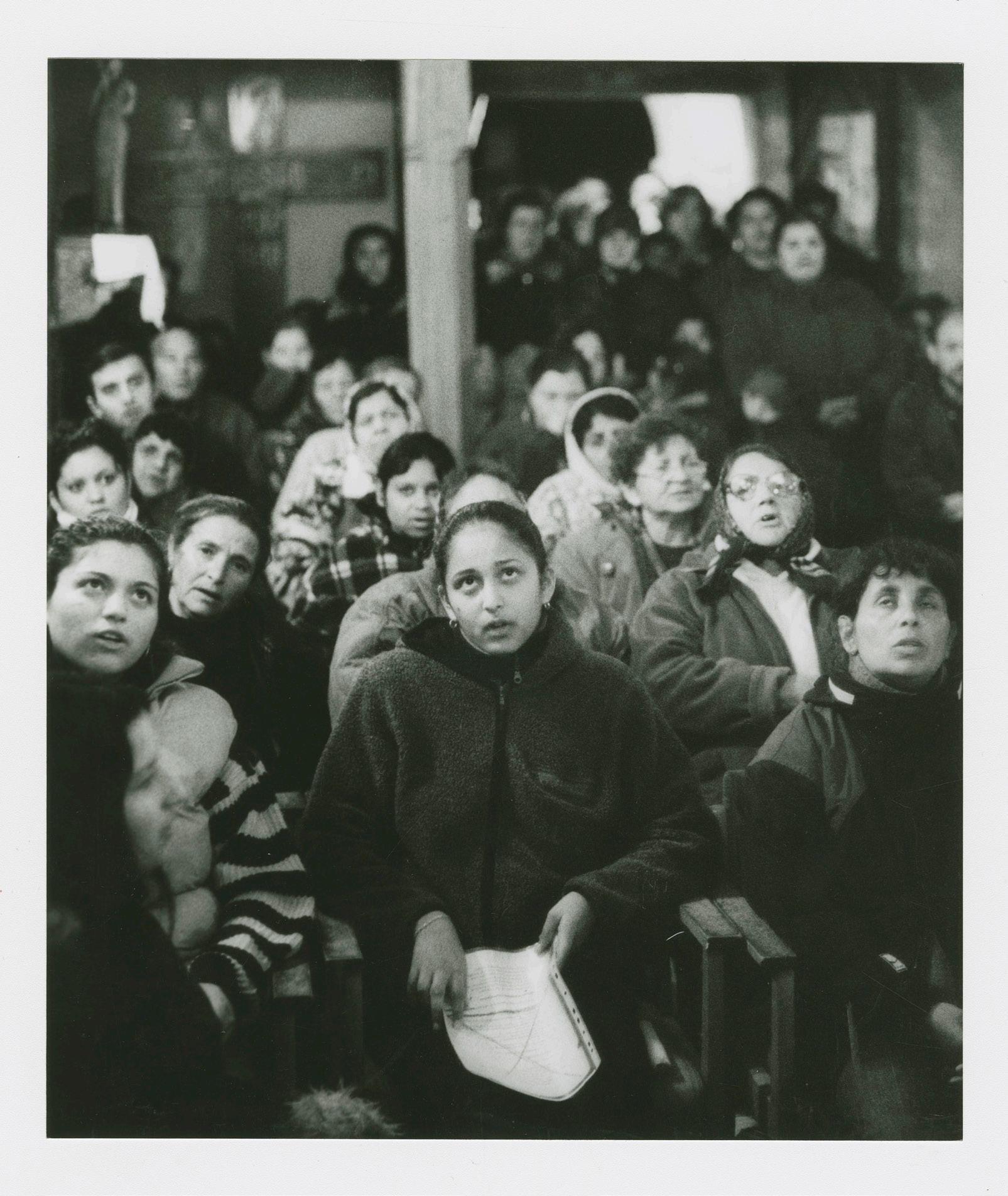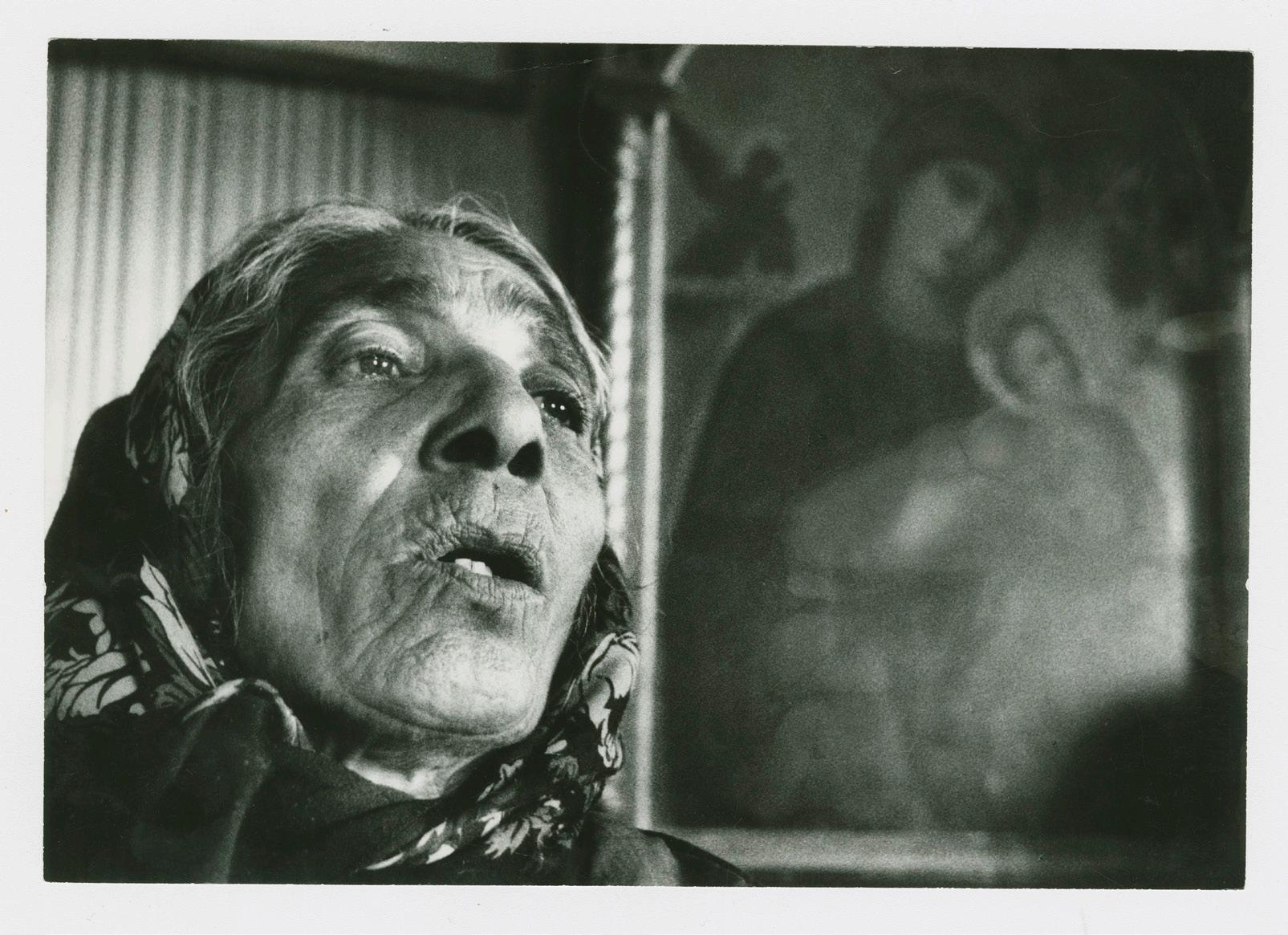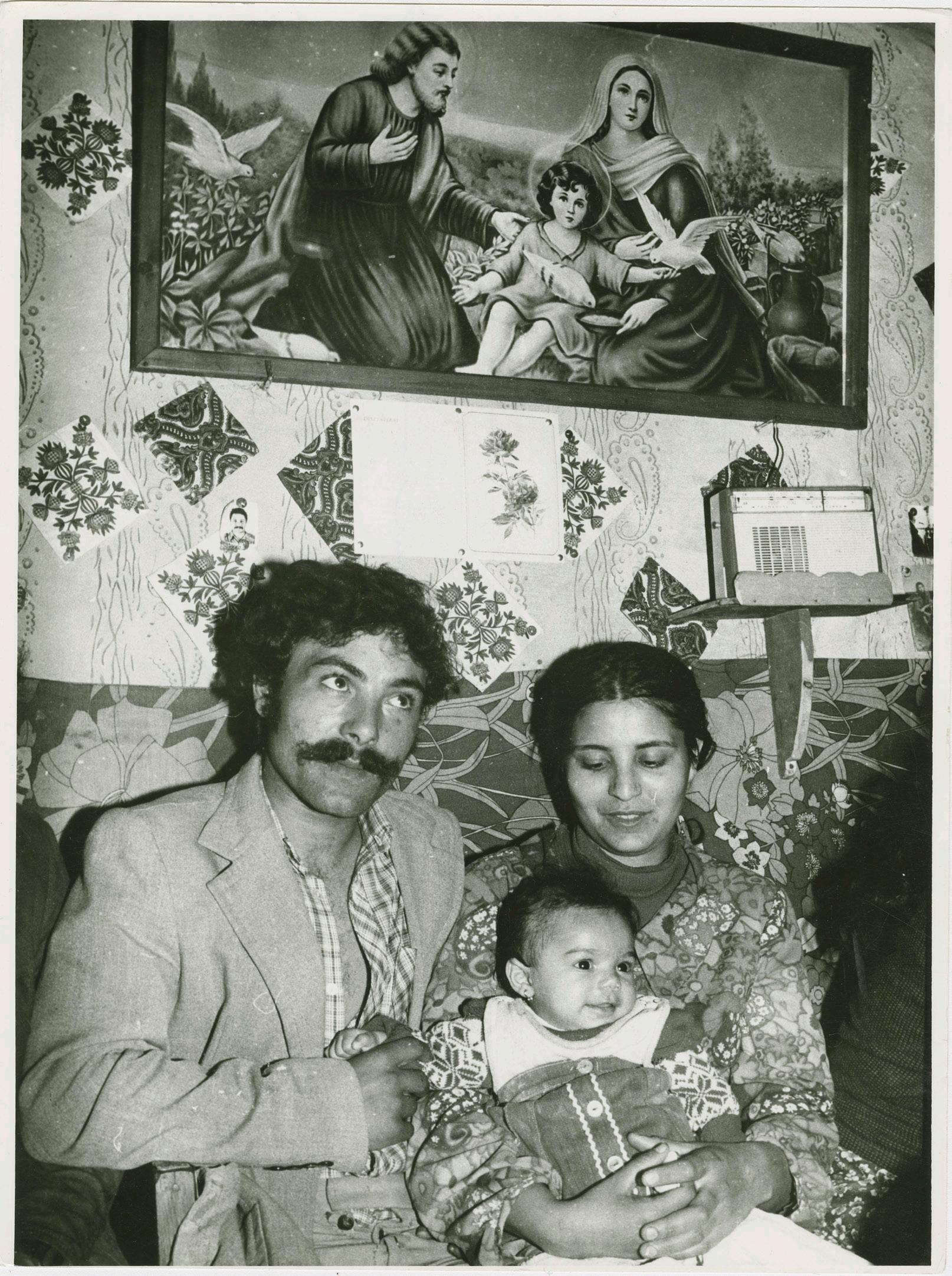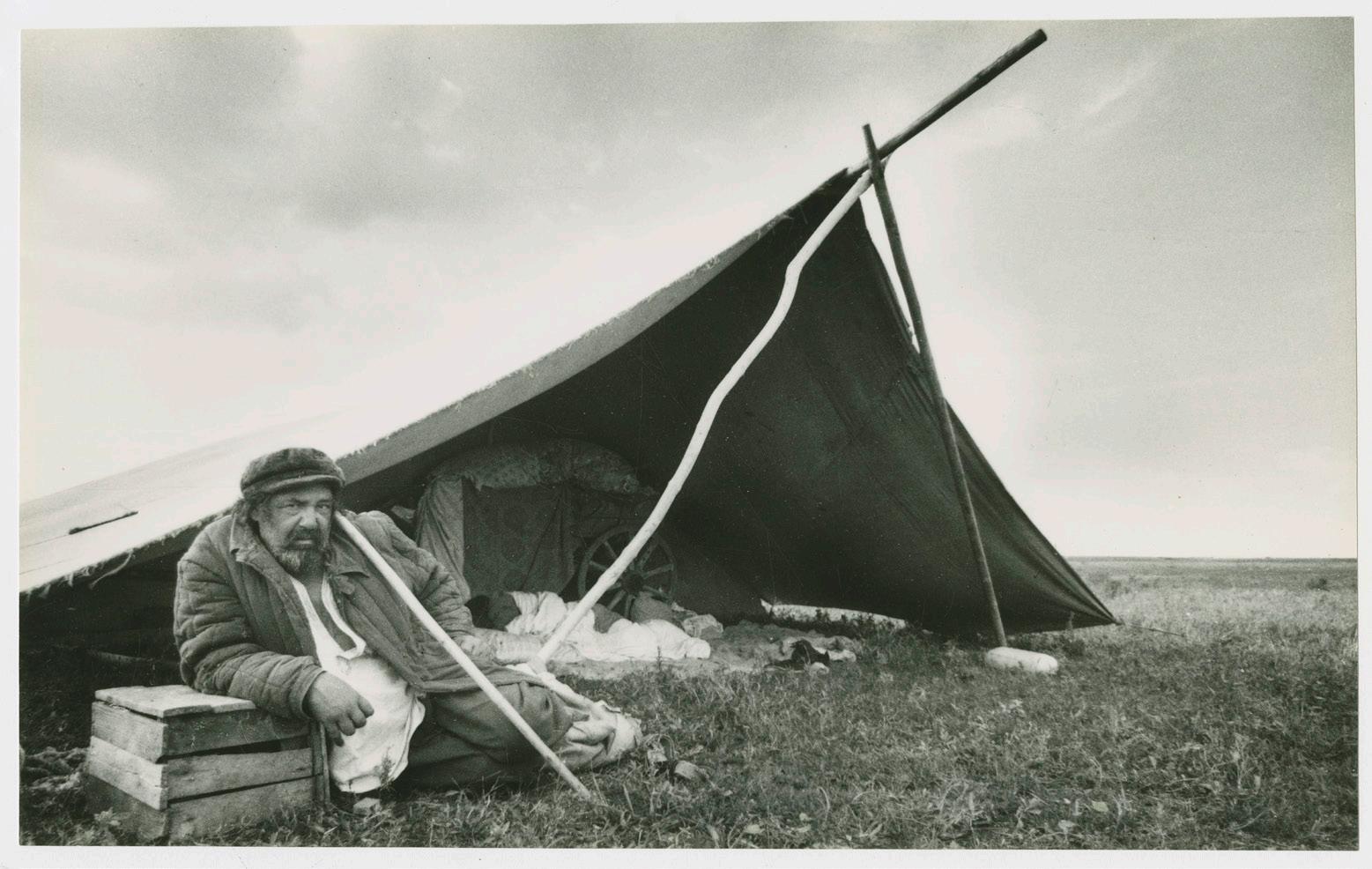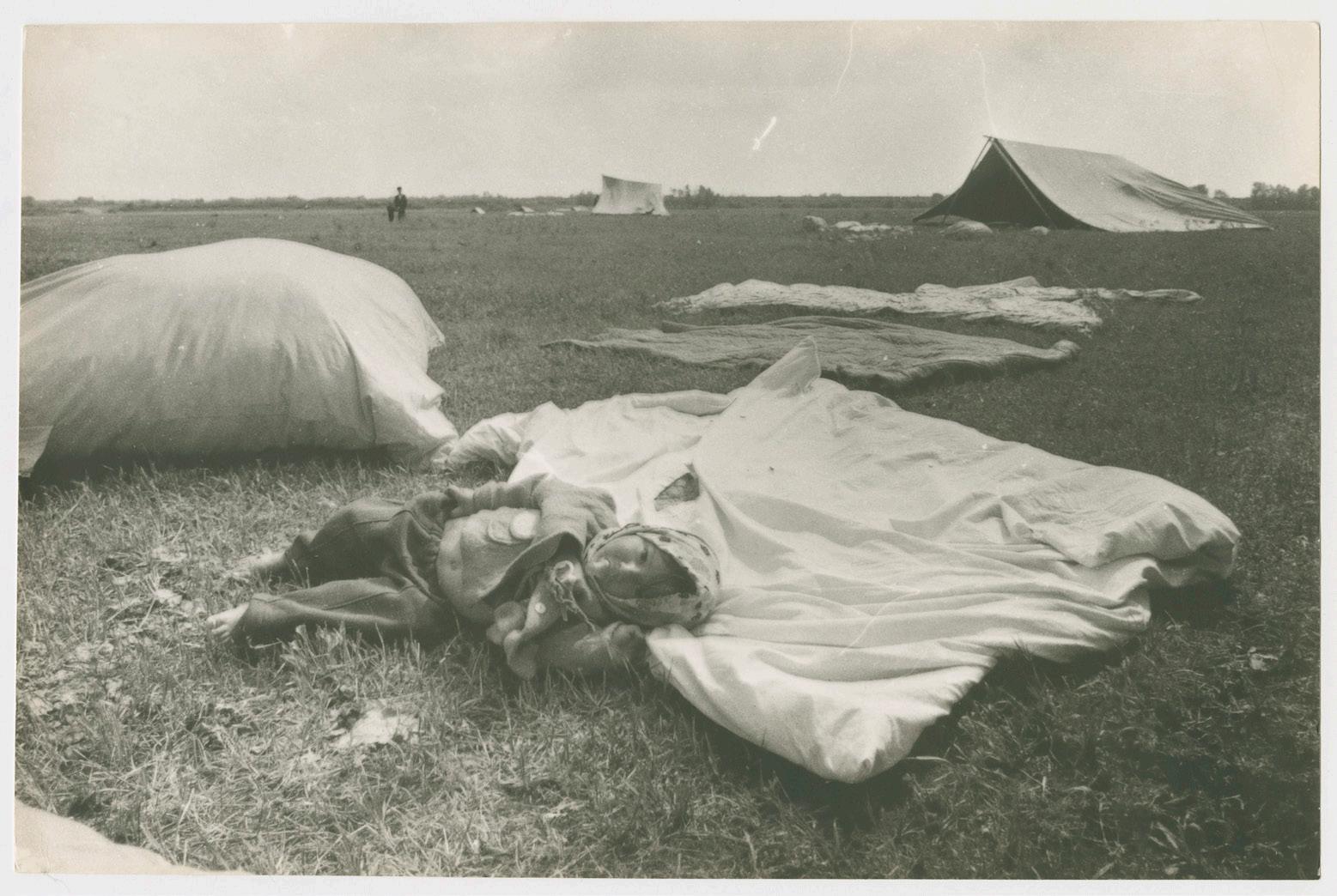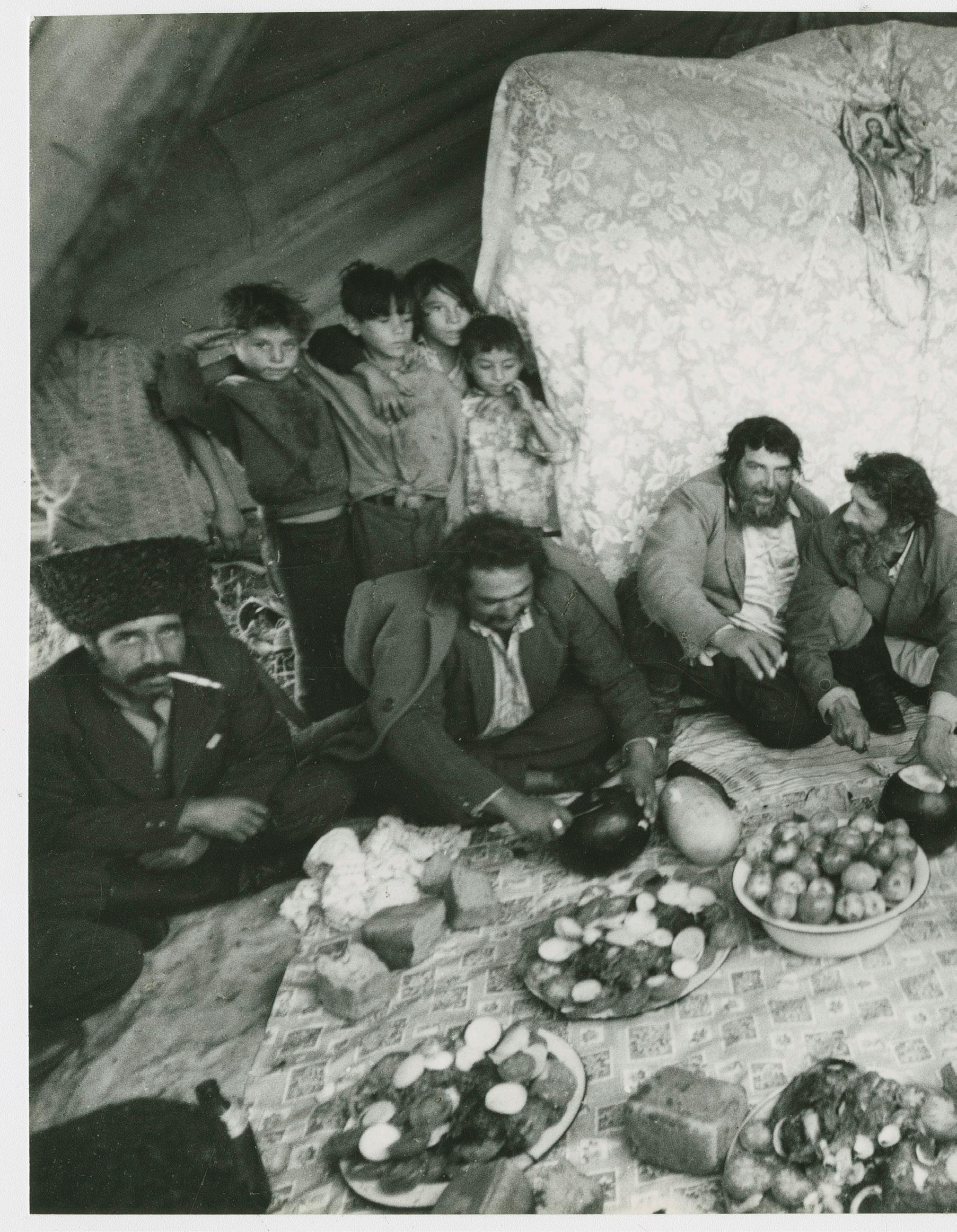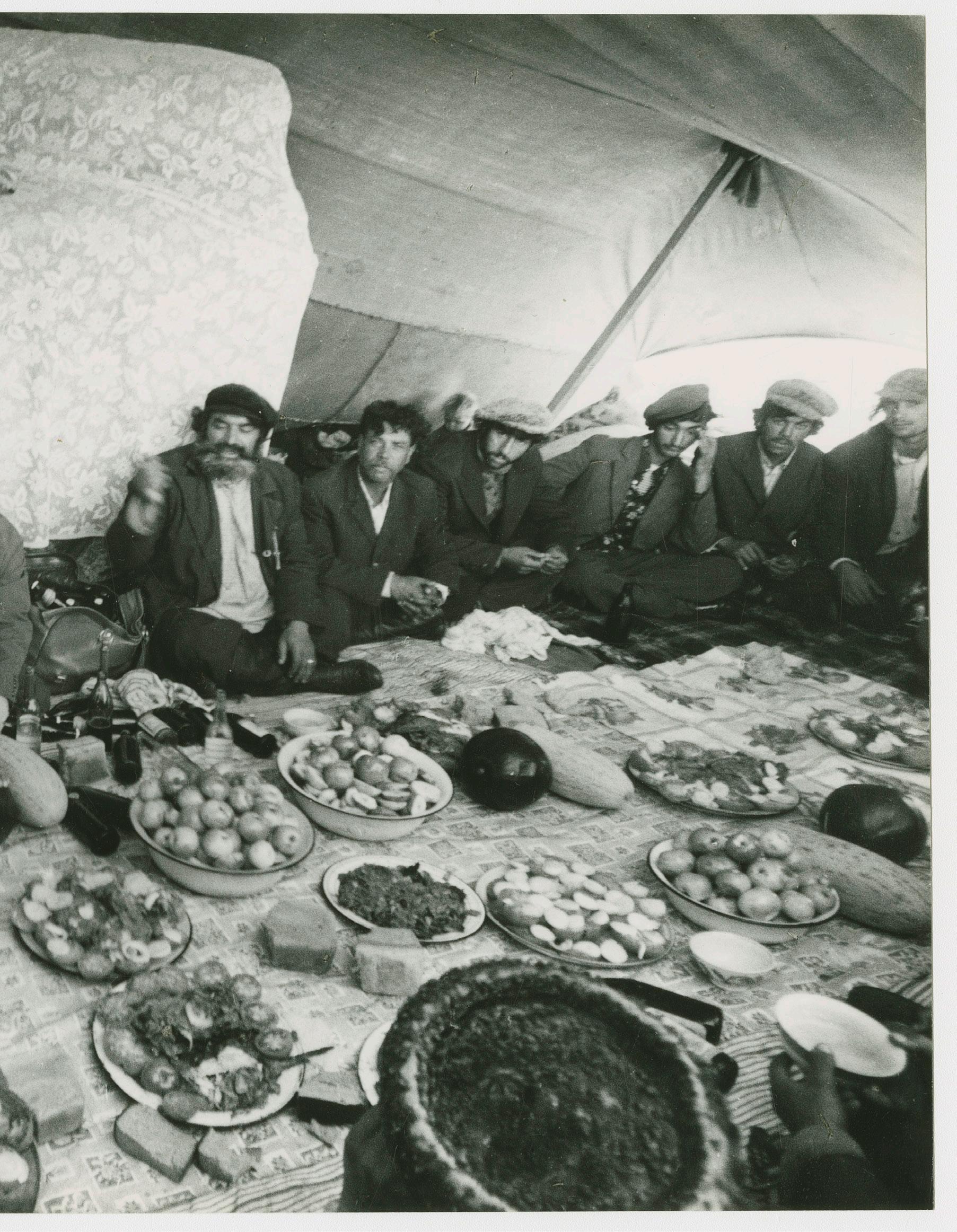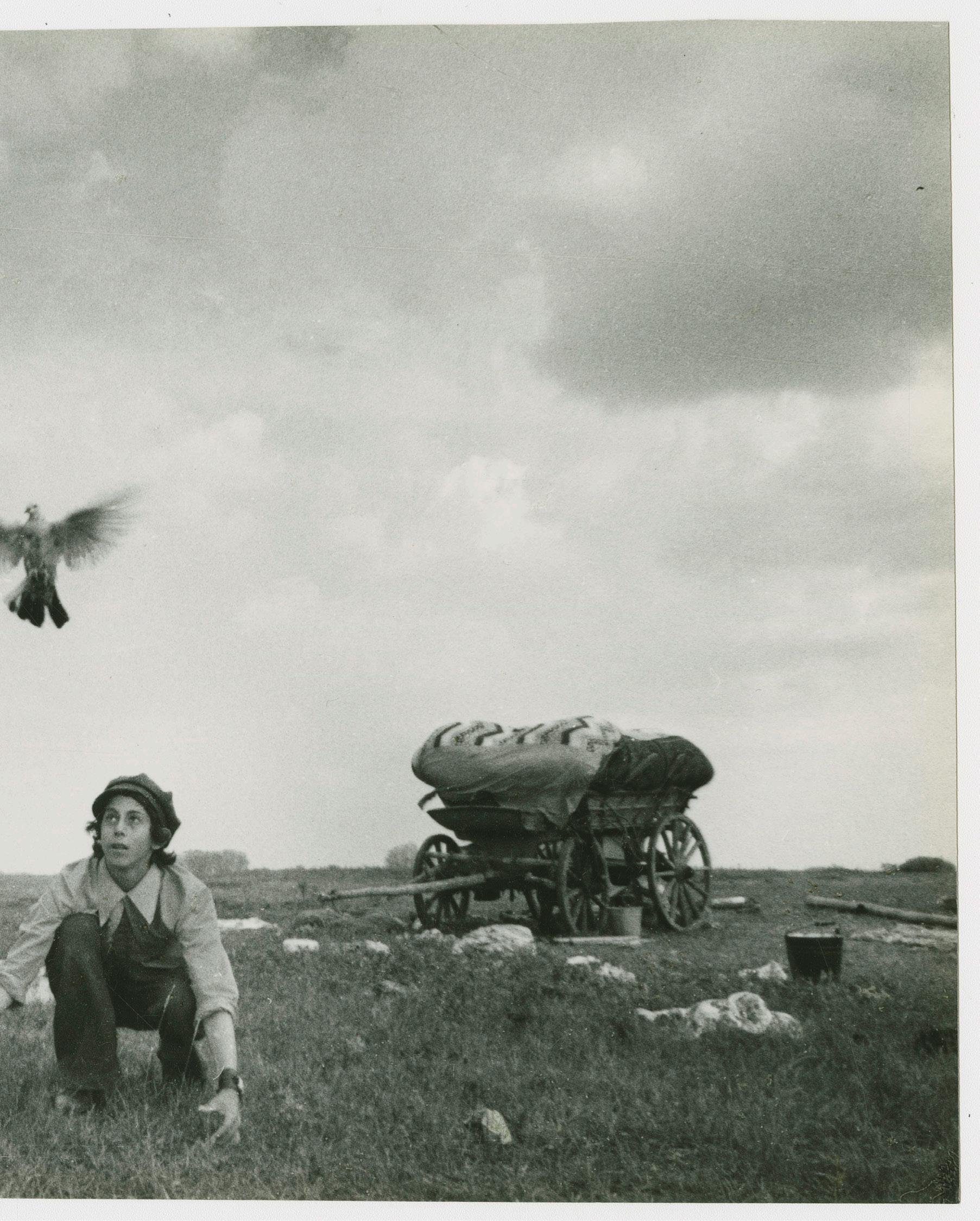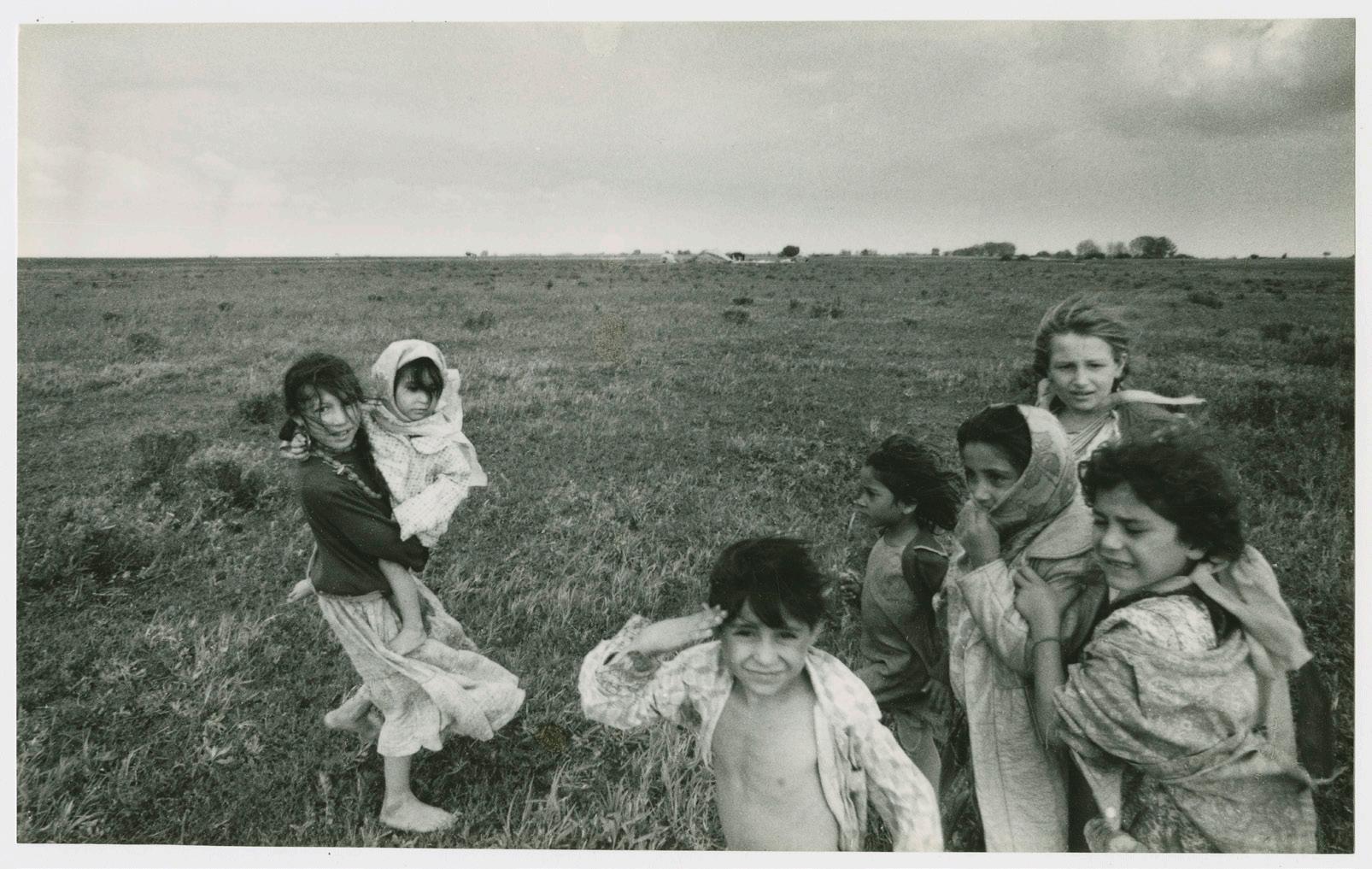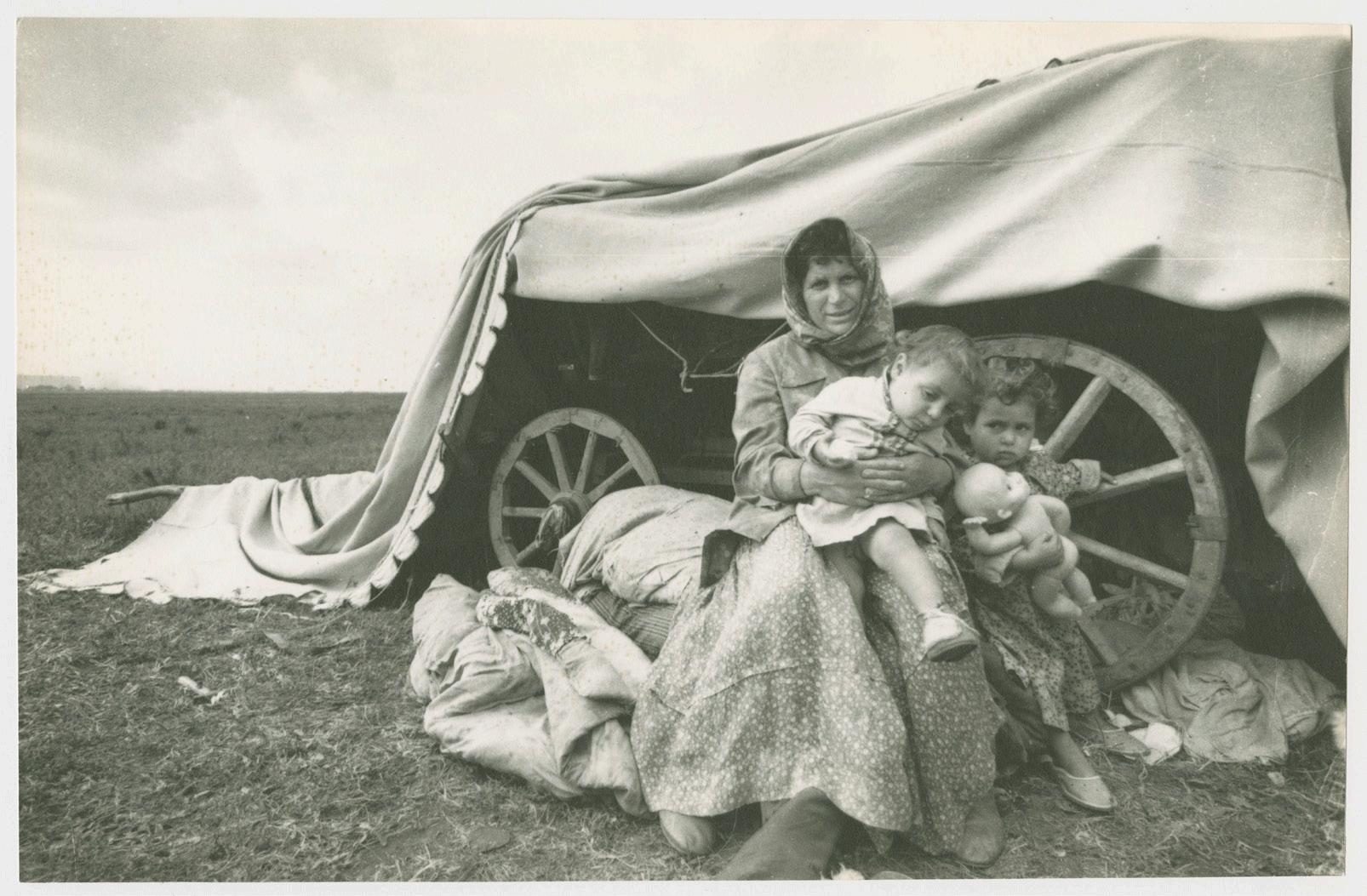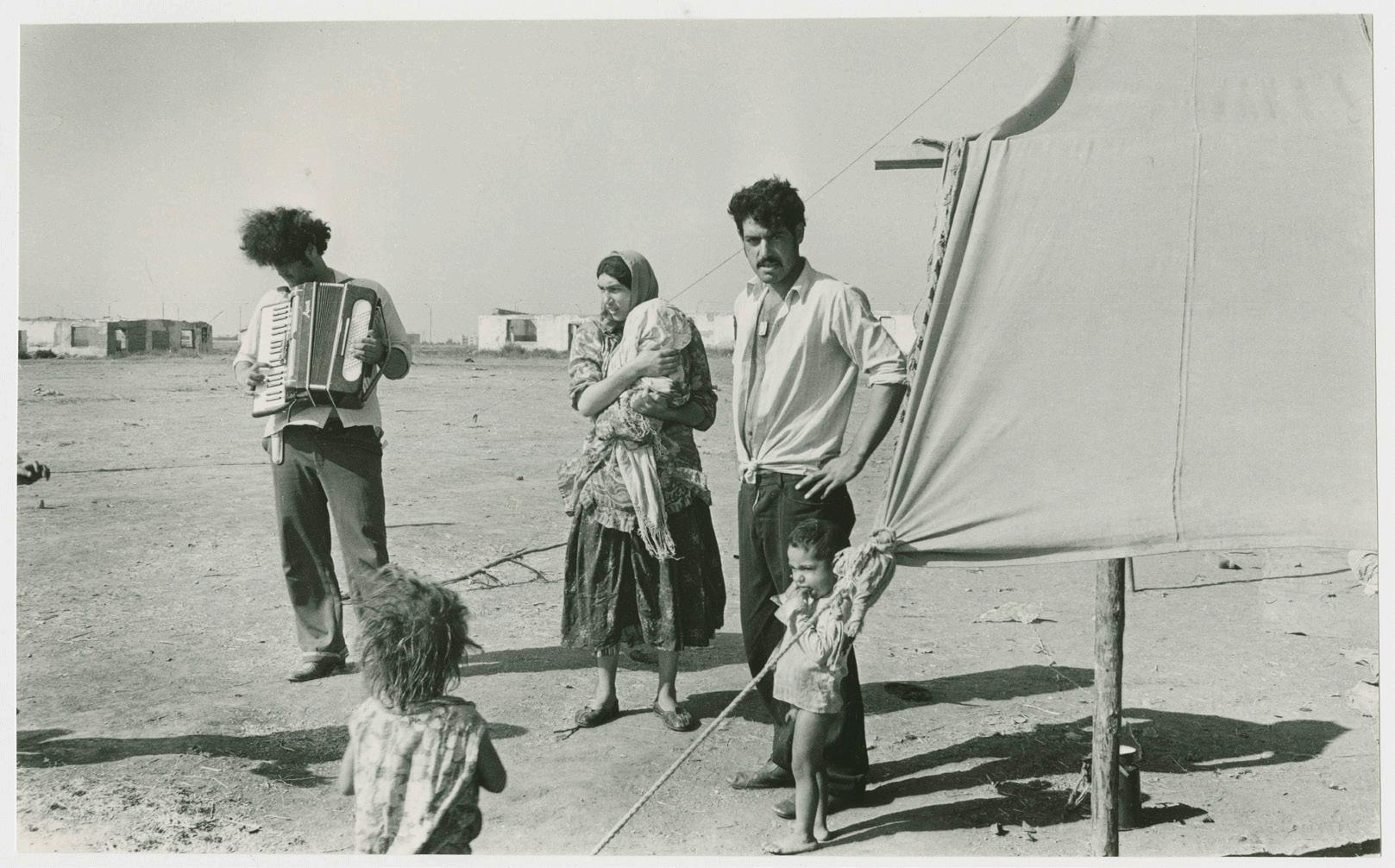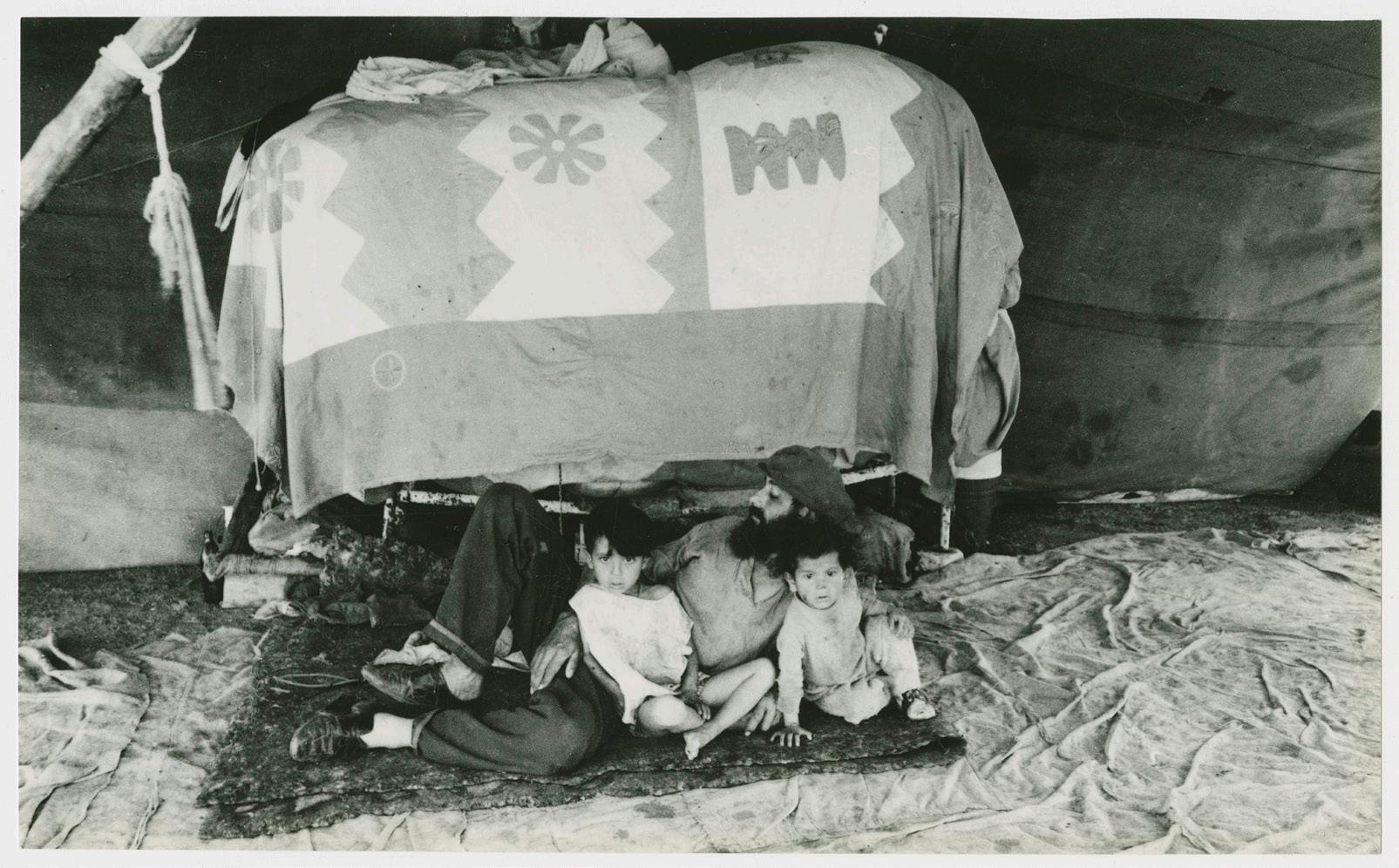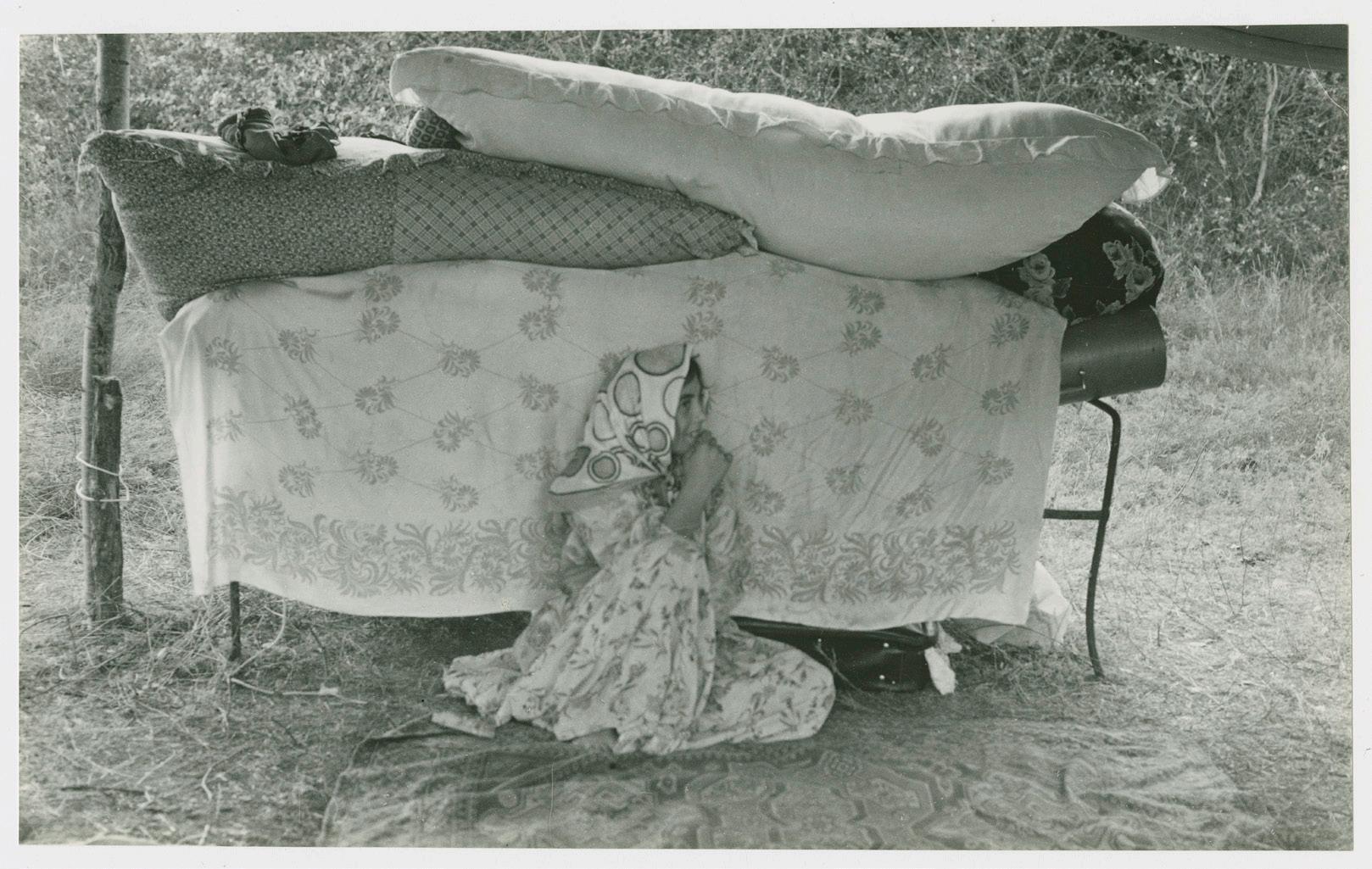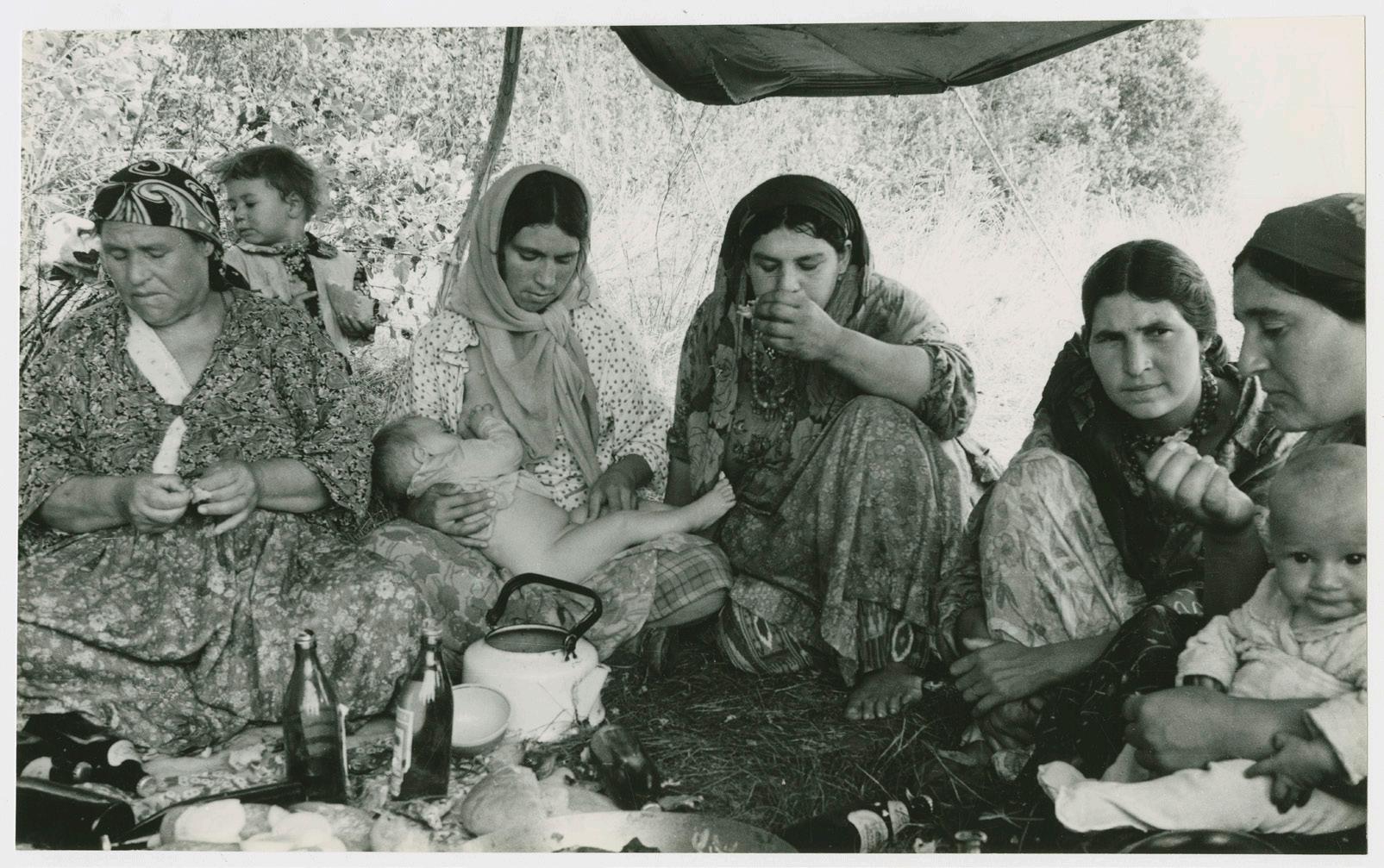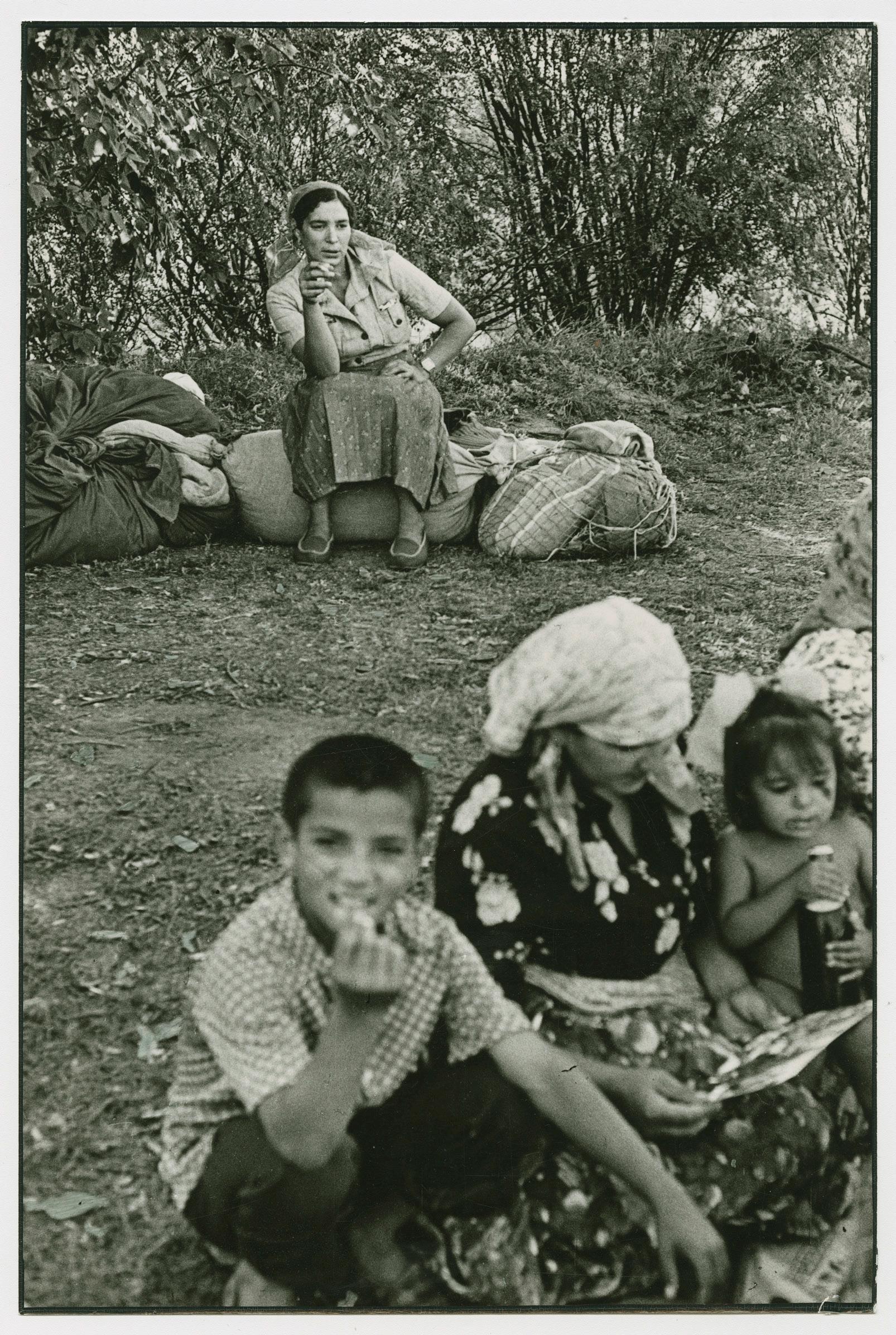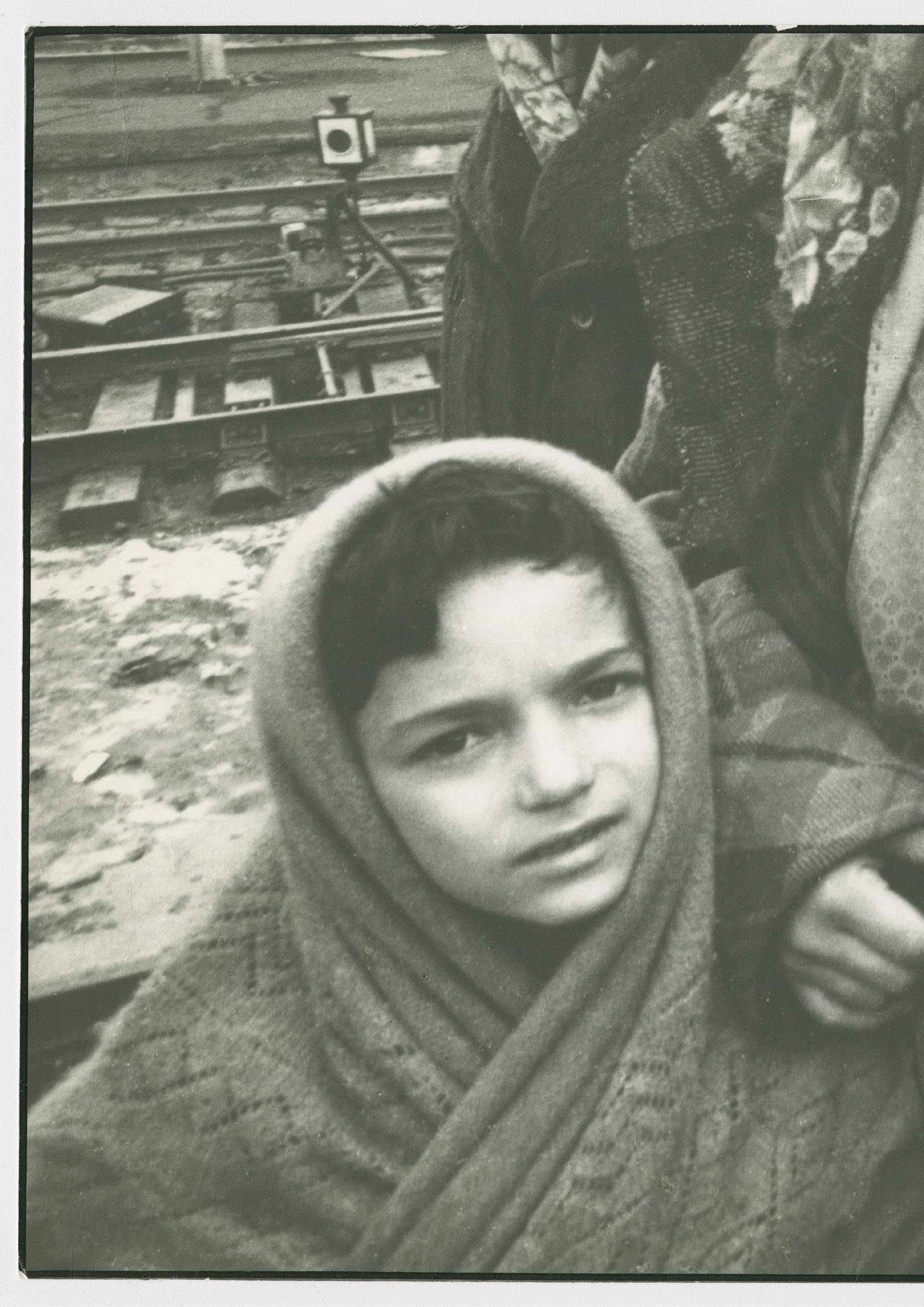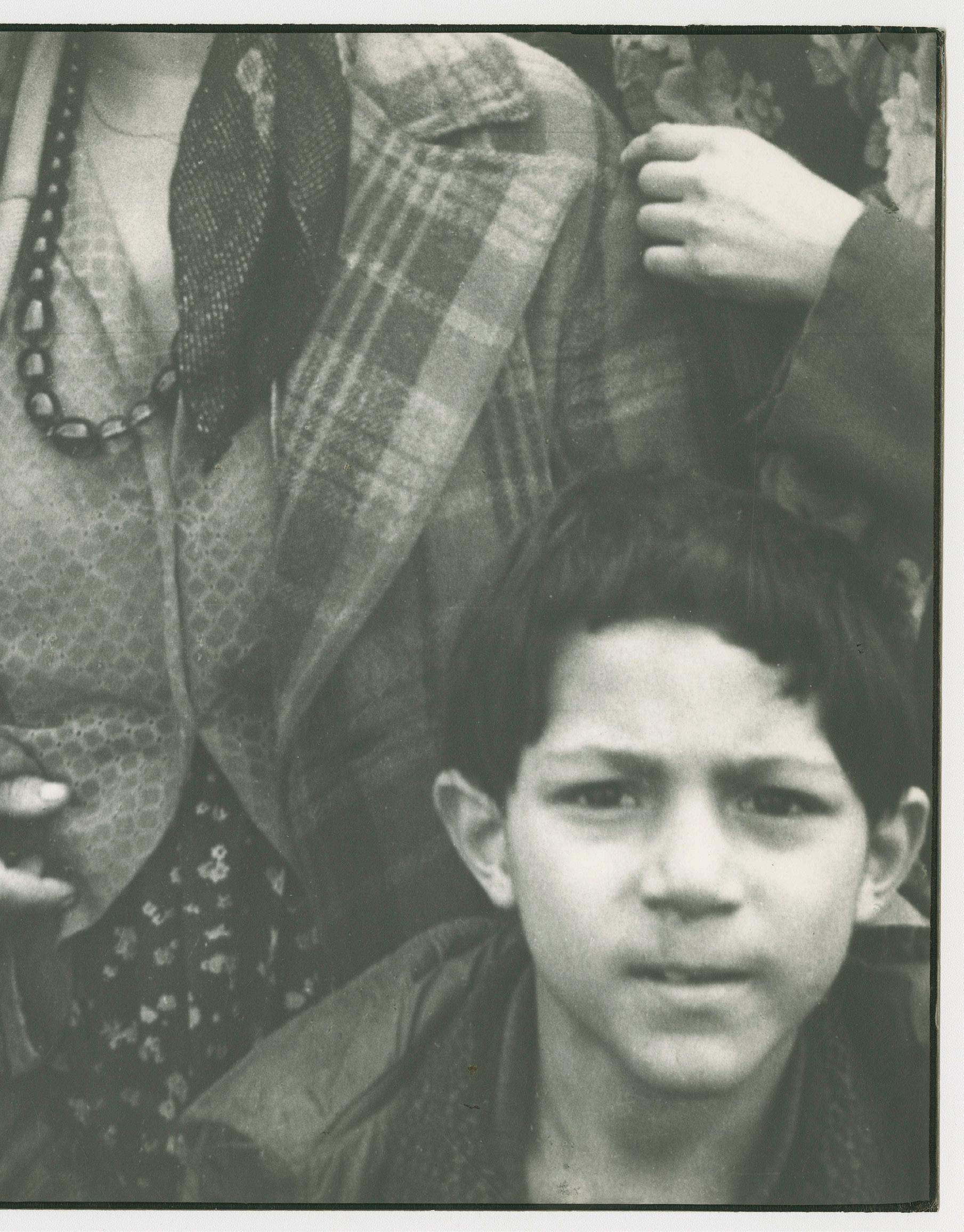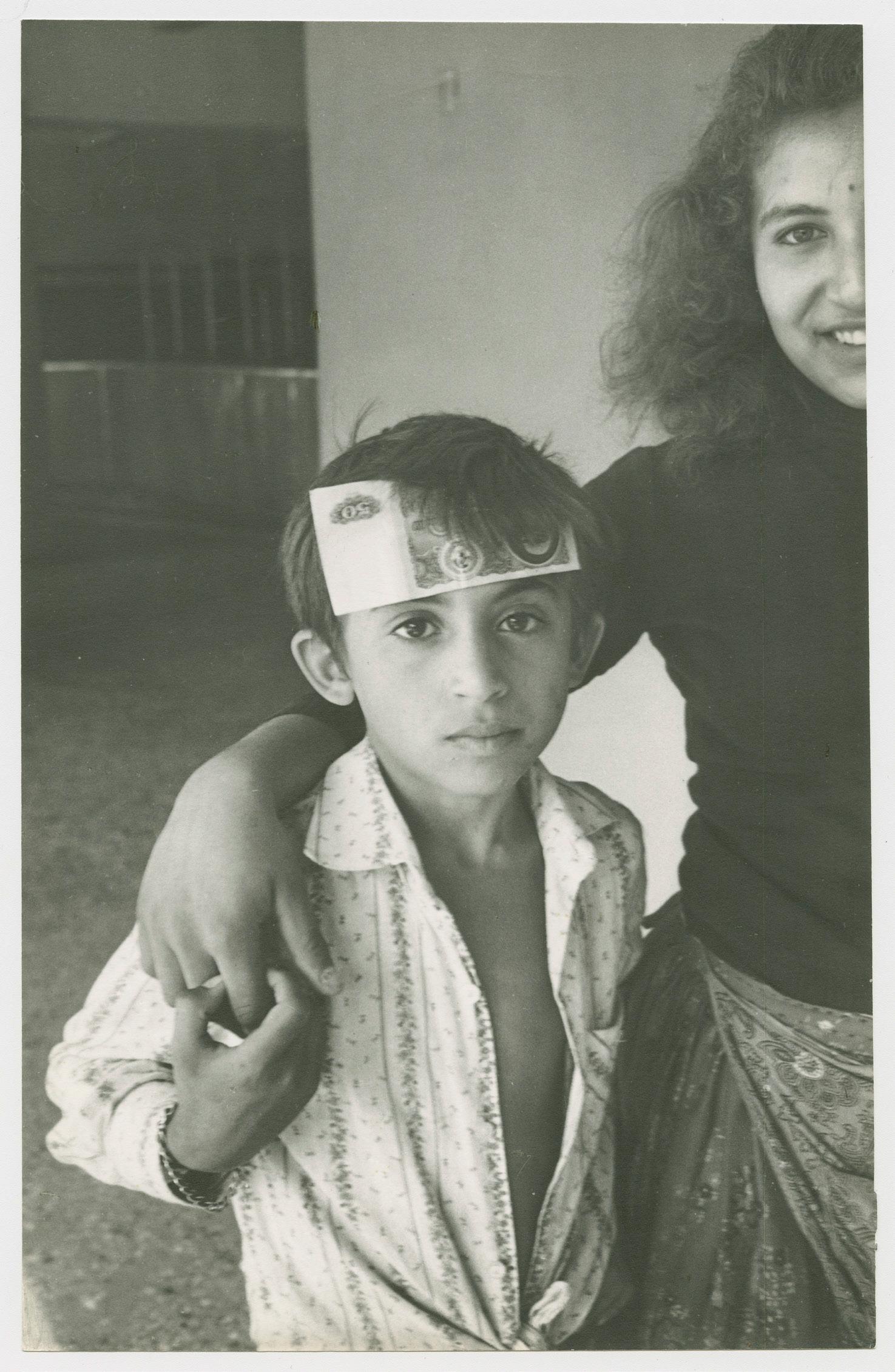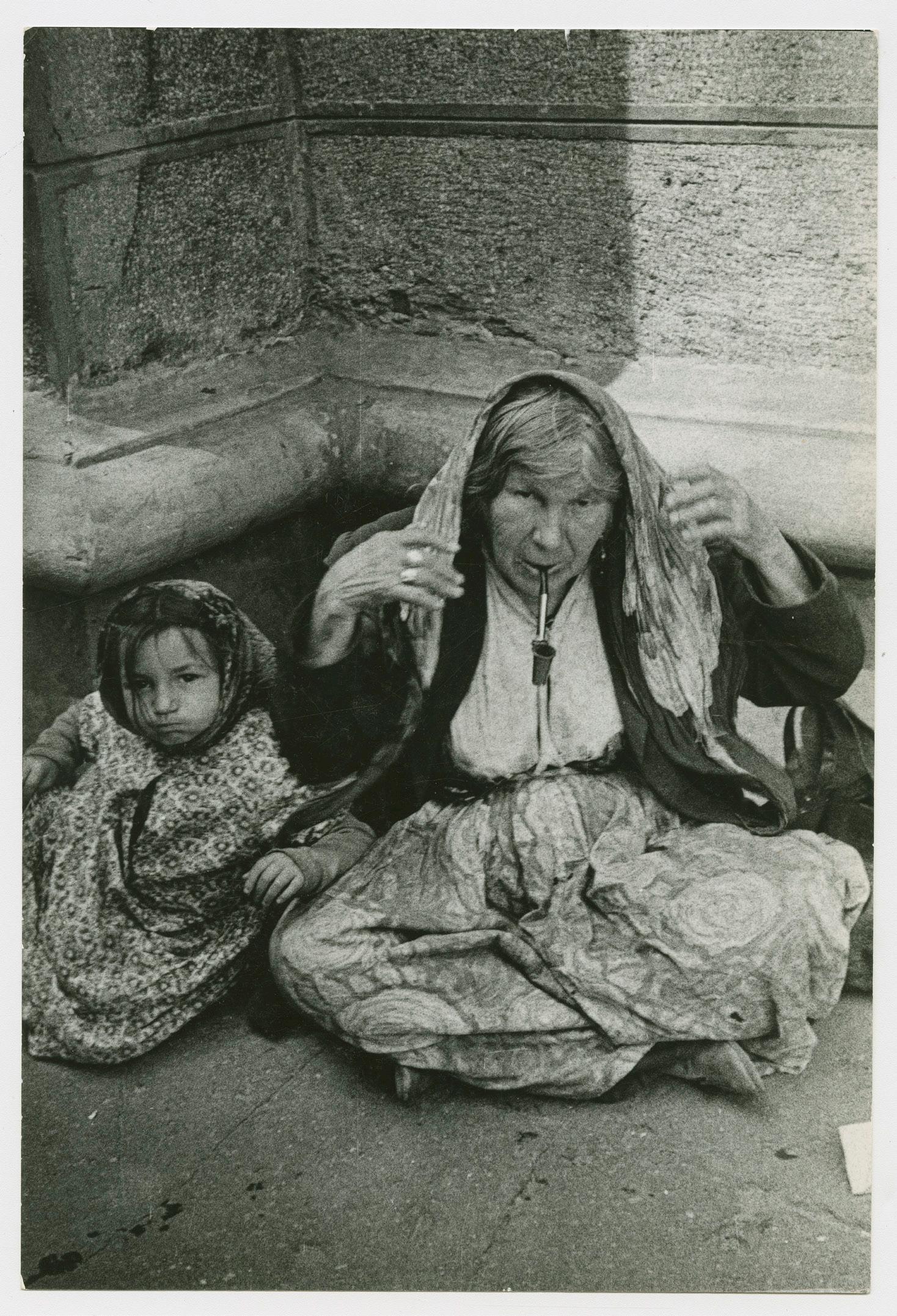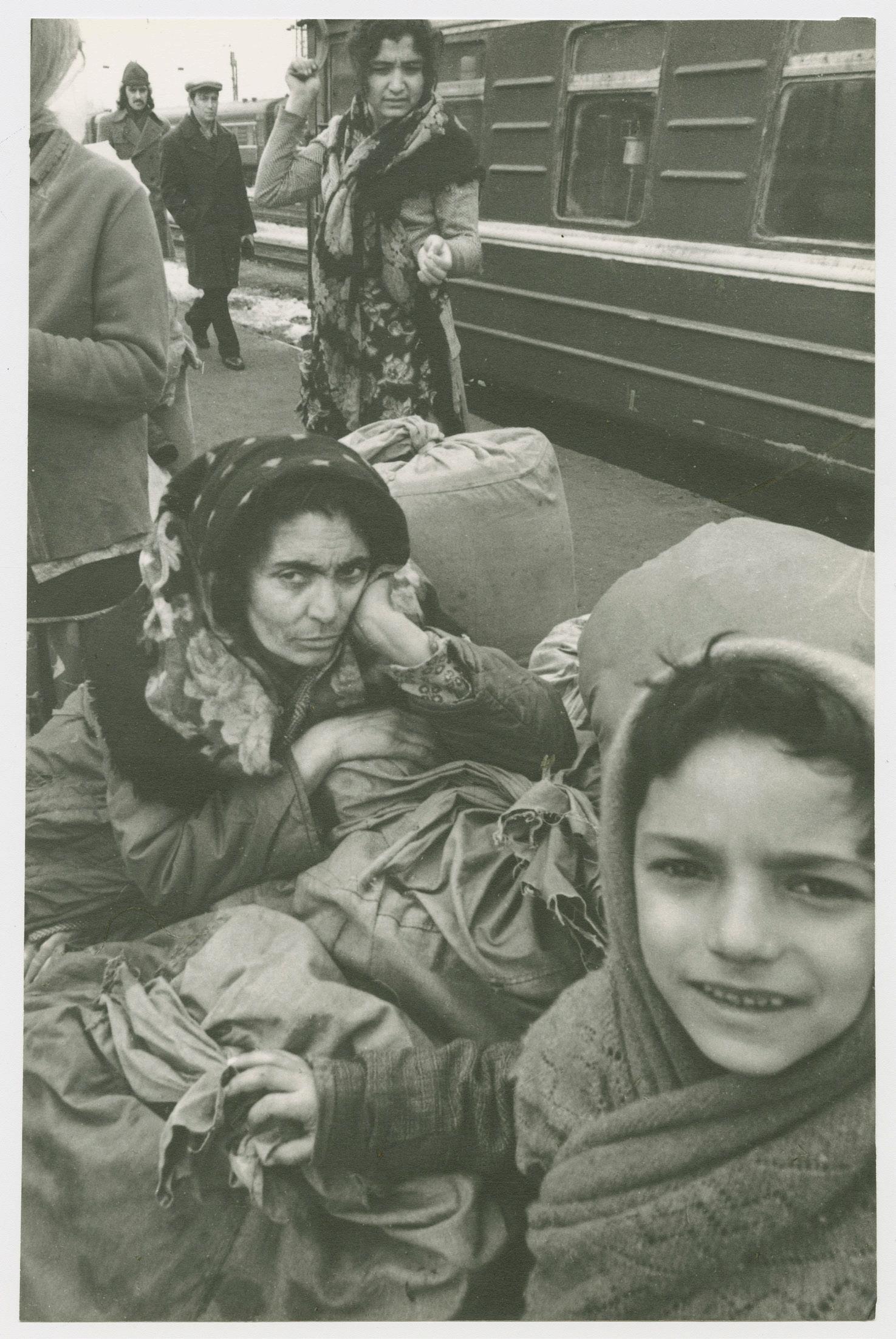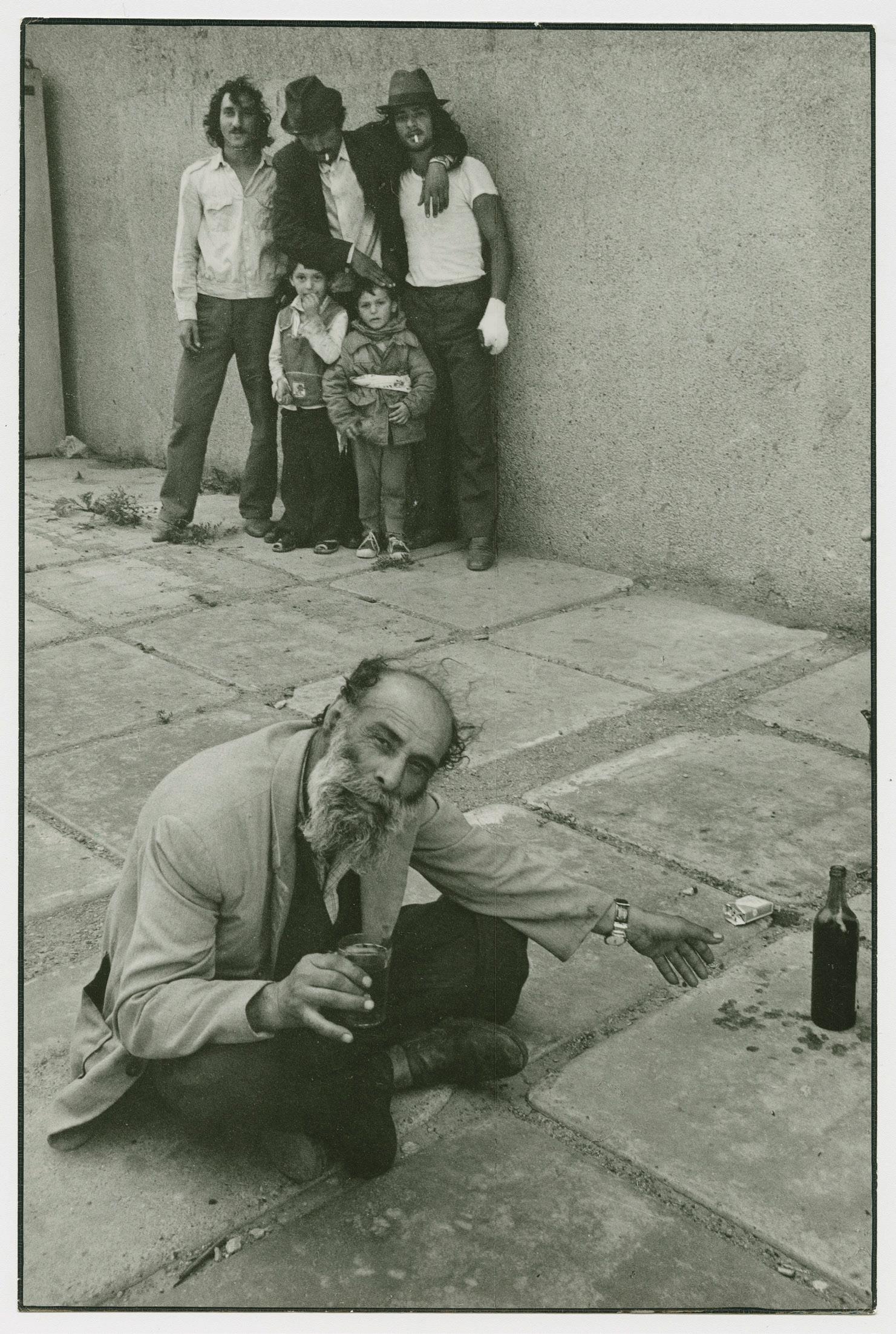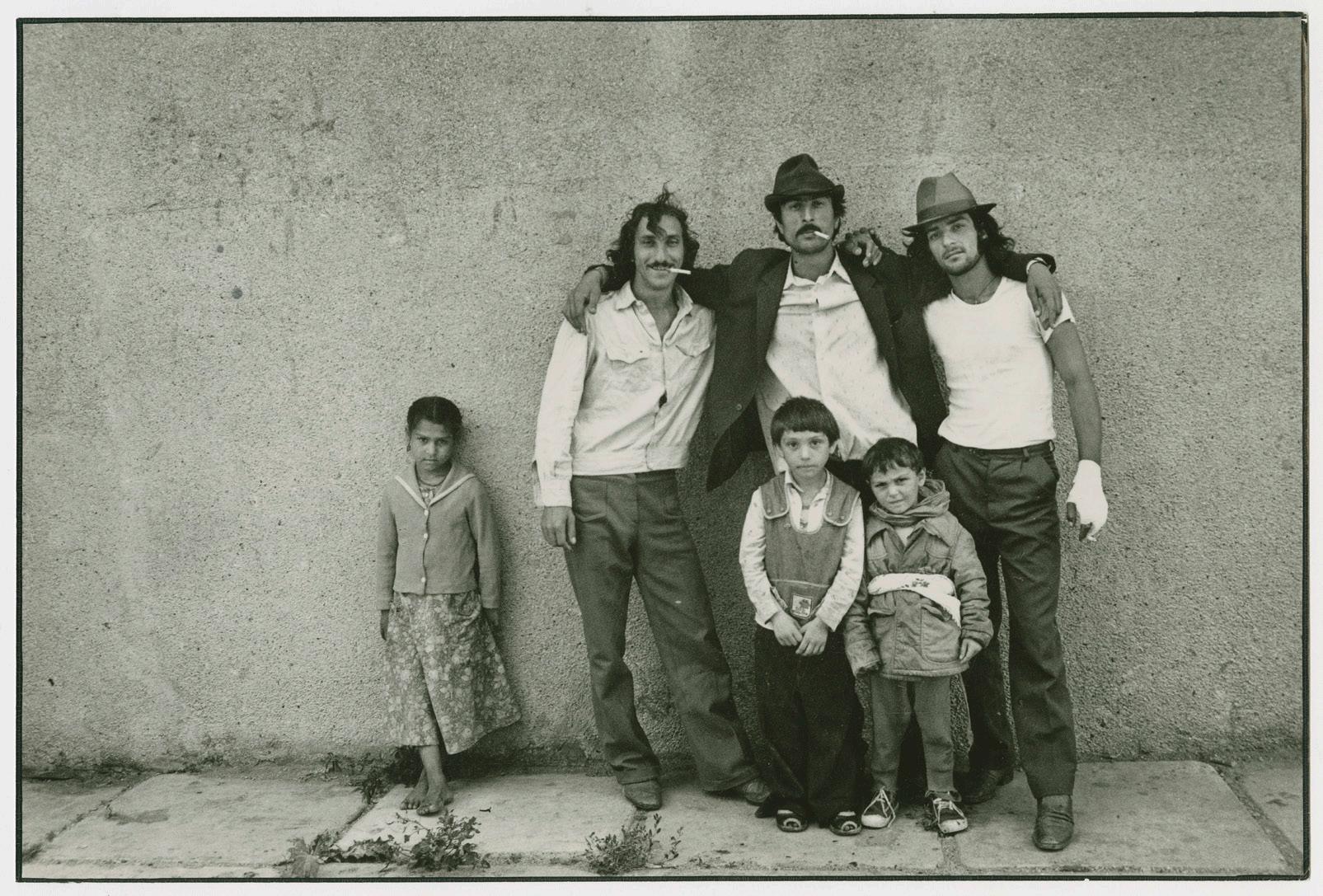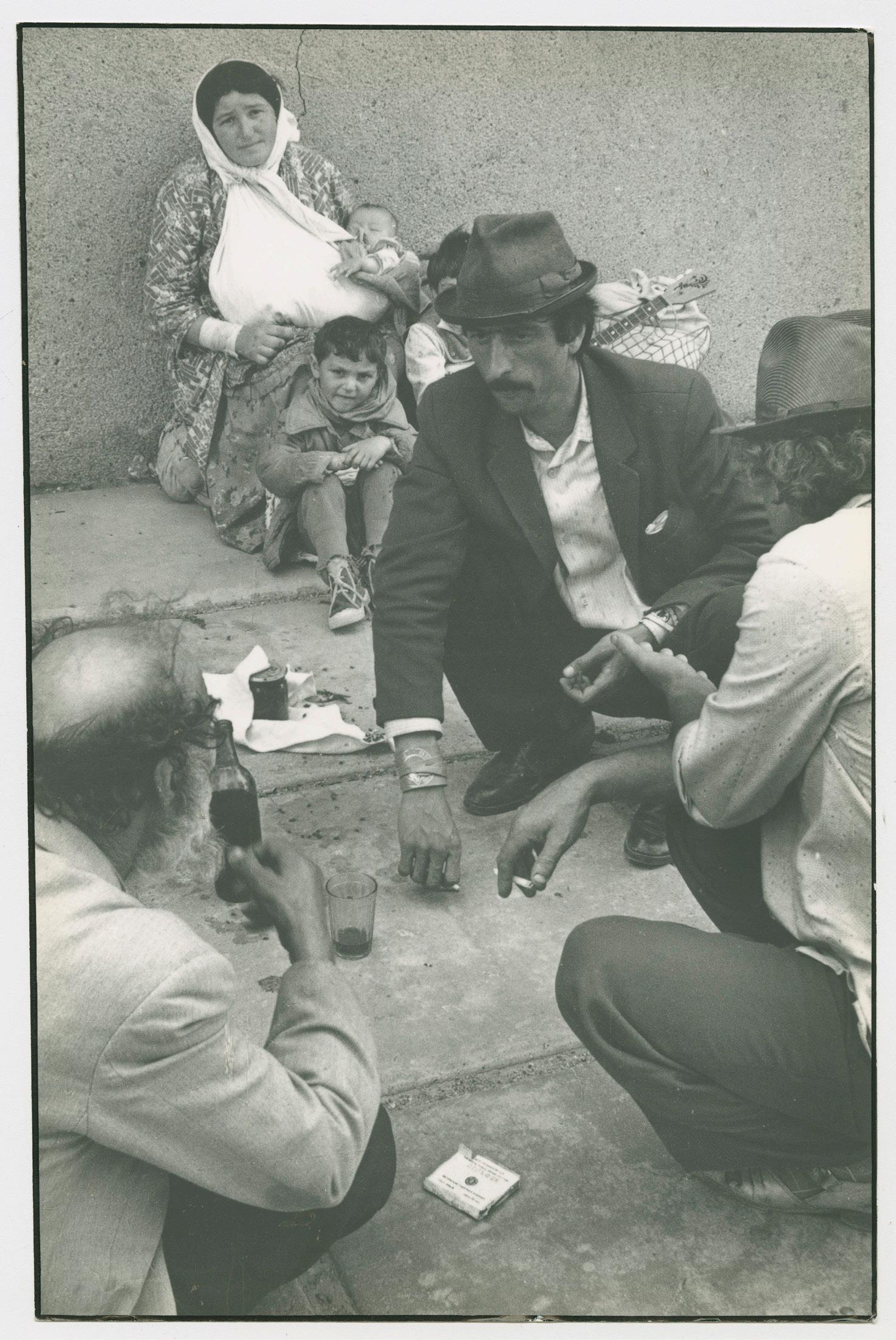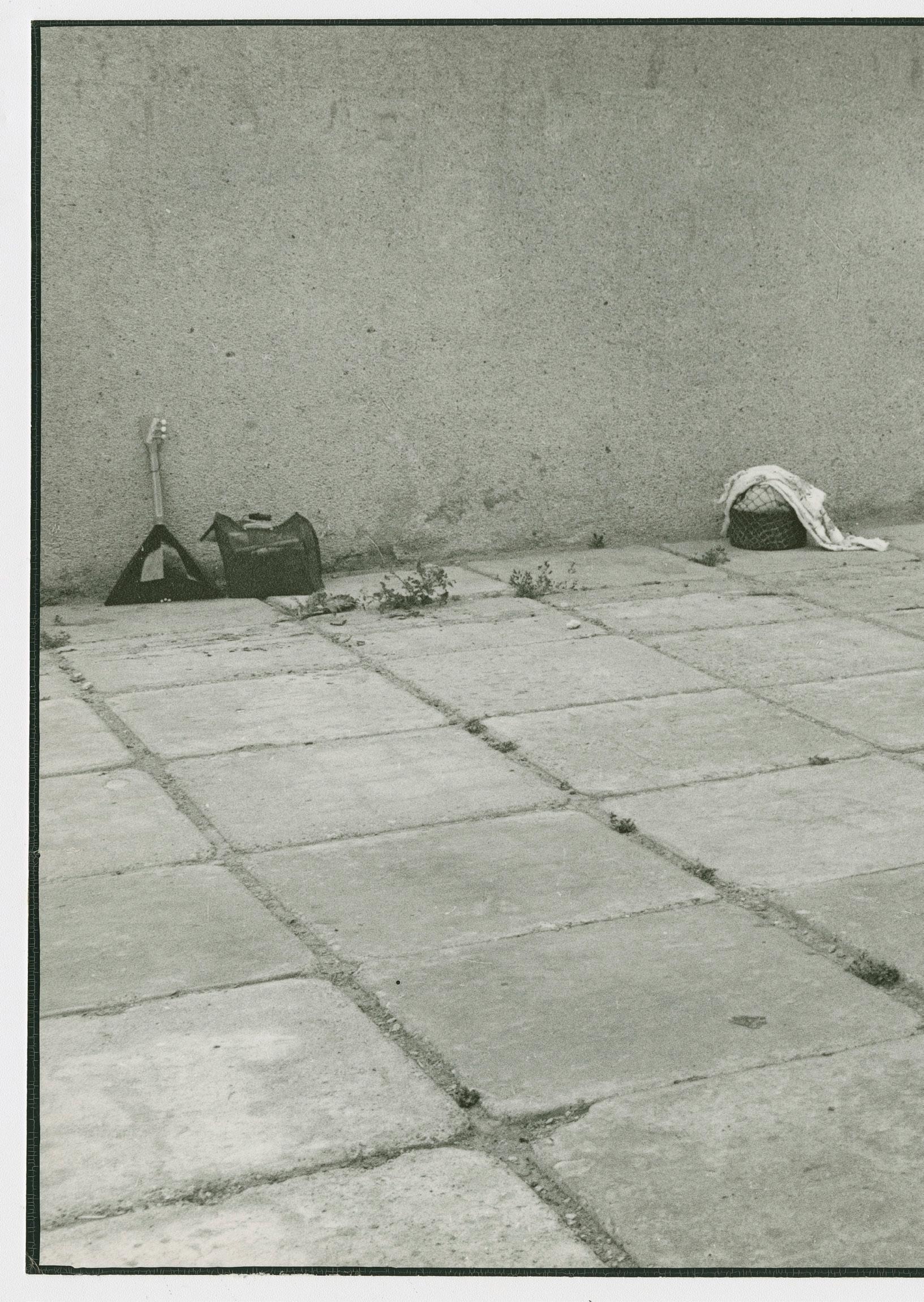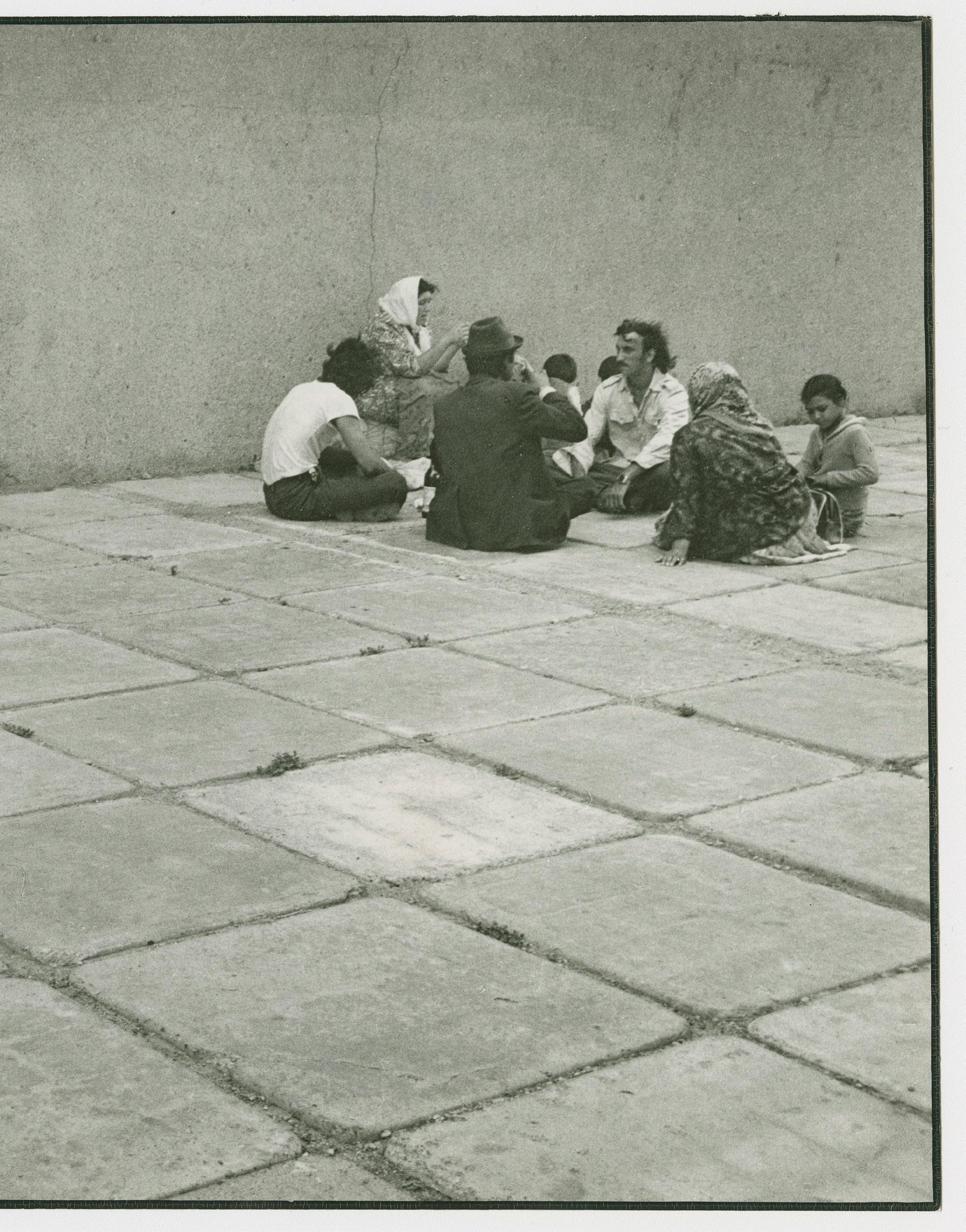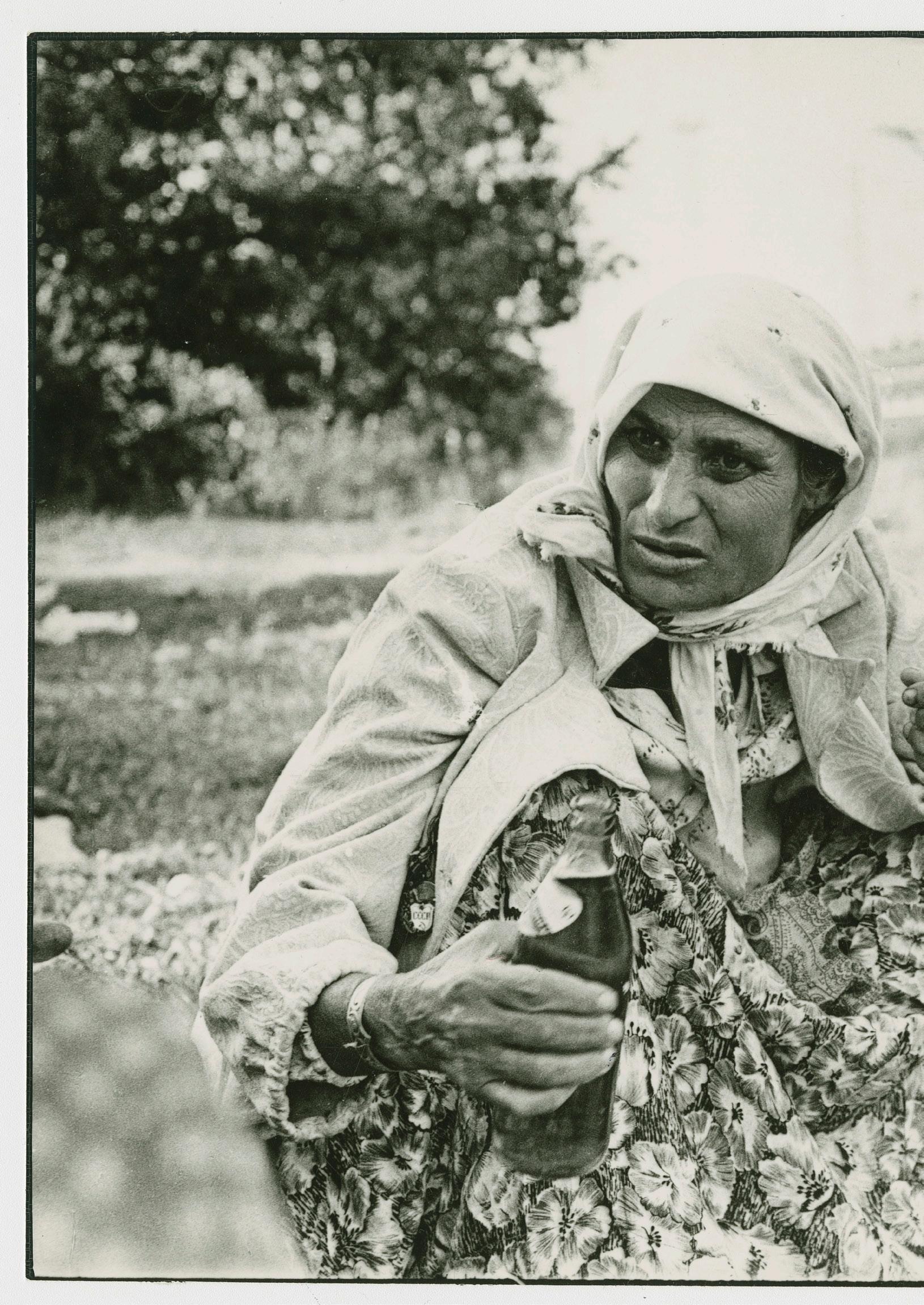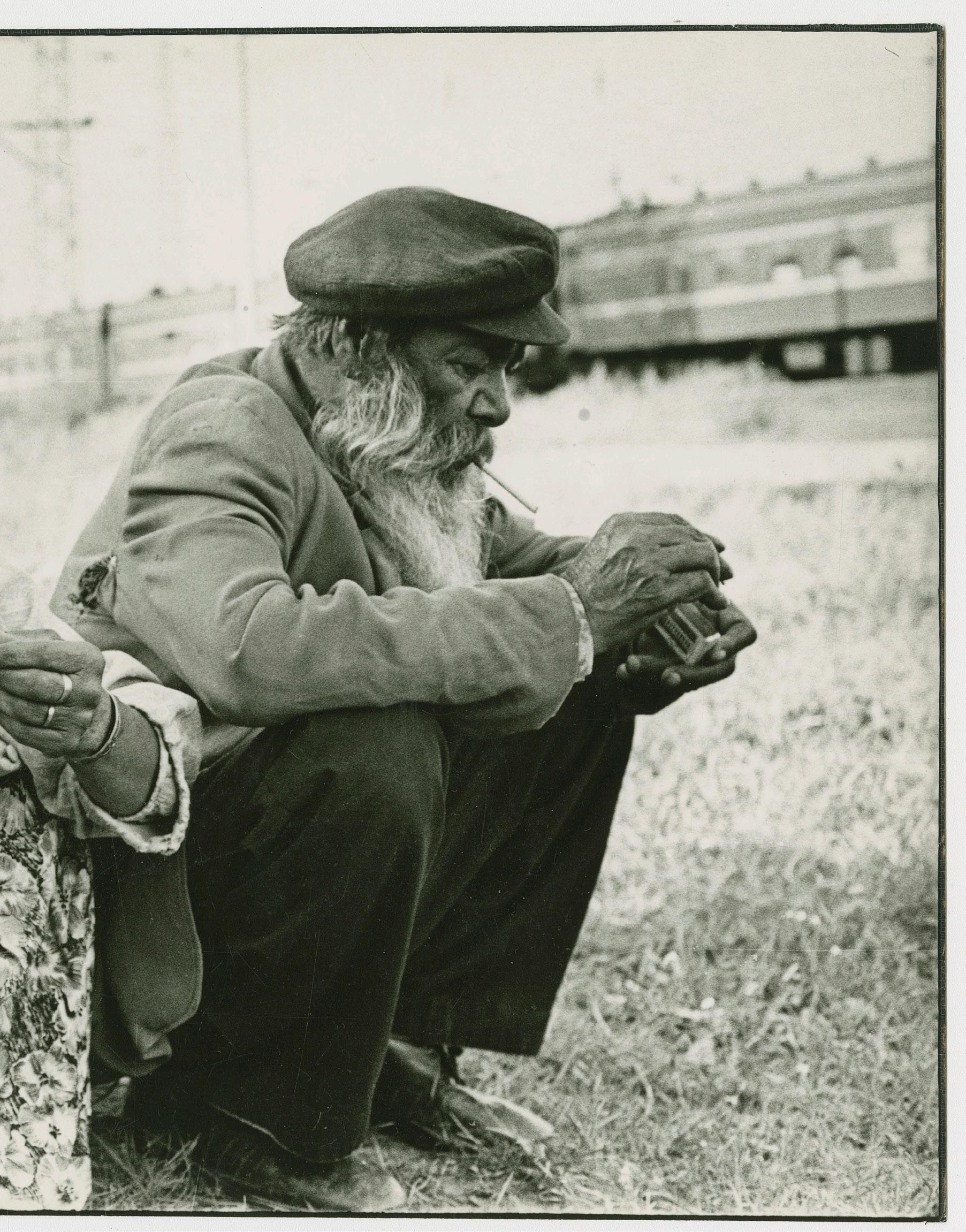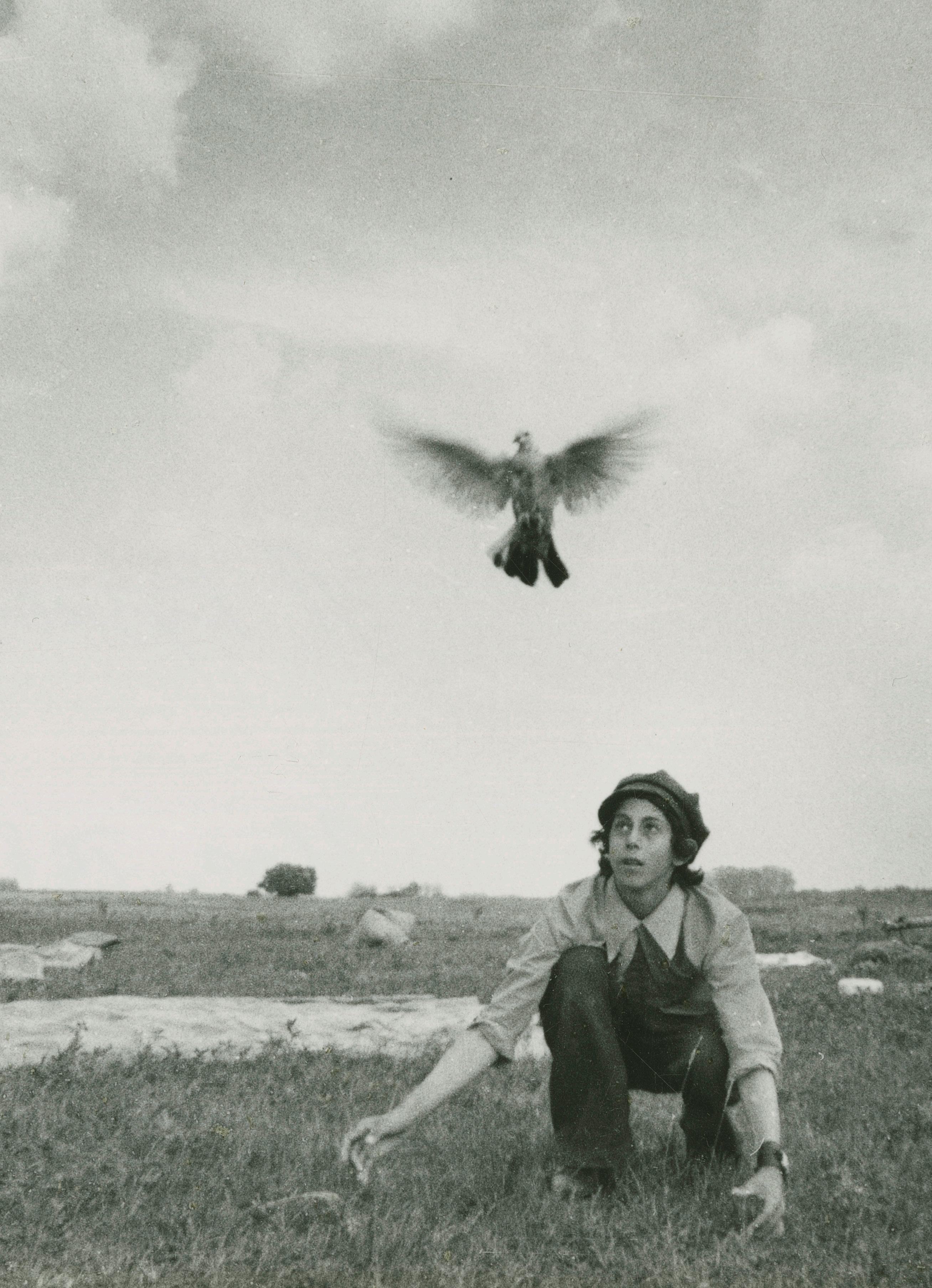Ceija Stojka
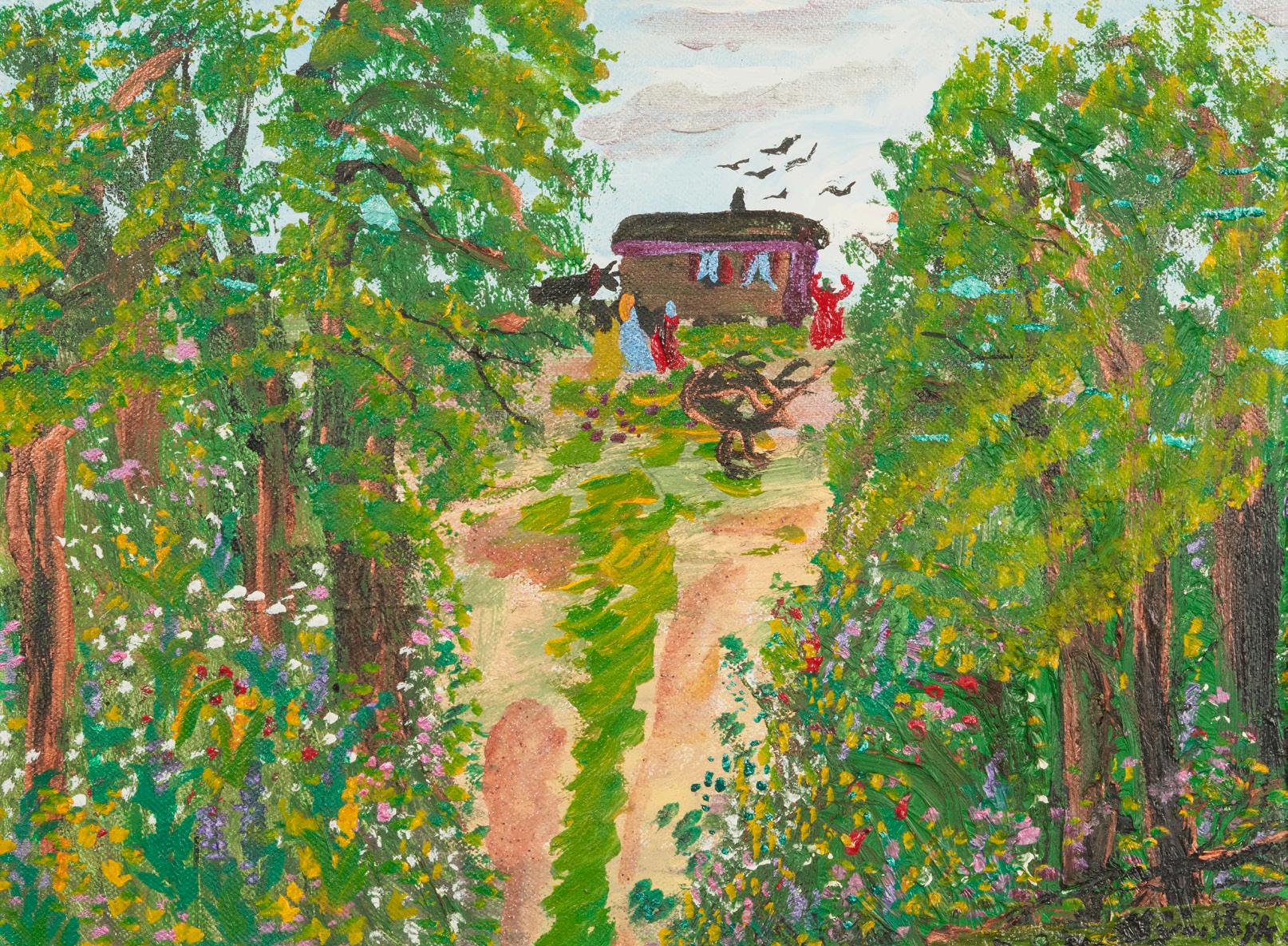
Stojka, Untitled [Wagon/Roma Leben/Roma Life] n.d., acrylic on canvas
Collection Lorely French
In a deep clearing surrounded by a green forest, a Romani wagon, or so-called “wurdon” in Vlax Romany, is in the middle of the picture. A family is doing everyday activities. There are kids in red clothes, an animal is tied to a fence, and a flock of birds are flying overhead. In her early childhood, Stojka lived much of the year in a horse-drawn wagon with her extended family. Her father traded horses and her mother helped make money by fortune telling and selling housewares and crafts. In her memoirs, Stojka talks about how much she enjoyed living in the wagon with her mother, father, and five brothers and sisters.
7
Ceija
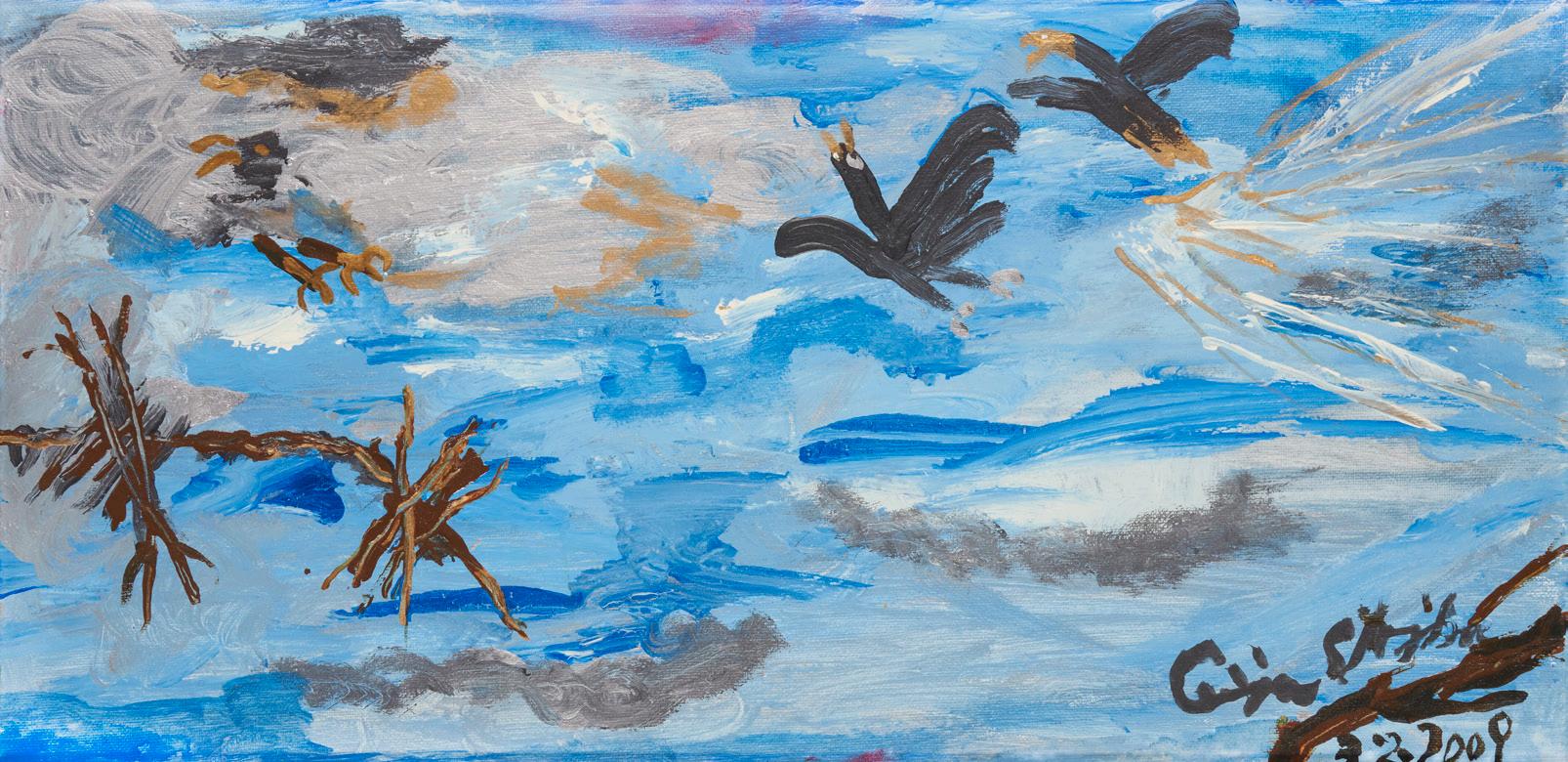 Collection James Draznin
Collection James Draznin
This heaven is a menacing place. Large black birds, most likely the ravens that appear in many of her works, circle in a sky of blue, gray, and yellow, flying toward what seems to be an impending fight with the gray birds on the right. The white cloud is filled with more threatening creatures who hover close to the top of the picture plane, as if intending to take part in another brutal encounter. In the bottom right corner, there’s a tree branch under the artist’s name. This is a nod to a tree that was outside the Bergen-Belsen concentration camp where Stojka was kept. Her mother told her to eat the tree’s leaves and sap to stay alive. Stojka includes this branch along with her signature in almost all her works.
8
of Roma Life
Ceija Stoka and
Scenes
Ceija Stojka, Der Himmel [Heaven] 2009, mixed media on canvas
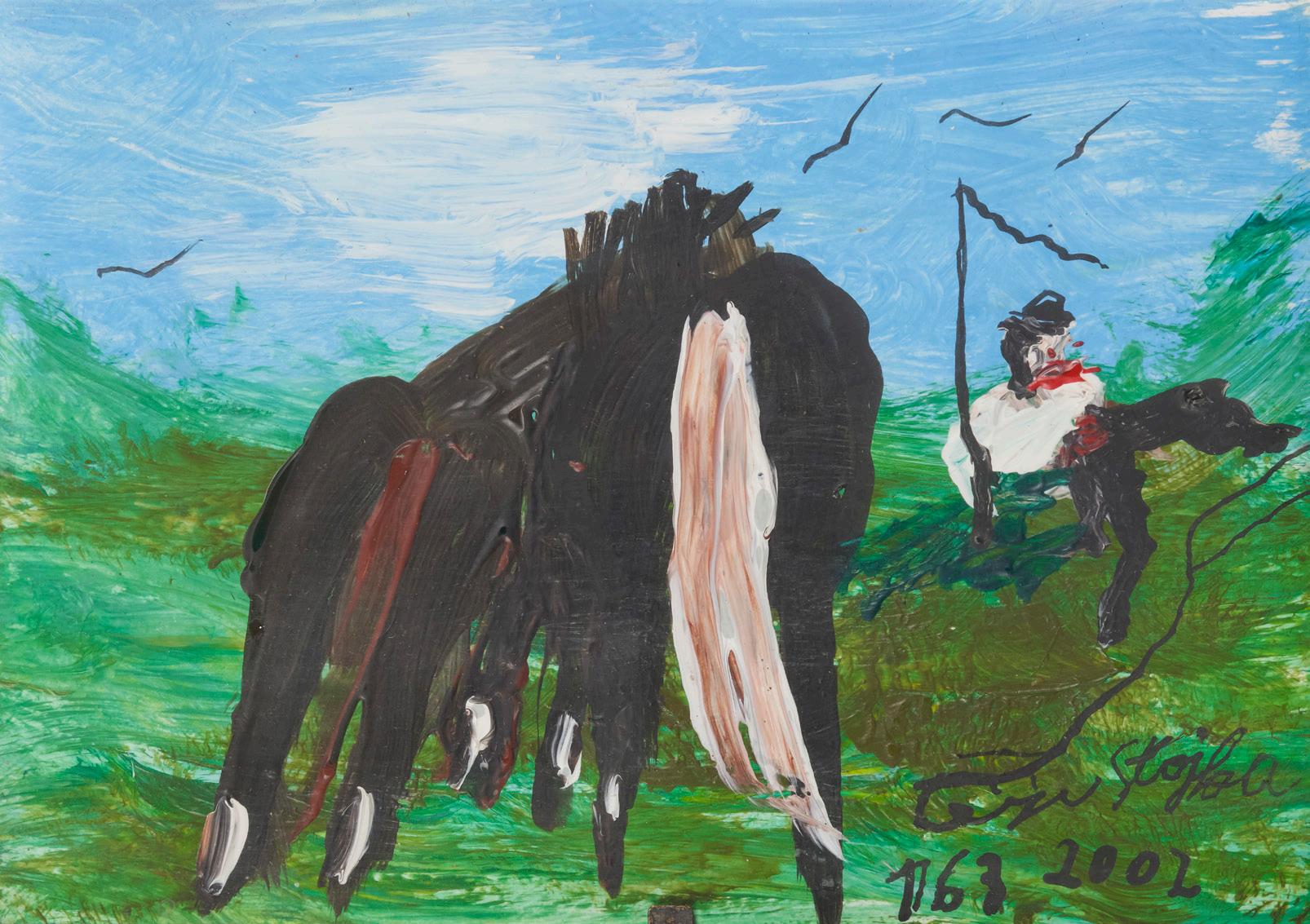
Collection Michaela Grobbel
Ceija Stojka was very close to her father Karl Wackar Horvath. Like many Romani men of the Lovara group, Horvath supported his family by trading horses before the advent of National Socialism. In this painting, we see two horses from behind, their tails and hooves bright with color. Her father is shown on the right, sitting in tall grass. His death in 1942 at Schloss Hartheim Euthanasia Center in Upper Austria, after being sent to different camps, haunted the artist for her whole life.
9
Ceija Stoka
Ceija Stojka, Untitled [Ceija Stojka’s Father and Two Horses] n.d., acrylic on cardstock
Ceija Stojka, Die Rappen
[Die Raben/The Raven]
n.d., acrylic on cardstock
Collection Michaela Grobbel
In translation, the text reads: The Ravens / They flew too late to God / To (bring) our / Bitter Request to him / (that) he may end the suffering / As he also would like to / The suffering was never ending / In 1944 it was burning in Auschwitz / Our Dead Ablaze Amen.
Through her poetic words, Ceija Stojka expresses the unimaginable pain and horror she saw in Auschwitz. Only nine years old in 1943, she was taken to the camp with her mother and siblings. She writes in her memoirs about the brutality of the guards, grueling forced labor, starvation, disease, and the gassing of victims. The ravens have particular meaning for her and appear in many of her works. In the camps, they circled overhead, signifying for her both life and death.
Ceija Stojka, 1945 Der Krieg ist aus aber wohin mit dem Stacheldraht
[1945 The War Is Over, but Where to Put the Barbed Wire]
n.d., acrylic and pen on watercolor paper
Collection Michaela Grobbel
A circle of barbed wire dominates the artwork, where ravens are trapped inside while others ominously circle around it. On the left, a towering stick figure with detailed black boots looms over the scene. In her memoirs, Stojka describes the shiny black boots of the camp guards. As a child, these boots would have been especially intimidating. The title of this piece reveals a haunting truth: even after her liberation from the Bergen-Belsen concentration camp in 1945, traumatic memories of the barbed wire, hunger, and piles of corpses stayed with her.
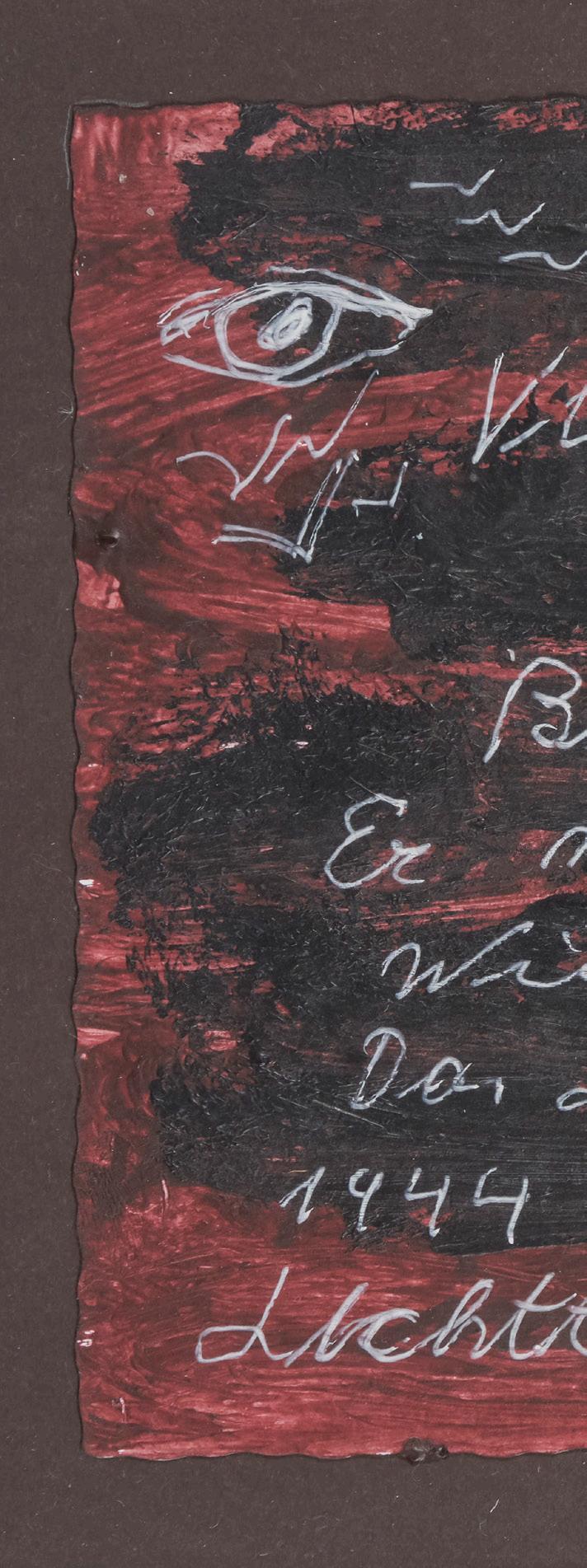
10
Scenes
Roma
Ceija Stoka and
of
Life

11
Ceija Stoka

12
Stoka and Scenes of Roma Life
Ceija

13
Ceija Stoka
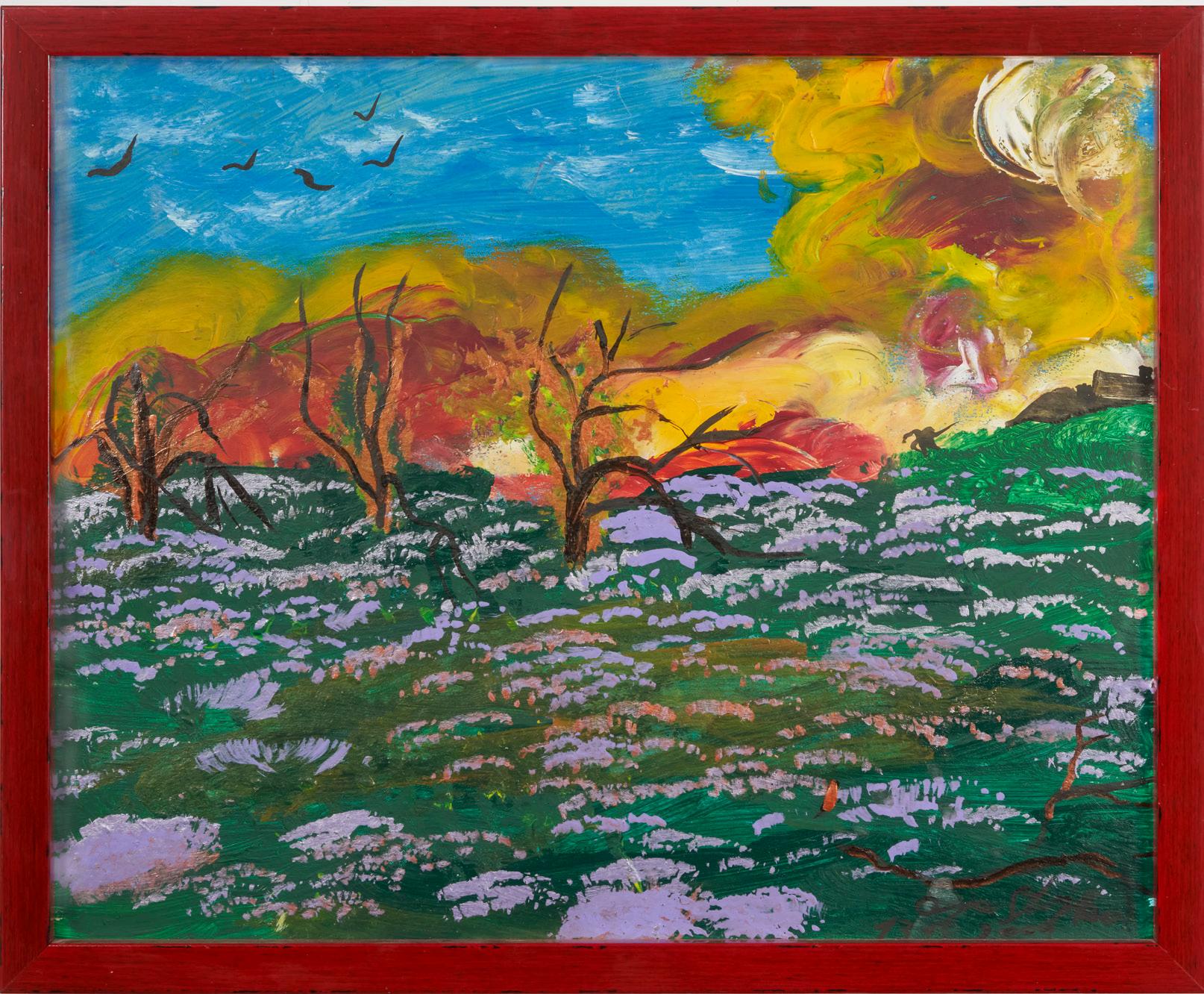
Ceija Stojka, Untitled n.d., acrylic on hardboard
Collection Lorely French
Stojka’s colors express different states of mind and feeling. Here, a multicolored landscape envelops the viewer and presents a confusing puzzle. There are violets and greens in the foreground, yet dead trees are framed by red and yellow clouds that seem to angrily unfurl at the upper right. Stojka used all kinds of unorthodox ways to paint, including using her hands, fingers, and toothpicks, as well as brushes.
14
Roma
Ceija
Stoka and Scenes of
Life
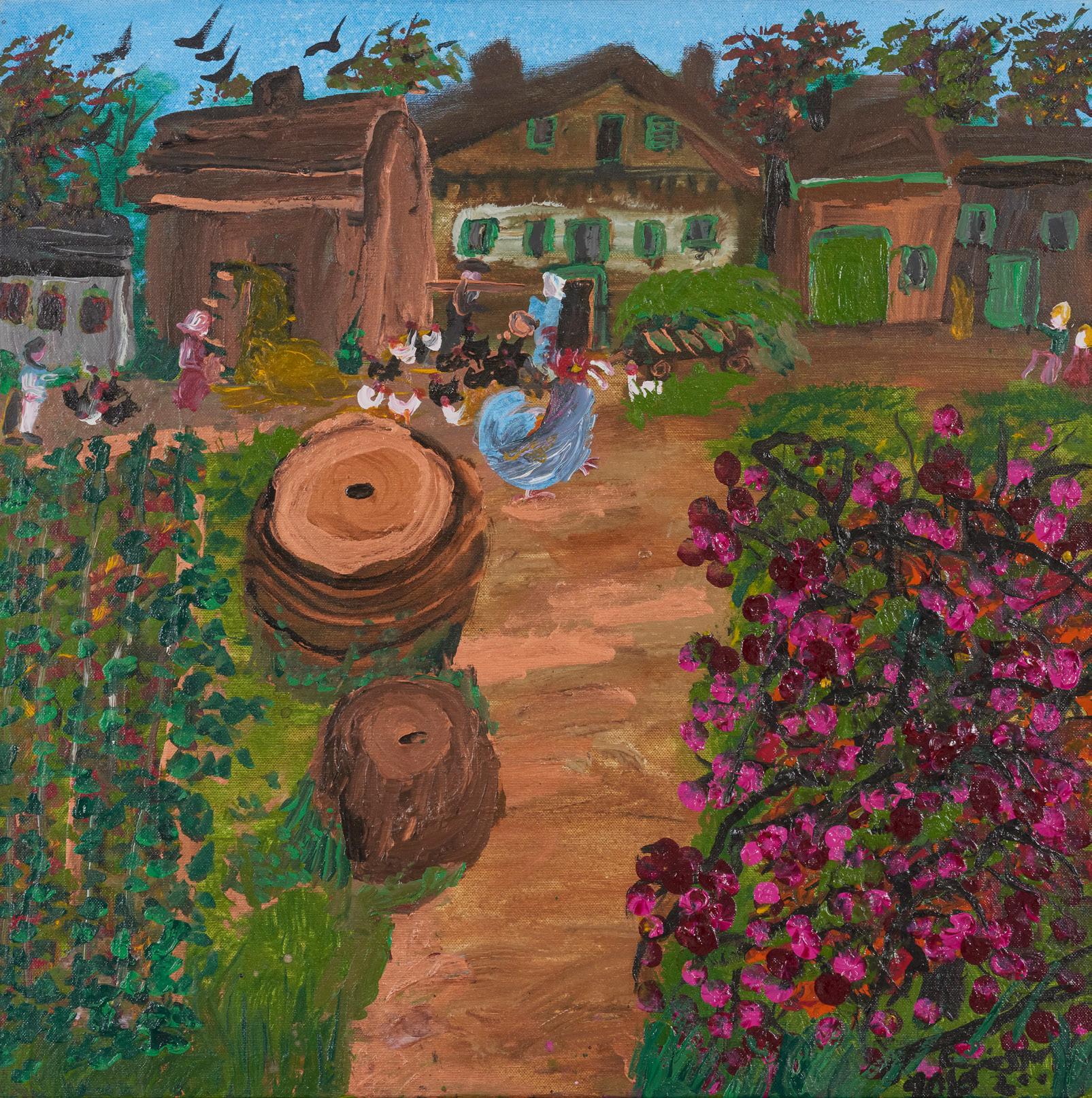
The last warm months in autumn were a welcome time for Roma peoples who participated in the grape harvest at traditional farms in Austria. Ceija Stojka talks about different plants and herbs, and the medicines Romani women made from them. With an impressionistic touch, this painting shows brilliant pink and purple flowers and two barrels along a dirt road leading to a scene of idyllic country life. The background features chickens and roosters, along with kids playing.
15
Ceija Stoka
Ceija Stojka, Untitled [Roma at Grape Harvest] n.d., acrylic on canvas
Collection Michaela Grobbel
Ceija Stojka, Vor dem KZ Rösser
[Before the Concentration Camp Horses]
n.d., acrylic on heavy cardboard Collection Lorely French
The title of this painting, which Stojka has written on the back, seems to point to a memory from Stojka’s childhood before she was sent to Auschwitz-Birkenau. She was held there with many others labeled by the Nazis as ‘asocials,’ or groups seen as lesser. In the foreground, a field of flowers seems to float. The space is full of shimmering purple and pink blossoms. A lone horse is grazing in the bushes on the right. Horses were very important to Roma both for pulling wagons and for trade. But dark red clouds are on the horizon, hinting at bad times ahead. Stojka was self-taught, and her style is unique. She revived her memories years after her traumatic experiences, and found her voice in these autobiographical works.
Following page
Ceija Stojka, Welche Frucht dich brauche ich zu meinem Leben
[What Fruit; I Need You in My Life]
1995, acrylic on hardboard Collection
Lorely French
Resting on its side in a bed of leaves and vines, the bright red-orange pumpkin pops out of the picture, begging to be harvested. As the painting’s title suggests, pumpkins were an essential fruit for Ceija Stojka and her family, as every part of the pumpkin could be used for something. Ceija Stojka would harvest pumpkins in the fall as she and her family traveled through Styria, the Austrian province in which she and her father were born. Styria is noted for its pumpkin cream soup made from the fruit’s flesh and pumpkin seed oil pressed from the dark green seeds. Stojka often writes about the food the family prepared from freshly picked ingredients such as mushrooms, sunflower seeds, tomatoes, and peppers, and the medicinal teas and poultices they made from herbs and plants they gathered.
16
Scenes
Ceija Stoka and
of Roma Life

17
Ceija Stoka
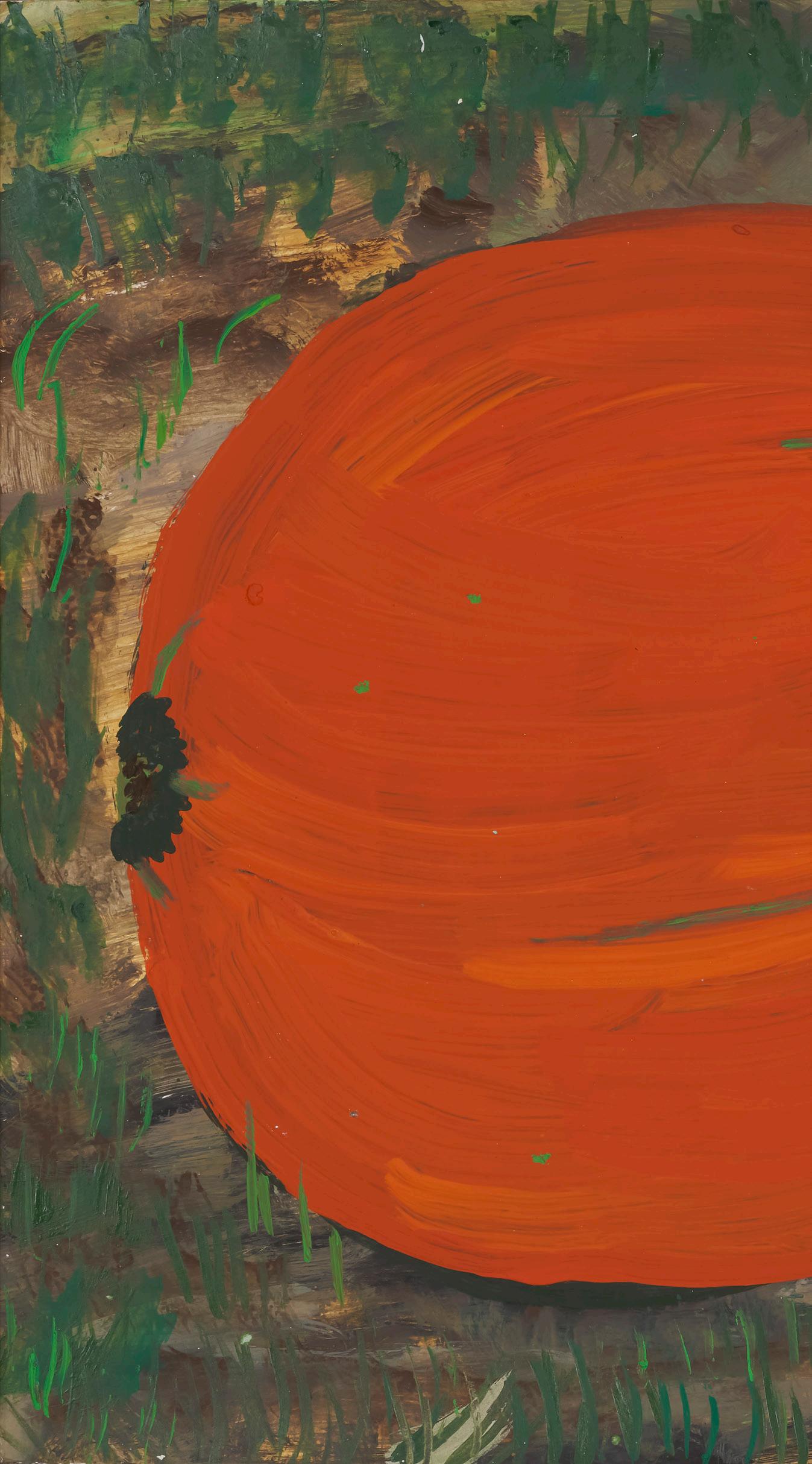
18
Scenes of Roma Life
Ceija Stoka and
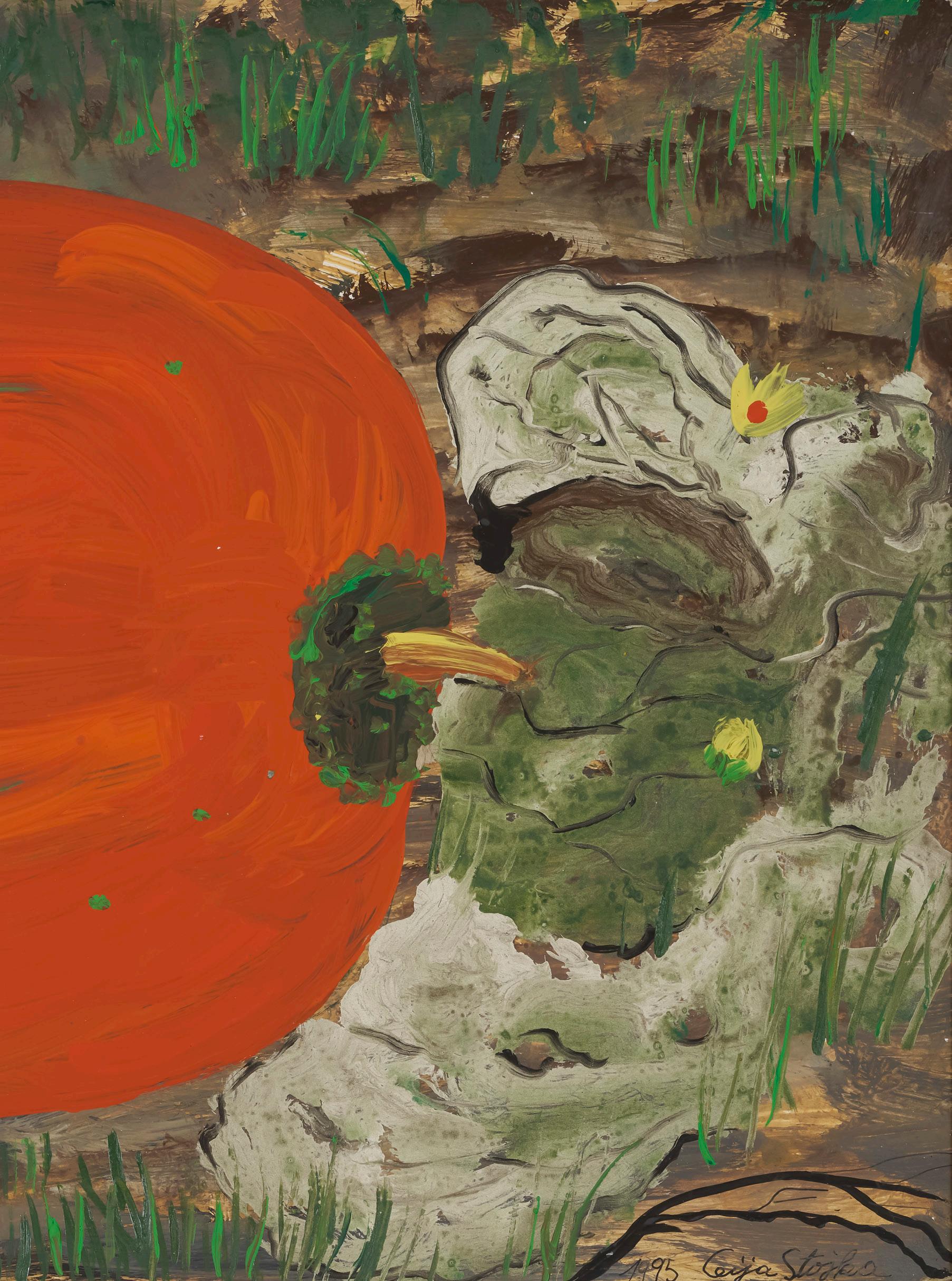
19
Ceija Stoka
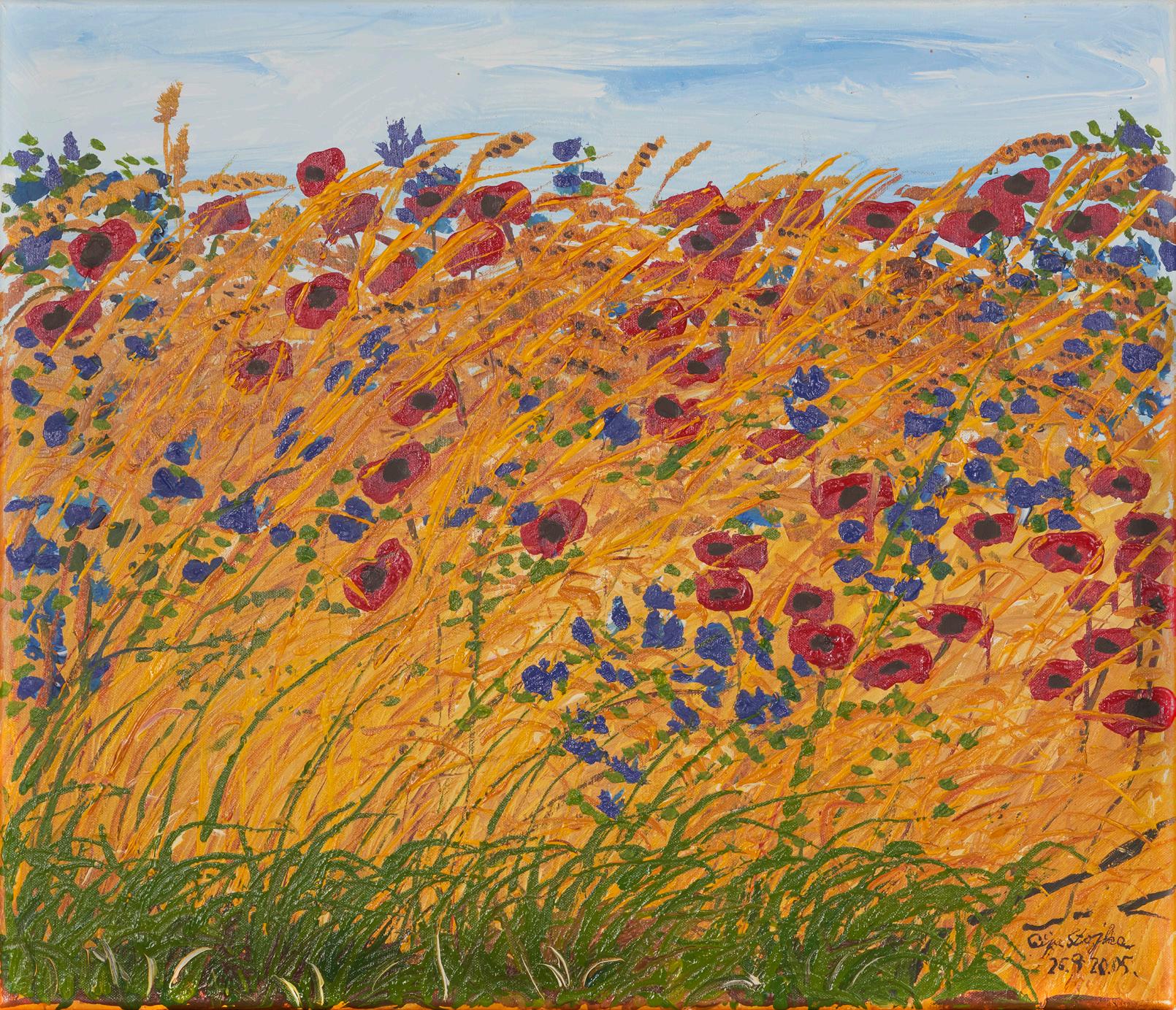
1995, acrylic on canvas
Collection Stackpole & French Law Offices, Stowe, Vermont
A lush field of red poppies and cornflowers, blowing in a subtle breeze, fills the canvas with brilliant sunlight. This indicates renewal and rebirth. A small band of blue sky fills the top of the composition. The message might be that nature can help heal pain and suffering. Stojka’s paintings of flowers and fields also often depict her memories of the idyllic scenery that she and her family passed through while traveling through the Austrian provinces of Burgenland, Carinthia, Styria, Upper Austria, and Lower Austria.
20
Roma
Ceija
Stoka and Scenes of
Life
Ceija Stojka, Ich Liebe Dich [I Love You]
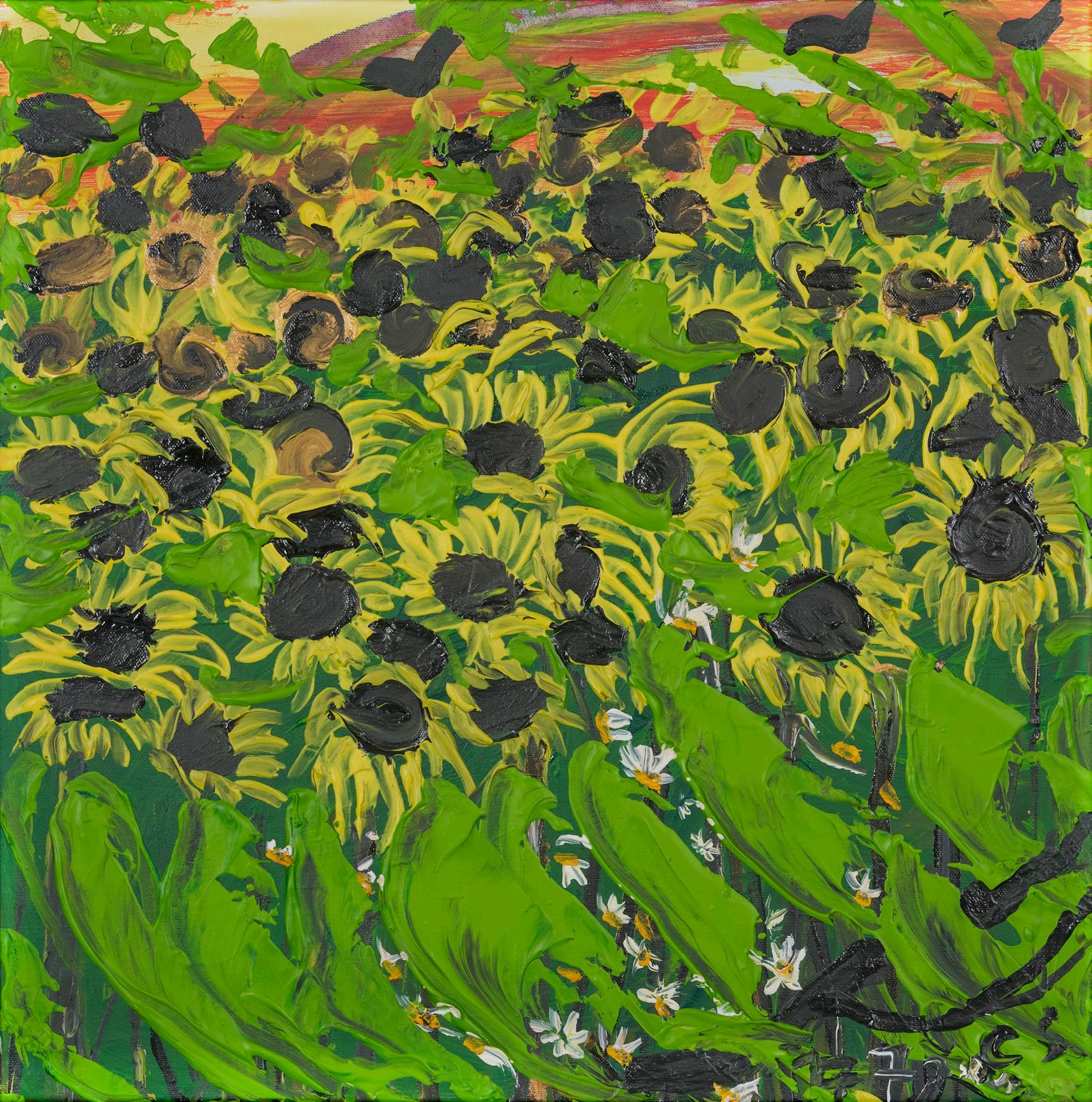
Collection Michaela Grobbel
Lush fields of sunflowers, blowing in a subtle breeze, fill the canvas with brilliant sunlight- suggesting renewal and rebirth. The painting may reflect the memories of a young girl as she gazes at a field of flowers, surrounded and enveloped by them. Nature is presented as a healing force and an antidote to suffering and pain. Ceija Stojka created a poem about the sunflower being the “flower of the Roma” because it provided not only aesthetic beauty but also nourishment – one can eat the seeds and petals – and materials for clothing. Her father once made a dress out of sunflowers for her.
21
Ceija Stoka
Ceija Stojka, Sommerzeit [Summer Time] n.d., acrylic on canvas
Ceija Stojka, Die Mama [The Mama]
1995, acrylic on canvas Collection Pacific University, Forest Grove, Oregon
This painting shows Stojka’s happy memories of her Romani community before World War II. The artist depicts the wagons, colorful clothing, and a lush landscape to vividly convey the importance of community and family for the often persecuted and ostracized Roma. The mother stands apart as the female embodiment of Roma life. Women played a very important role in the life of the community, as caretakers not only of the home and children but also of past traditions and values. After the Holocaust, much of this knowledge was lost as communities were decimated or scattered. Stojka felt it was her mission to save this knowledge and pass it down to future generations.
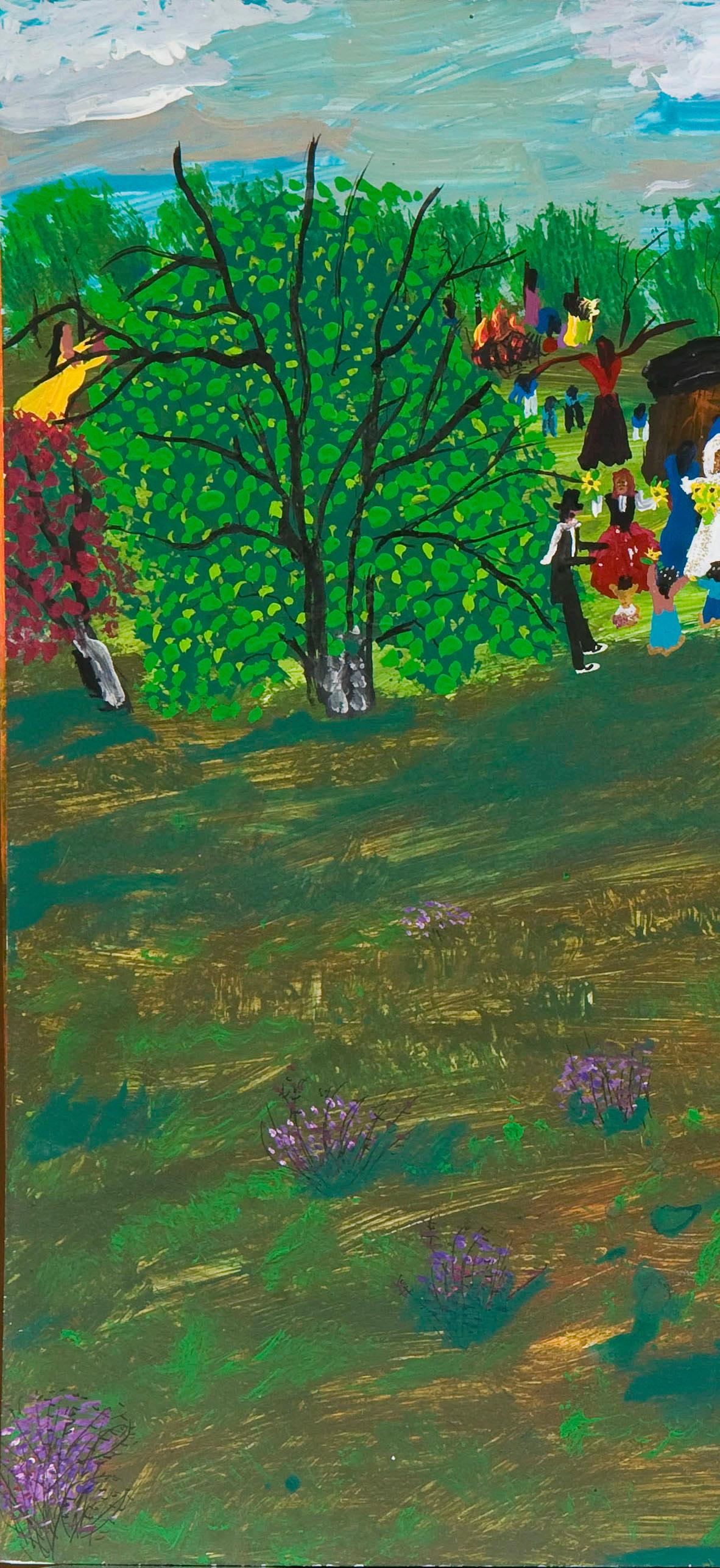
22
Roma
Ceija
Stoka and Scenes of
Life
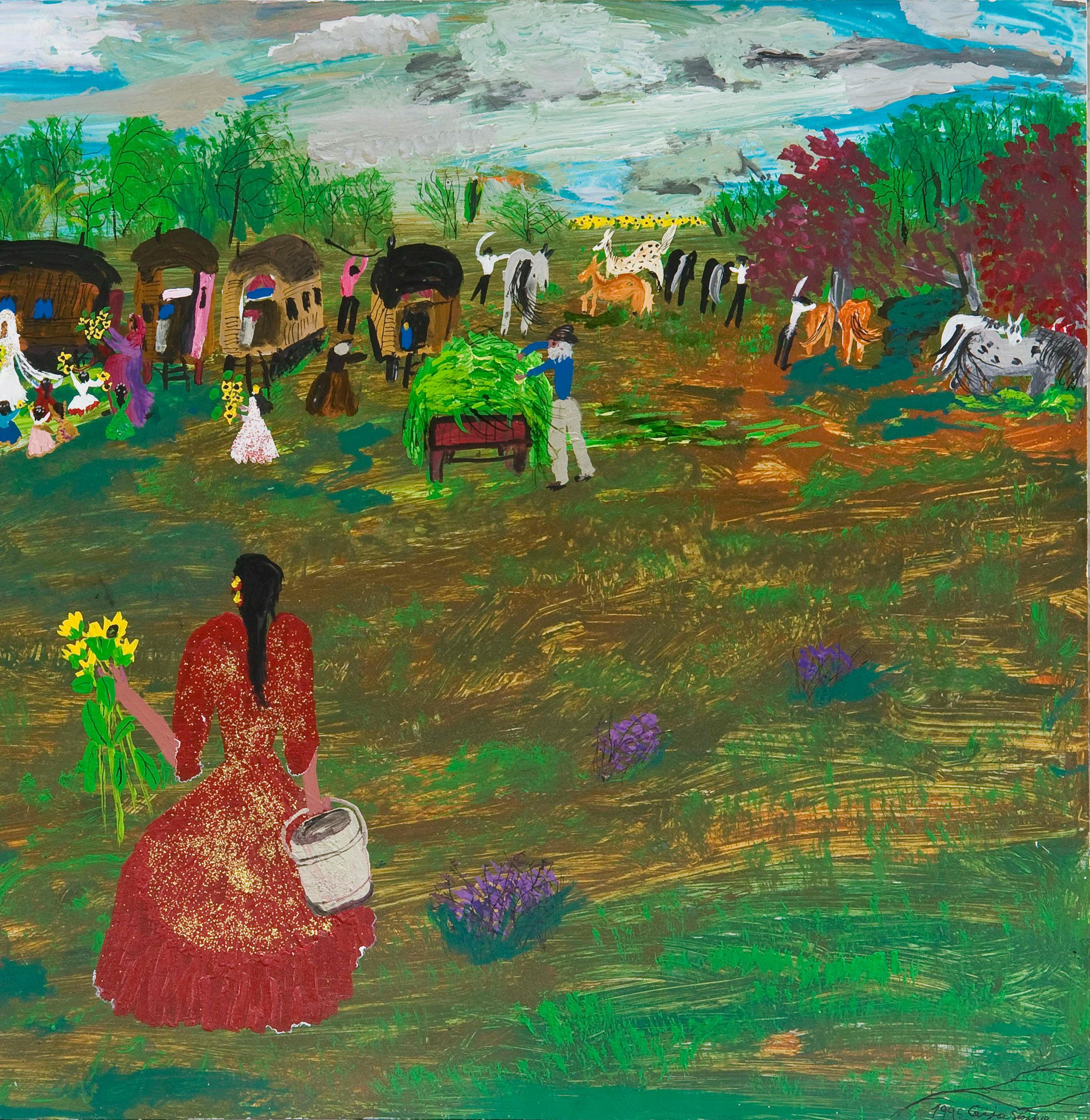
23
Ceija Stoka
Ceija Stojka Notebooks
Transcriptions and translations by Carina Kurta and Lorely French with funding from the National Endowment for the Humanities. Please do not reproduce without permission.
Ceija Stojka, God’s Eye Sees Everything. Even Mary Jane (Terrible)..., 2002, facsimile of original notebook on Untitled [Ceija Stojka’s Father and Two Horses]
Gottes Auge sieht alles. Auch Mary Jane (schlimm). (schlimm) Münchhausen kranke ich glaube ich träume was ich da höre 17.03.2002 Missbrauch der eigenen Kinder (VOX) Wie wie warum mein Gott Münchhausen Münchhausen Münchhausen gesunde Kinder werden krank, gemacht von Frauen Frauen, M…, Pflegerinnen
Wir sind so in Angst um unseren jungen Aschta Pablo mein süßes Enkelkind
Was sind das für Menschen Frauen
Nein das darf nicht sein Münchausenern Kranken helfen
Ohne Schule ist es im späteren Leben für den Menschen sehr schwer ja Kinder sind ohne Geduld, Kinder brauchen auch Liebe von zuhause. Die Lehrkräfte sind oft machtlos Kinder brauchen auch Liebe von zuhause. Die Lehrkräfte sind oft machtlos
Schule ist wichtig für dich Menschenskind
In Pakistan helfen
Eine Frau aus Österreich sie schaut dort wo es Elend gibt
Leider sah ich die Sendung
Schöner Leben nicht ganz und habe auch den Namen nicht gehört die so viel armen Frauen hilft
Auf SAT 3, 17.03.2002, Russland
Genosse Stalin
Das Schlimme war seine Macht
Was tat er Gutes?
Ich sehe und fühle mit den verbitterten Menschen ist es nicht nicht egal, was das Böse besitzt in den Ländern
24 Ceija Stoka and Scenes of Roma Life
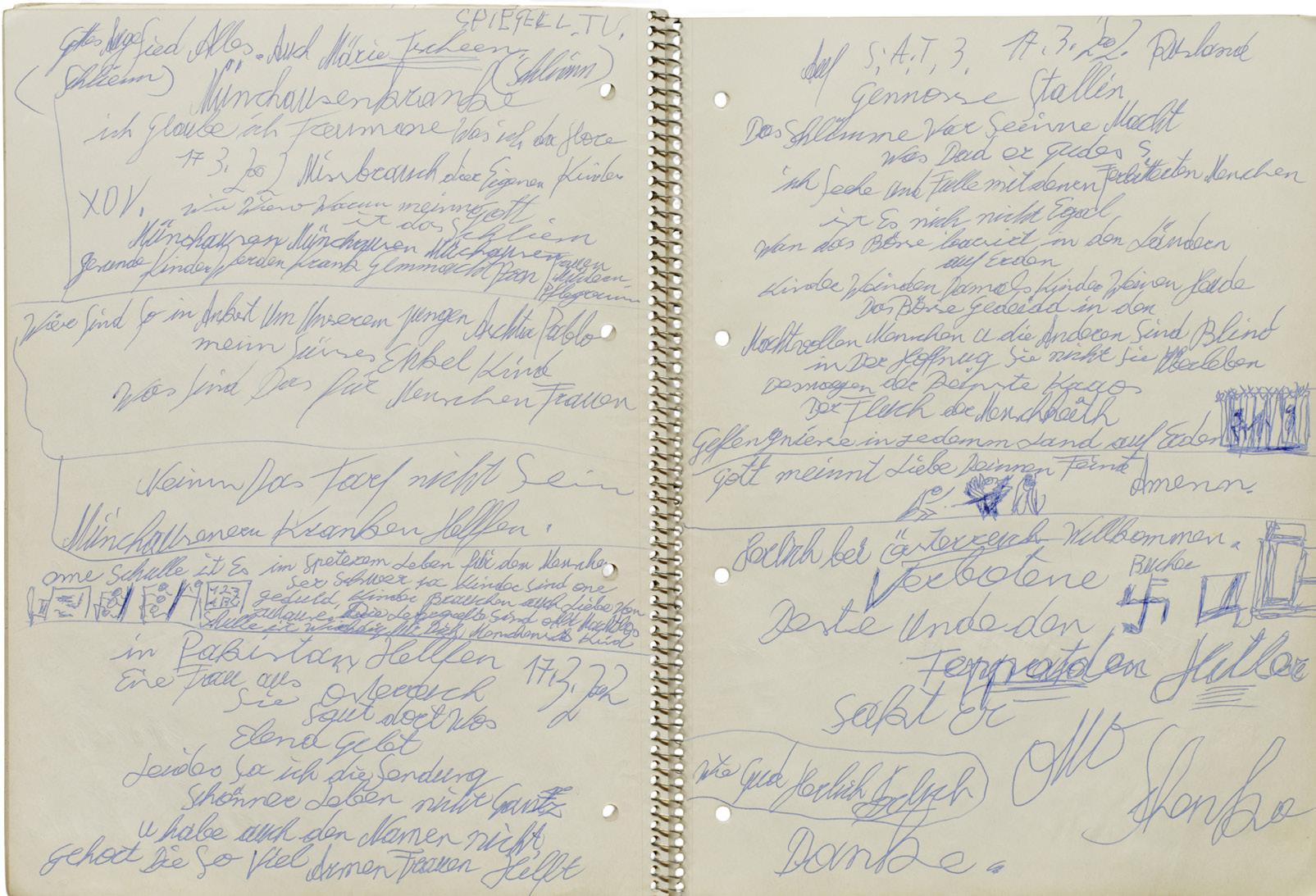
auf Erden
Kinder weinten damals Kinder weinen heute
Das Böse gedeiht in den machtvollen Menschen und die anderen sind blind in der Hoffnung sie winkt, sie überleben deswegen der (das) reinste Chaos der Fluch der Menschheit Gefängnisse in jedem Land auf Erden Gott meint liebe Deinen Feind Amen Herrlich bei “Österreich Willkommen.”
Verbotene Texte Bücher unter den deppaten Hitler sagt er Otto Schenk Wie gut herrlich ehrlich Danke.
25 Ceija Stoka
God’s eye sees everything. Even Mary Jane (terrible) (terrible) Munchausen’s syndrome
I think I’m dreaming what I’m hearing there 3/17/2002 Abuse of their own children (VOX)1 how how why my God Munchausen2 Munchausen Munchausen healthy children get sick, caused by women women, M. . . ., nurses we are so scared about our young Aschta Pablo3 my sweet grandchild
What kind of people are these women
No that can’t be
Help Munchausen children
Without schooling people later in life find it difficult, really difficult, yes, children have no patience, children also need love at home. The teachers are often powerless School is important for you Gosh!
Help in Pakistan
A woman from Austria looks at where there’s misery there
Unfortunately I did not see the whole TV program “Schöner Leben” [“Live Better”]4 and I didn’t hear the name of the person who is helping so many women
1 VOX: TV Channel
2 Munchausen Syndrome (Münchhausen-Stellvertretersyndrom), or fabricated induced illness by carers (FII) is a “condition in which a caregiver creates the appearance of health problems in another, usually a child,” including injuring the child or manipulating test results and samples.”
3 Pablo Stojka: Ceija Stojka’s last grandson, and her “darling.” She composed lullabies for him, and that is how he got his name Aschta, meaning “Wait A Little.” Her worries here reflect the care and love she showed for him and his disabilities.
4 “Schöner Leben” [“Live Better”]: Austrian TV show that began in 2000
26
Stoka
Scenes of Roma Life
Ceija
and
In SAT 3 on 3/17/2002 Russia
Comrade Stalin His power was the worst What good did he do?
I watch and feel for the embittered people and it does matter what evil possesses in these countries on earth
children cried then children cry now Evil flourishes in the powerful people and the others are blind with any wave of hope, they will survive that’s why pure chaos the curse of humankind
Prisons in every land on earth
God says love your enemy Amen A wonderful “Willkommen Österreich” 5 [“Welcome Austria”]
Banned texts
Books under that stupid Hitler he says, Otto Schenk6 how good, wonderfully honest Thanks.
27
Stoka
Ceija
5 “Willkommen Österreich:” An Austrian TV talkshow that ran from 1995-2007 with themes about lifestyle, cooking, sports, etc.
6 Otto Schenk (1930-): Famous Austrian actor, comedian, and cabaret artist

28 Ceija Stoka and Scenes of Roma Life

29
Ceija Stoka
Ceija Stojka, Does He / Omofuma and His Family…, 2002, facsimile of original notebook on Untitled [Ceija Stojka’s Father and Two Horses]
Bekommt er.
Omofuma und seine Familie ihr Recht oder wäscht sie sich ihre Hände in der Unschuld Dies geschah in Österreich und es ist keine Lüge auch wenn es unangenehm ist heute 18.03.2002. So ist es doch wichtig einen Fall wie Omofumas Geschehen nicht zu verschleiern. Das Recht, Vorsicht, ist wichtig auch für seine Eltern die nicht im Dunkeln stehen zu lassen
ORF 1
Der Film
Das Leben ist Schön
Mein kleiner Bruder Osi u mein Vater wo sind unsere Omis umgekommen
Das Leid kann niemand wieder gut machen C.S.
19.03.2002
Danke Karl Heinz Böhm
Der Name ist Hilfe für Menschenkinder Was ist los mit der Post?
19.03.2002 Michael Grabner
Wieder einer der Menschen hilft in Afghanistan Menschen mit traurigen Augen Wer er ist es der reinschaut
Gott segne seine Wege jeder kleine Junge sieht meinem kleinen Bruder Osi und anderen von uns ähnlich Stopp
Haider sagte sie sie lebt in Italien
Mailand Ines
30 Ceija Stoka and Scenes of Roma Life
Does he Omofuma7 and his family receive justice or does she wash her hands in innocence
This happened in Austria and it is no lie even when it’s unpleasant today is 3/18/2002. That’s why it’s so important not to conceal such a case as Omofuma’s Justice, caution, is important and not to let his parents remain in the dark ORF 1
The film
Life is Beautiful8
My little brother Osi and my father where did our grandparents die No one can make that good again C.S.
3/19/2002
Thank you Karl Heinz Böhm9
His name means help for human children
What’s wrong with the postal service?
3/19/2002 Michael Grabner10
Again a person is helping in Afghanistan
People with sad eyes
He, he’s the one who’s looking at it God bless his ways
Every little boy looks like my little brother Osi and others of us
Stopp
Haider11 she said she lives in Italy
Milan
Ines
7 Marcus
8 Das
9 Karlheinz Böhm (1928-2014): Austrian actor and philanthropist
10 Michael Grabner: Conducted a humanitarian mission in Afghanistan
11 Jörg Haider : Austrian politician of the right-wing Freedom Party of Austria (FPÖ) and founder of the party Alliance for the Future of Austria (BZÖ)
31
Ceija Stoka
Omofuma: Asylum seeker in Austria who died in 1999 due to police brutality
Leben ist schön/La vita è bella/ Life is Beautiful (1997): An Italian comedy-drama film directed by and starring Roberto Begnigni about an Italian Jewish bookseller who attempts to protect his son from the horrors of the concentration camp through the use of comedy and imagination
Ceija Stojka, To U6 with Anni…, n.d., facsimile of original notebook on Ich Liebe Dich [I Love You]
zu U6 mit Anni
zu dem Brunnenmarkt ist es vor uns 1 Station in dem Lift hinter in wo die große Eingangstür ist das riesengroße Glas für Eingang zum Lift noch stehen wir unter der großen Bücherei am Gürtel
Anni meine Schwägerin hat ihre Brille auf und sie sagte zu mir ja schau Ceija da drinnen in der Tiefe ist eine Taube. Eine Taube die keine Chance hat sich selbst zu befreien. Wir suchten vergebnislos (vergebens) nach Hilfe, wir suchten nach einer Polizei. Es war nichts, der uns und der Taube helfen konnte, im Kaffee von Achmet gab es doch jemand der mir die Nummer von der Tierrettung gab. Da aber war ablehnend, ich kam zur Polizei, die sagte wir sind für diese Sache nicht zuständig und das 2. Mal die Nummer von der Linie U6 machte mir Hoffnung. Sie versprach es auch. Anni ging 2x zur US auf der Burglinie. Die Taube war nach 7 Stunden noch immer gefangen. Unsere Trauer blieb. Mit Senja zu U6 9 Uhr morgens Regungslos sitzt die Taube noch immer in der Zwangskabine der Linie U6
So viele Menschen gehen zu U6 Das Herz von diesem Tier muss gezwungenerweise aufhören zu schlagen
Das ist auch Österreich
Ceija Stojka
Burggasse U6 Floridsdorf (Lift)
32 Ceija Stoka and Scenes of Roma Life
to U612 with Anni to the “Brunnenmarkt”
there is only one more station to go to the elevator behind in the big entrance gate the huge glass for the entrance to the elevator we’re still standing there under the big bookstore on the “Gürtel” 13 Anni my sister-in-law has her glasses on and she says to me look Ceija there inside there down below is a pigeon. A pigeon that does not stand a chance to free himself We looked in vain for help, we looked for the police. There was nothing that could help us or the pigeon, in the Achmet Cafe there was someone who gave me the number of the animal rescue. But we were refused there. I went to the police station, they said we are not responsible for this matter and for the second time getting the number for the U6 gave me hope. They promised it too. Anni went twice to U6 on the “Burglinie.” 14 The pigeon was still trapped after 7 hours. Our sadness stayed with us. With Senja [Ceija’s dog] to the U6 tomorrow morning at 9 o’clock Motionless
the pigeon was still sitting forced into the compartment Line U6
So many people go to U6 The heart of this animal must have been forced to stop beating That’s Austria Ceija Stojka Burggasse U6 Floridsdorf (elevator)
12 U6: Untergrundbahn 6: Subway line in Vienna
13 Gürtel: The elevated rail that goes through Vienna and one of the circular roads surrounding the center of Vienna
14 Burglinie: A metro line in Vienna from 1885, extension of the Burggasse.
33
Ceija Stoka
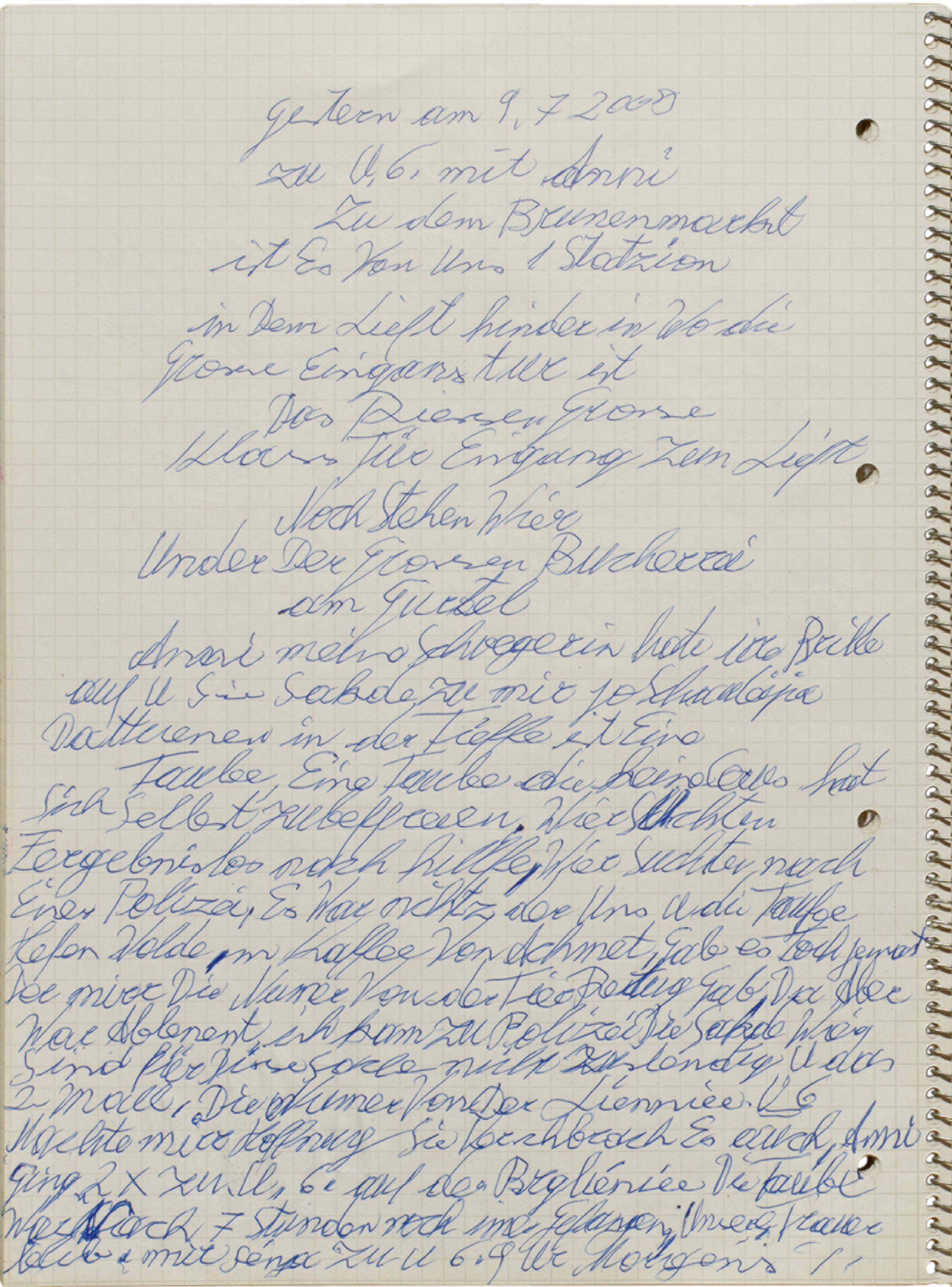
34 Ceija Stoka and Scenes of Roma Life
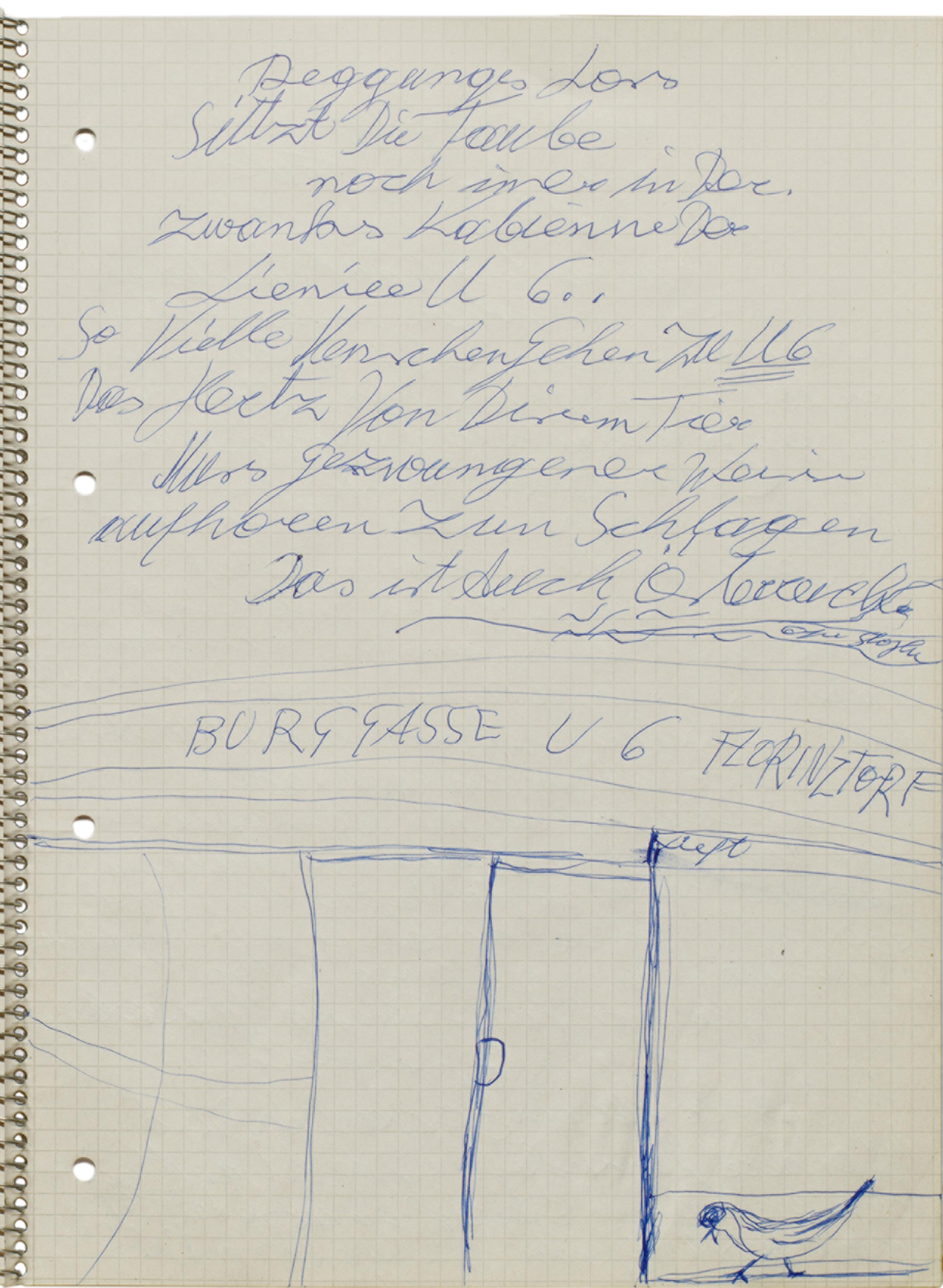
35
Ceija Stoka
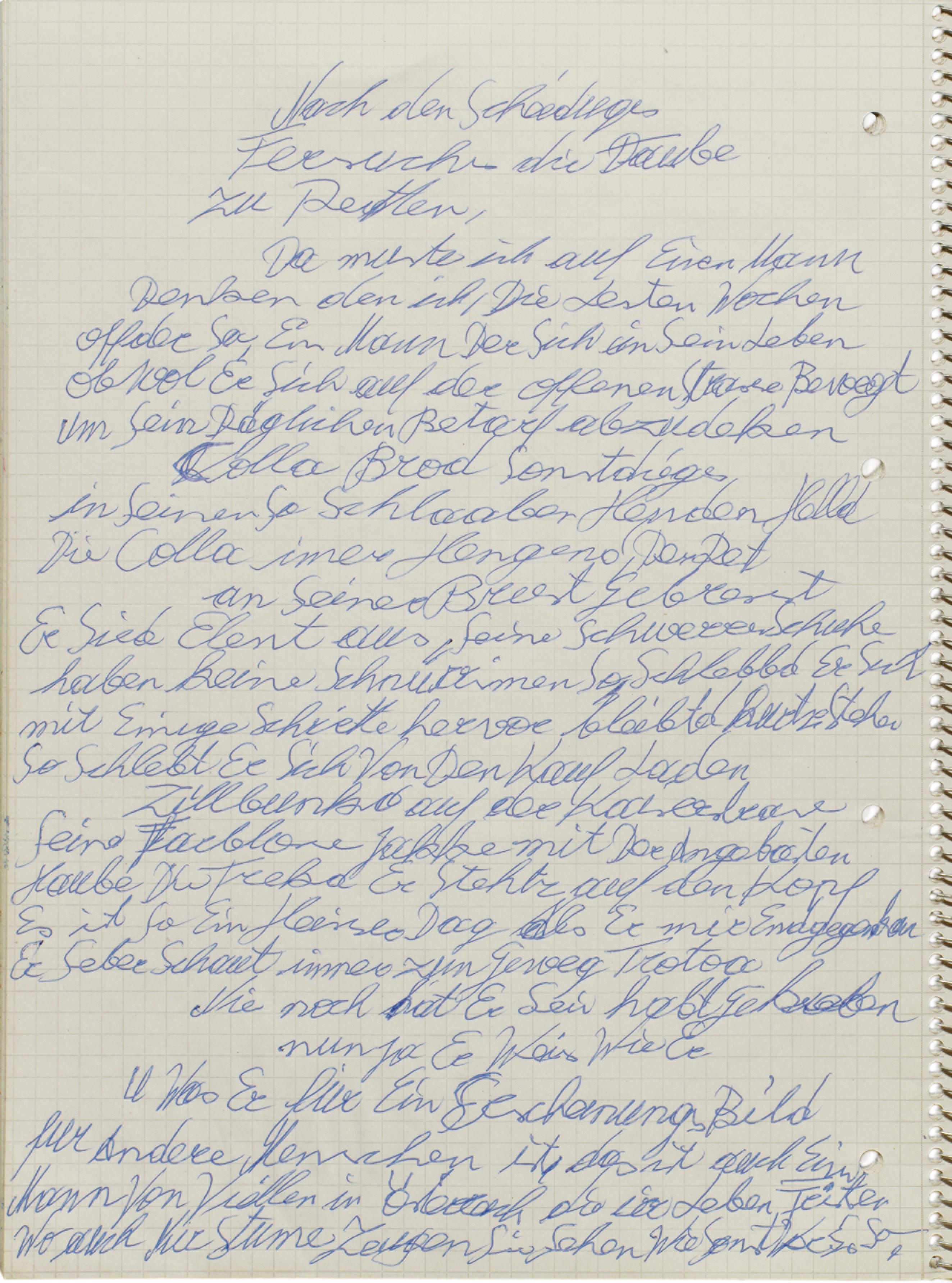
36 Ceija Stoka and Scenes of Roma Life
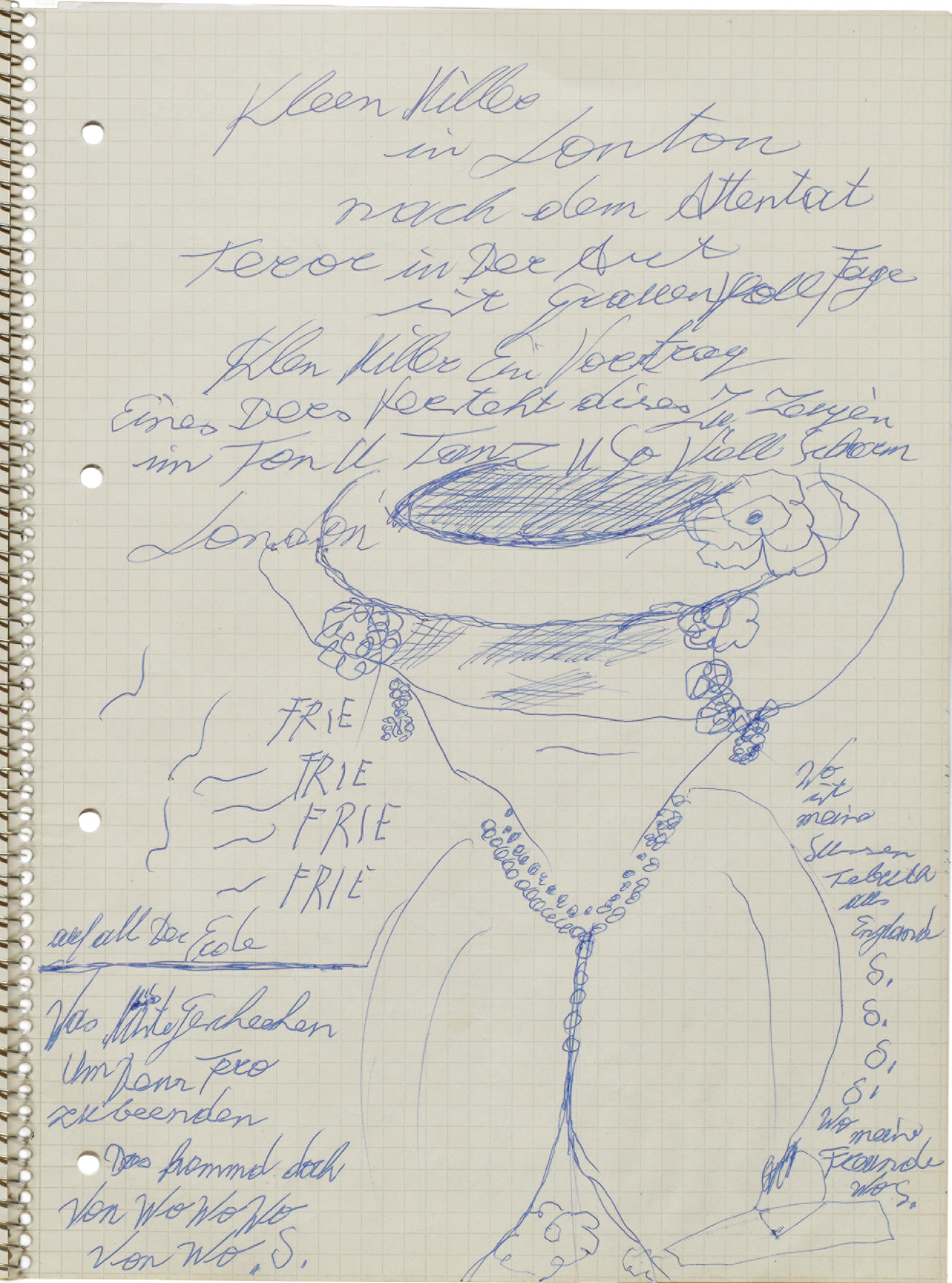
37
Ceija Stoka
Ceija Stojka, After the Harmful / Attempt to Save the Pigeon, n.d., facsimile of original notebook on Ich Liebe Dich [I Love You]
Nach dem scheediges Versuch die Taube zu retten.
Da musste ich auf einen Mann denken, den ich die letzten Wochen öfter sah. Ein Mann, der sich in sein Leben obwohl er sich auf der offenen Straße bewegt um seinen täglichen Bedarf abzudecken Cola, Brot, sonstiges in seinen so schlappen Händen hält die Cola immer hängend, den Rest an seine Brust gepresst Er sieht elend aus, seine schweren Schuhe haben keine Schnürriemen so schleppt er sich mit einigen Schritten hervor, bleibt kurz stehen so schleppt er sich von dem Kaufladen Zielpunkt auf der Kaiserstraße seine farblose Jacke mit der angepassten Haube, die trägt er stets auf dem Kopf. Es is so ein heißer Tag als er mir entgegen (kommt) Er selber schaut immer zum Gehweg Trottoir nie noch hat er sein Haupt gehoben nun ja er weiß wie er und was er für ein Erscheinungsbild für andere Menschen ist, das ist auch ein Mann von vielen in Österreich, die ihr Leben fristen Wo auch nur stumme Zeugen sie sehen wie sonst vor so. Glenn Miller in London nach dem Attentat Terror in dem Aut[obus] ist grauenvoll feige Glenn Miller ein Vortrag einer der es versteht dies zu zeigen im Ton und Tanz und so viel Charme London Frie Frie Frie Frie auf all der Erde
Was müsste geschehen um den Terror zu beenden
38 Ceija Stoka and Scenes of Roma Life
Das kommt doch von wo wo wo wo von wo?
Wo ist mein süsses Tebbutt?
aus England?
Wo meine Freunde wo?
After the harmful attempt to save the pigeon
I had to think about a man whom I had often seen in the last weeks, a man who, although he moved around on the open street, in order to cover his daily needs, held cola, bread, whatever, in his limp hands the cola always hanging down, the rest pressed to his chest
He looks miserable, his heavy shoes don’t have any shoelaces, that’s how he drags himself along with steps, stops a little bit that’s how he drags himself from the store towards his goal in the Kaiserstraße his colorless jacket with the matching hood that he’s wearing standing up on his head… It’s such a hot day as he comes towards me He’s always looking at the sidewalk He’s still never raised his head Well, he knows how and as what he appears to other people He is also a man out of many who eke out a living where only silent witnesses usually see them.
Glenn Miller15 in London after the assassination Terror on the bus 16 is horribly cowardly
Glenn Miller a lecture
Someone who knows how to show this
15 Glenn Miller (1904-1944): American big band founder, owner, conductor, trombone player, and recording artist before and during World War II. He volunteered in 1942 to serve in the US military to play for the troops and became a member of the US Army Air Forces. He was declared missing in action on December 15, 1944, in a flight over the English Channel. Ceija Stojka was a big fan of Miller’s music and mentions him often in her memoirs. Unfortunately, no information on Ceija Stojka’s mention of Glenn Miller and a lecture and musical performance in connection with the 2005 London bombings is available.
16 7 July 2005 London bombings: A series of four suicide attacks by Islamic terrorists that targeted commuters on London’s public transportation and resulted in the deaths of the bombers and 52 UK residents and over 700 injuries
39 Ceija Stoka

in sound and dance
so charming London
Free
Free
Free
Free
On the entire earth
What has to happen to end the terror
That comes from where where where where from where?
Where is my sweet Tebbutt17 from London?
17 “Tebbutt”: Susan Tebbutt, British scholar whose book Sinti and Roma: Gypsies in German-speaking Society and Culture (Berghahn Books, 1998) was one of the first studies in English to include analysis of Ceija Stojka’s written and visual works. Tebbutt was a long-time friend of Ceija Stojka and visited her often in Vienna.
40
Stoka
Scenes of Roma Life
Ceija
and
Ceija Stojka, May 1st a Wonderful Morning and a Lot of Sun on My Balcony the Mother Chickadee Flies into Her Nest…, 1995, facsimile of original notebook on Vor dem KZ Rösser [Before the Concentration Camp Horses]
01.05.1995
Der 1. Mai ein herrlicher Morgen und viel Sonne auf meinem Balkon, im Nest fliegt die Meisenmutter und füttert ihre fünf vier Tage alten Babies.
Um 12 Uhr verließen wir die Wohnung, Kalman schlug vor einmal wieder essen zu gehen, ja dachte ich, die Idee ist gut. Wien ist schön ohne die so vielen Autos. Und schon sind wir beim Autokino.
Der herrliche Flieder noch zwischen alten Planken und der Löwenzahn am Strassenrand.
Viel Gedanken holen mich schon wieder ein als ich noch mit den Teppichen unterwegs war und so auch hier in Aspang mit meinen Geschwistern und meinen Bruders Frauen. Damals war auch der Tag schön, am Aspanger Jahrmarkt, doch niemand wollte einen Teppich kaufen, die Leute gingen spazieren und Geld hatten sie auch nicht so viel. Doch da erblickte ich damals Fritz Muliar, er lief gerade über die Strasse, ja er hatte es sehr eilig, ich erkannte ihn sofort und als er an mich (mir) vorbeilaufen wollte, da fragte ich ihn ob er nicht einen schönen Teppich bräuchte, seine Antwort war kurz und bündig er sagte: “no wos denn no ihr mit eichare Fetz’n” (na was denn noch, ihr mit euren Lumpen). Nachdenkend musst ich immer lachen und erinnere mich gerne an diese Geschichte (und ich mag ihn sehr).
Doch ist alles ein herrliches Erlebnis. Kalman erreichte den Ort, Orth an der Donau.
Das Essen in einem Vorgarten ist gut, nur die Serviererin ist mürrisch uns verging der Hunger und wir verliessen diesen schonen Garten. Vor dem Museum der Fischerei Ausstellung im Garten. Vor diesem Museum stand ein uralter Baum.
Langsam fuhren wir wieder zuhause (nachhause) in unsere vier Wände und so ist es gut.
Ich bekam eine Einladung mit der lieben
Miriam Wiegele, die Einladung lautete 2 Stunden Schulunterricht in einer Schule für Gymnasium. Meine Augen funkelten vor Freude, ich die als Kind die Schule verboten wurde und ich soll jetzt 2 Stunden Schulunterricht geben.
41 Ceija Stoka
Die Klassenlehrerin sagte zu den Kindern, ja meine lieben Kinder ihr wolltet doch Frau Ceija so viel fragen und ihr habt euch ja so viel aufgeschrieben, jetzt aber habt ihr alles vergessen. Aber ich hatte das Gefühl, dass die Kinder plötzlich mir keine lästigen Fragen stellen wollten, die 2 Stunden vergingen ohne zu merken die Kinder waren sehr erstaunt, sie konnten sich nicht vorstellen, dass eine Not so groß sein kann. Sie schauten mich fast mit traurigen Augen an. Ich aber fühlte das Unrecht, das damals geschehen war jetzt wieder gut gemacht wurde. Denn Kinder haben mir 2 Stunden mit Liebe zugehört. Ceija
Die SS die Nazi sie waren zu alles fähig ihnen sitzt noch ihr Embryo in ihrem Nacken Sie entwickelten keine Gefühle Menschen mit ausgeprägten Gefühlen sind menschenbewusst und schätzen dessen Lebensweise wert ja das schafft nur eine normale Entwicklung
May 1st a wonderful morning and a lot of sun on my balcony the mother chickadee flies into her nest and feeds her five four-day old babies
At 12 o’clock I leave the apartment
Kalman suggested we should go to eat out again, yes, I thought, that’s a good idea
Vienna is beautiful without so many cars And then we’re at a drive-in cinema
The wonderful lilacs between old planks and the dandelions at the edge of the street Many thoughts are catching up with me again when I was still going around with the rugs and even here, too in Aspang with my siblings and my brothers’ wives. The daytime was also beautiful then, at the Aspanger fair, but no one wanted to buy a rug, the people were walking and they
42 Ceija Stoka and Scenes of Roma Life
didn’t have so much money. But then I spotted Fritz Muliar18 going across the street, yes, he was really in a hurry. I recognized him immediately and when he went by me, I asked him whether he didn’t need a beautiful rug, his answer was short and abrupt he said: So what else do you want, you with your rags When I think about it, I have to laugh and I like to remember this story (and I like him a lot). My, everything is a wonderful experience.
Kalman got to the place, Orth an der Donau Danube19
The food in a front garden is good only the waitress is grumpy we weren’t hungry any more and we left this beautiful garden In front of the fishing museum exhibition In the garden. In front of this museum Stood an ancient tree We slowly drove home to our four walls and that’s good.
I received an invitation with dear Miriam Wiegele, the invitation, read 2 hours of school lessons in a high school. My eyes sparkled with glee, I, who was forbidden to go to school as a child and now I’m supposed to give 2 hours of school lessons. The teacher said to the children, yes, my Dear children, you all wanted to ask Mrs. Ceija so many questions and you all wrote down so much, but now you have forgotten everything. But I had the feeling that the children suddenly didn’t want to ask me any annoying questions, the 2 hours passed by without notice the children were surprised they couldn’t imagine that a need could be so big. They looked at me almost with sad eyes. But I felt the injustice that what happened then was made good again. For children listened to me for two hours with love. Ceija
The SS the Nazi they were capable of everything their embryo is still breathing down their neck 20
18 Fritz Muliar (1919-2009): Austrian actor, comedian, and cabaret artist
19 Orth an der Donau Danube: Small village in Austria along the Danube
20 “their embryo is still breathing down their neck”/“ihr Embryo in ihrem Nacken”: The reference here is the original saying “Der Schalk sitzt Dir im Nacken,” [He is a real teaser]. In using “embryo” in connection with Nazis, an interpretation could be that the reference is to the killing of embryos and children by the Nazis, and thus the Nazis are haunted by the embryos shadowing over their bodies.
43
Ceija Stoka
They didn’t develop any feelings
People with pronounced feelings are conscious of humans and value their way of life yes, only a normal development accomplishes that
Ceija Stojka, So Much Shame Sucks the Nazi Cover-Up Specialists and Hypocrites…, 1995, facsimile of original notebook on Untitled [Roma at Grape Harvest]
So viel Schande dreckt die Nazi Vertuscher und Heuchler ihres Verbrechen und Feigheit unter ihrem riesengroßen Hut nein nein nochmals nein
Heute 1995 auch in Wien ist den Braunen Hitlerjugend nicht bewusst was damals geschah. Wie sollen sie auch (die Eltern schwiegen) wenn man bedenkt dass damals noch das Nazi Deutschland noch immer regierte in der Regierung wurden sie sogar befördert die Nazi hatten alle Rechte behalten (das gilt bis heute) auch auch solche die das Z.B. Gas in Auschwitz verabreichten gingen frei raus wer fragte schon damals in der Regierung nach Auschwitz und deren deren Geschwistern KZ die vielen Toten welch Schande für die Erben von bis ich möchte denen meine Gedanken in einfacher Sprache sagen wir dürfen niemals vergessen 14.06.1995 Ceija
Lachen herzhaft Lachen das kann ich ich sage es Dir Doch nur über einen der seine Fratze nicht verstellt und schminkt
Der so sein ehrliches Gesicht zeigt ohne Maske die ohne Maske sind die Clowns,
44
Scenes of Roma Life
Ceija Stoka and
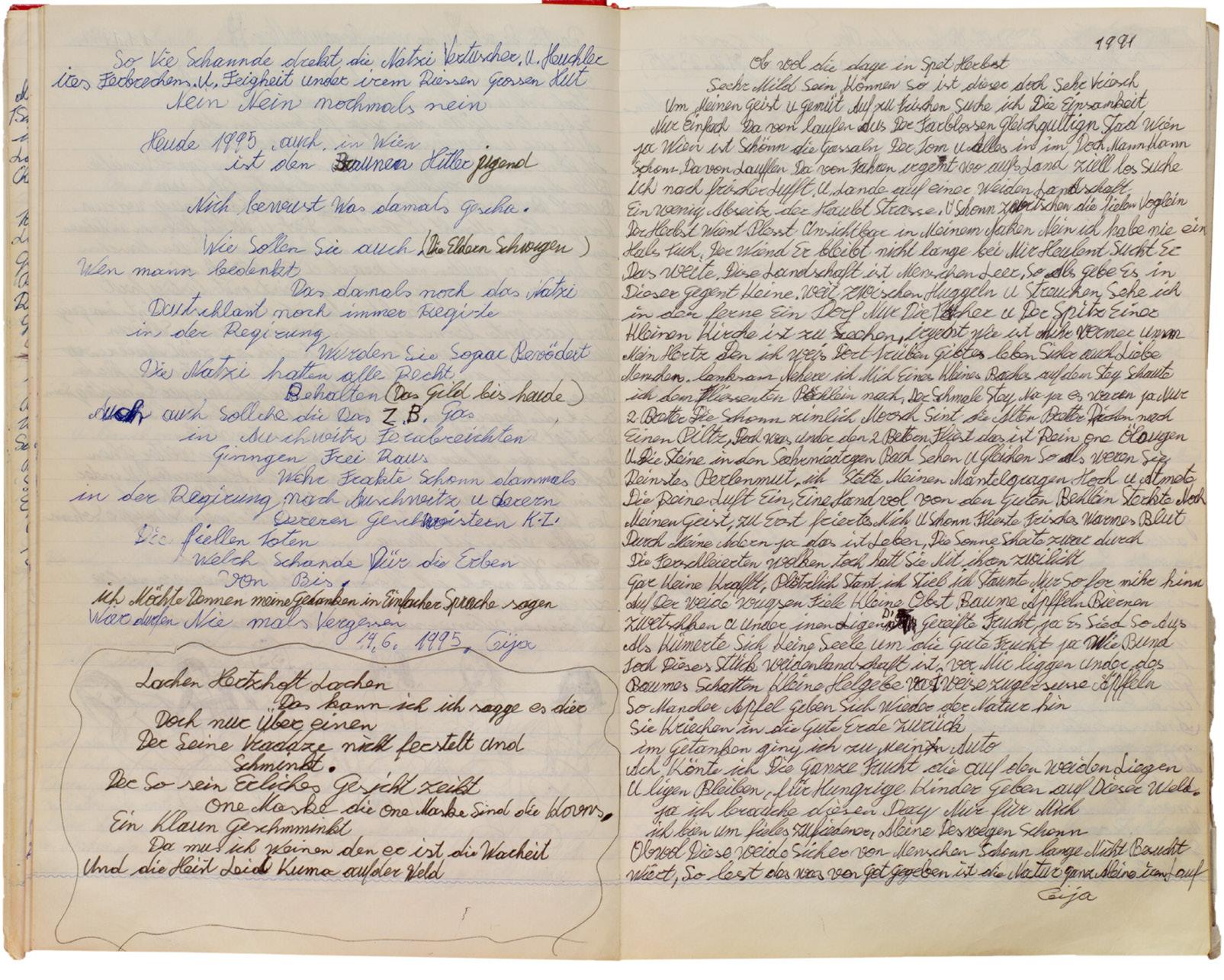
ein Clown geschminkt da muss ich weinen, denn es ist die Wahrheit und die heißt Leid Kummer auf der Welt
Obwohl die Tage im Spätherbst sehr mild sein können, so ist dieser doch sehr frisch, um meinen Geist und Gemüt auf zur frischen Suche ich die Einsamkeit nur einfach davonlaufen, aus der farblosen gleichgültigen Stadt Wien. Ja Wien ist schön, die Gasserln, der Dom und alles in ihr, doch man kann schon davonlaufen. Davon fahren, irgendwo aufs Land ziellos suche ich nach frischer Luft und lande auf einer Weidenlandschaft. Ein wenig abseits der Hauptstrasse und schon zwitschern die vielen Vöglein.
Der Herbstwind presst sich plötzlich unsichtbar in meinen Nacken, nein ich habe nie ein Halstuch. Der Wind, er bleibt nicht lange bei mir heulend sucht er das Weite. Diese Landschaft ist menschenleer, so als gäbe es in dieser Gegend keine. Weit zwischen Hügeln und Sträuchern sehe ich in der Ferne ein Dorf. Nur die Dächer und der Spitz einer kleinen Kirche ist zu sehen, irgendwie ist mir wärmer um mein Herz. Denn ich weiss dort drüben gibt es Leben. Sicher auch liebe
45 Ceija Stoka
Menschen. Langsam nähere ich mich einem kleinen Bach, auf dem Steg schaute
ich in dem fließende Bächlein nach. Der schmale Steg, na ja es waren ja nur 2 Bretter, die schon ziemlich morsch sind, die alten Bretter riechen nach einem Pilz, doch was unter den 2 Brettern das ist rein ohne Ölaugen und die Steine in dem sehr niedrigen Bach sehen und gleichen so als wären sie
reinstes Perlmutt. Ich stellte meinen Mantelkragen hoch und atmete die reine Luft ein. Eine Handvoll von dem guten Bächlein stärkte noch meinen Geist, zu erst friert es mich und schon fliesst frisches warmes Blut durch meine Adern, ja das ist Leben. Die Sonne scheint zwar durch die verschleierten Wolken, doch hat sie mit ihrem Zwielicht gar keine Kraft. Plötzlich stand ich still, ich staunte nur so vor mich hin. Auf der Weide wuchsen viele kleine Obstbäume, Äpfel, Birnen, Zwetschken und unter ihnen liegen die gereiften Früchte, je es sieht so aus als kümmerte sich keine Seele um die gute Frucht, ja wie bunt, doch dieses Stück Weidenlandschaft ist, vor mir liegen unter des Baumes Schatten kleine Hellgelbe, fast weisse zuckersüsse Äpfel. So mancher Apfel geben sich wieder der Natur hin.
Sie kriechen in die Erde zurück. In Gedanken ging ich zu meinem Auto. Ach könnte ich die ganze Frucht, die auf den Weiden liegen und liegen bleiben für hungrige Kinder geben auf dieser Welt. Ja ich brauche diesen Tag nur für mich, ich bin um vieles zufriedener. .
Obwohl diese Weide sicher von Menschen schon lange nicht besucht wird, so lässt das was von Gott gegeben ist die Natur ganz alleine ihren Lauf. Ceija
So much shame sucks the Nazi cover-up specialists and hypocrites their crimes and cowardice under a massive hat no no again no
Today 1945 even in Vienna the Brown Hitler Youth doesn’t know what happened then. How should they (their parents are silent) when one considers that back then the Nazi still governed Germany in the government it was promoted that the Nazis had possessed all the rights (that applies even today) also also those who administered Z.B. [Zyklon B] gas in Auschwitz were let free who asked already then in the government about Auschwitz and its
46 Ceija Stoka and Scenes of Roma Life
sibling KZ
the many dead what a shame for the heirs from to
I would like to tell them my thoughts in a simple language we must never forget 6/14/1995 Ceija
Laugh heartily laugh
I can do that I tell you But only about someone who doesn’t hide his hideous face and uses make-up. Whoever shows his honest face this way without mask those without masks are the clowns a clown uses make-up then I have to cry, for it is the truth and that means suffering sorrow in the world
Although the days in late fall can be very mild, this one is still very brisk, to refresh my spirit and mind I search for solitude simply just get away, get out of the colorless indifferent city Vienna. Yes Vienna is beautiful, the small streets, the dome and everything in it, still one can get away from it. Drive away from it, anywhere into the country aimlessly I search out fresh air and come to a countryside pasture. A little secluded from the main street and already the many little birds are chirping.
The fall wind suddenly presses invisibly into my neck, no I never have a Scarf. The wind, he doesn’t stay howling with me long he looks for the vastness. This countryside is devoid of humans, as if there were no one in this area. Far between the hills and the branches I see a village in the distance. Only the rooftops and the spire of a small church are visible. For I know that there is life over there. Certainly also dear people. Slowly I approach a small brook, on the wooden bridge I look into the flowing little brook. The small wooden bridge, or really, it was only 2 boards that are already a bit rotted, the old boards smelled like a mushroom, but what was under the 2 boards that’s pure without oily eyes
and the stones in the very low brook look like and resemble the purest mother-of-pearl. I turned up my coat collar and breathed in the pure air. A handful of the good little brook strengthened my spirit, at first it froze me and soon fresh warm blood flowed through my veins, yes, that is life. The sun was shining through the concealing clouds, but with her twilight she didn’t have
47
Ceija Stoka
any power. Suddenly I stood still, I was just amazed. In the pasture were growing many little fruit trees, apples, pears, plums und under them lay the ripe fruit, but it looks as if no soul took care of the good fruit, yes, still, how colorful this piece of countryside meadow is, in front of me under the shadow of the tree small light yellow, almost white sugar sweet apples. So some apples give themselves back to nature. They crawl back into the earth. Deep in thought I went to my car.
Oh my, if only I could only give all this fruit that is lying and will stay lying On the ground to hungry children in this world. Yes I need this day for myself,
I am much more content about everything. For that reason only . Although most certainly no one will visit this meadow for a long time, let’s let nature take her course with what God has given. Ceija
Ceija Stojka, The Original Inhabitant, the Foreign Roma…, 2010, facsimile of original notebook on Untitled [Wagon/Roma Leben/Roma Life]
Der Ureinwohner, den fremden Romm es ist für sie einfach uns als ungebildet darzustellen
dazu genießen wir jedoch dass unsere Kinder vor den(en)
Landesverwaltern so wie Priestergemeinde und anderen unholden geschützt sind
sie sind unberührt unsere Kinder
sie genießen ihre Kindheit im Geborgenen Sie sind ohne Angst unsere Kinder
Das schuf der Gascho vor schon vielen Jahrhunderten
Der Zigeuner stets den Launen der Gesche hinnehmen musste, dennoch lässt der Zigeuner mit sich so einfach reden, wenn der Erlös auch stimmt
Jahrhunderte haben die Romm Roma sind geprägt und das war nicht immer fair wie die Gasche den Romm gegenüber steht. Es ist das Andere, das so Einfache, das was der Gascho so uneilig macht, der Romm weiß von Haus aus was ihn Erwartet vor diesem Amtshaus was der Rathaus Mann Frau ihm sagen wird nun so ist es und so wird es stets bleiben auf Erden wir sind nur Gottes Streu Gras das was abgemäht wird, wenn es die Gasche vor ihre Kühe im Stall zum Fraß geben
48
Stoka
Scenes of Roma Life
Ceija
and
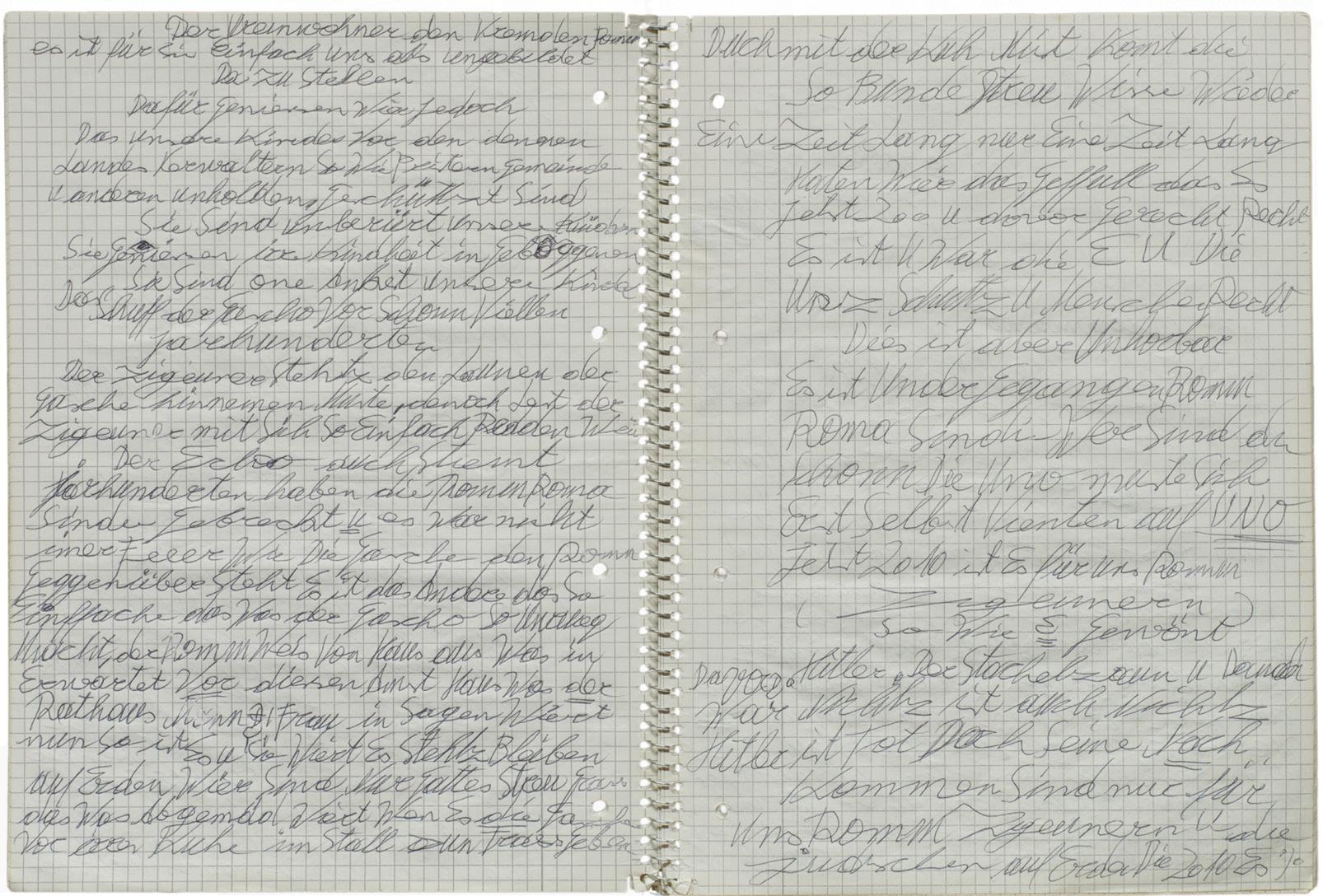
Doch mit der Kuh Mist kommt die so bunte Streuwiese wieder eine Zeitlang nur eine zeitlang hatten wir das Gefühl, dass es jetzt so und davor gerecht Recht Es ist und war die EU die uns Schutz und Menschenrecht
Dies ist aber unhörbar
Es ist untergegangen Romm Roma sind wer sind die schon Die UNO musste sich erst selbst finden auf UNO Jetzt 2010 ist es für uns Romm (Zigeuner) so wie E gewöhnt
Davor? Hitler der Stachel(draht)zaun und dennoch war nichts ist auch nichts Hitler ist Tot doch seine Nachkommen sind nur für uns Romm Zigeuner und die Jüdischen auf Erden 2010
49 Ceija Stoka
The original inhabitant, the foreign Roma it is easy for them to portray us as uneducated in addition we still enjoy that our children are protected from the state administration as well as from the priests’ community and other hostiles they are untouched our children they enjoy their childhood in security They have no fear our children
The Gadscho already caused that many Centuries ago
The Gypsies always had to accept the Moods of the Gesche, still the Gypsy lets him talk to himself, when the receipt is in order for centuries the Romm, Roma have been shaped and it wasn’t always fair how the Gasche treated the Romm. It is the Other, the so simple What the Gascho does so unhurriedly The Romm knows innately was is expected of him in the district office what the city hall man woman will say to him it’s just like that and that’s how it will always remain on earth we are just God’s scattered grass what gets mowed down, what the Gasche give to their cows in the stall to chew on But with the cow comes the so colorful straw you know again for a long time only a long time we had the feeling that now and before there was just justice It is and was the EU that gave us protection and human rights But this is in audible
It went under Romm Roma are who they are
Already The United Nations has to find itself first within the UN Now 2010 it is for us Romm (Gypsies)
exactly as E[urope] is accustomed to Before that? Hitler the barbed wire and notwithstanding Was nothing and remains nothing Hitler is dead but still his offspring are only for us Romm Gypsies and the Jews on earth 2010
50 Ceija Stoka and Scenes of Roma Life
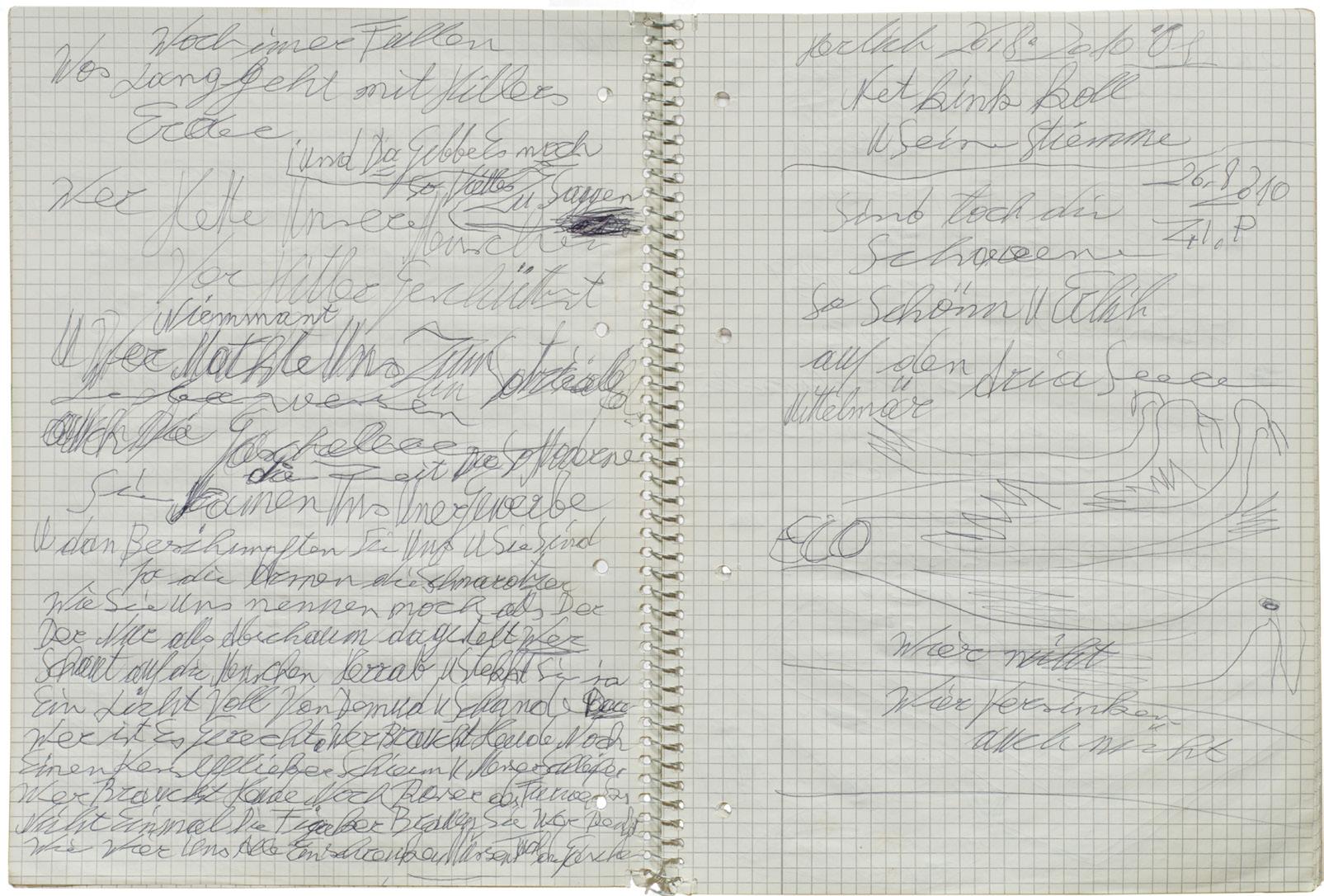
Wach immer fühlen wo’s langgeht mit Hitlers Erde. Und da gäbe es noch so vieles
Wer hätte zu sagen Wer hätte unsere Menschen vor Hitler geschützt
Niemand
Und wer machte uns zum sozialen Lebewesen auch die Gasche die so moderne die Zeit sie nahmen uns unser Gewerbe und dann beschimpften sie uns und sie sind ja die Armen die Schmarotzer wie sie uns nennen noch als der der nur als Abschaum dargestellt wer schaut auf die Menschen herab und steckt sie ja ein Licht voll von Donner und Schande Wer ist es gerecht, wer braucht heute noch einen Kesselflicker, Schirm und Messerschleifer
51
Ceija
Stoka
Ceija Stojka, Awake Always Feeling…, 2010, facsimile of original notebook about Untitled [Wagon/Roma Leben/Roma Life]
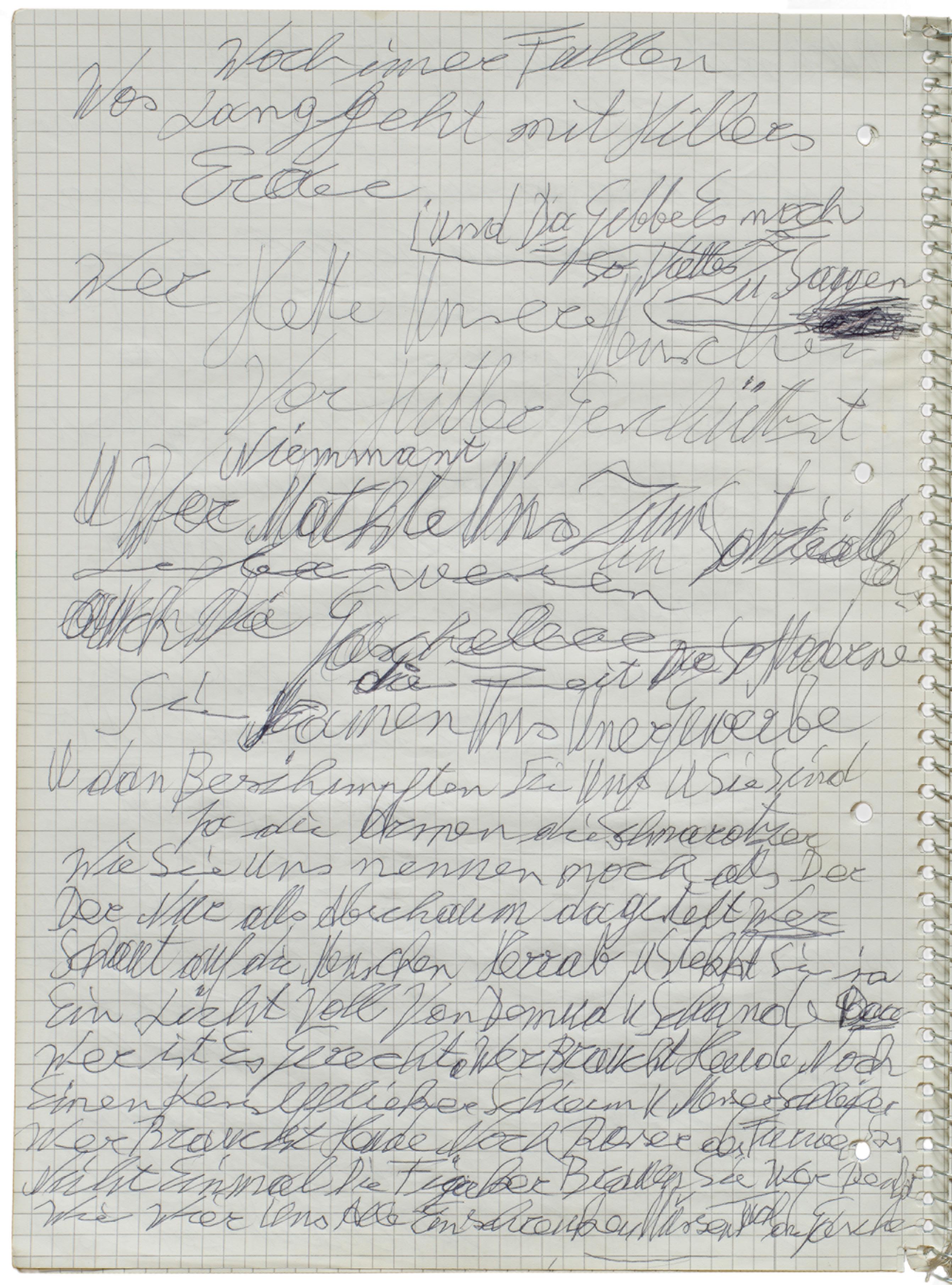
52 Ceija Stoka and Scenes of Roma Life
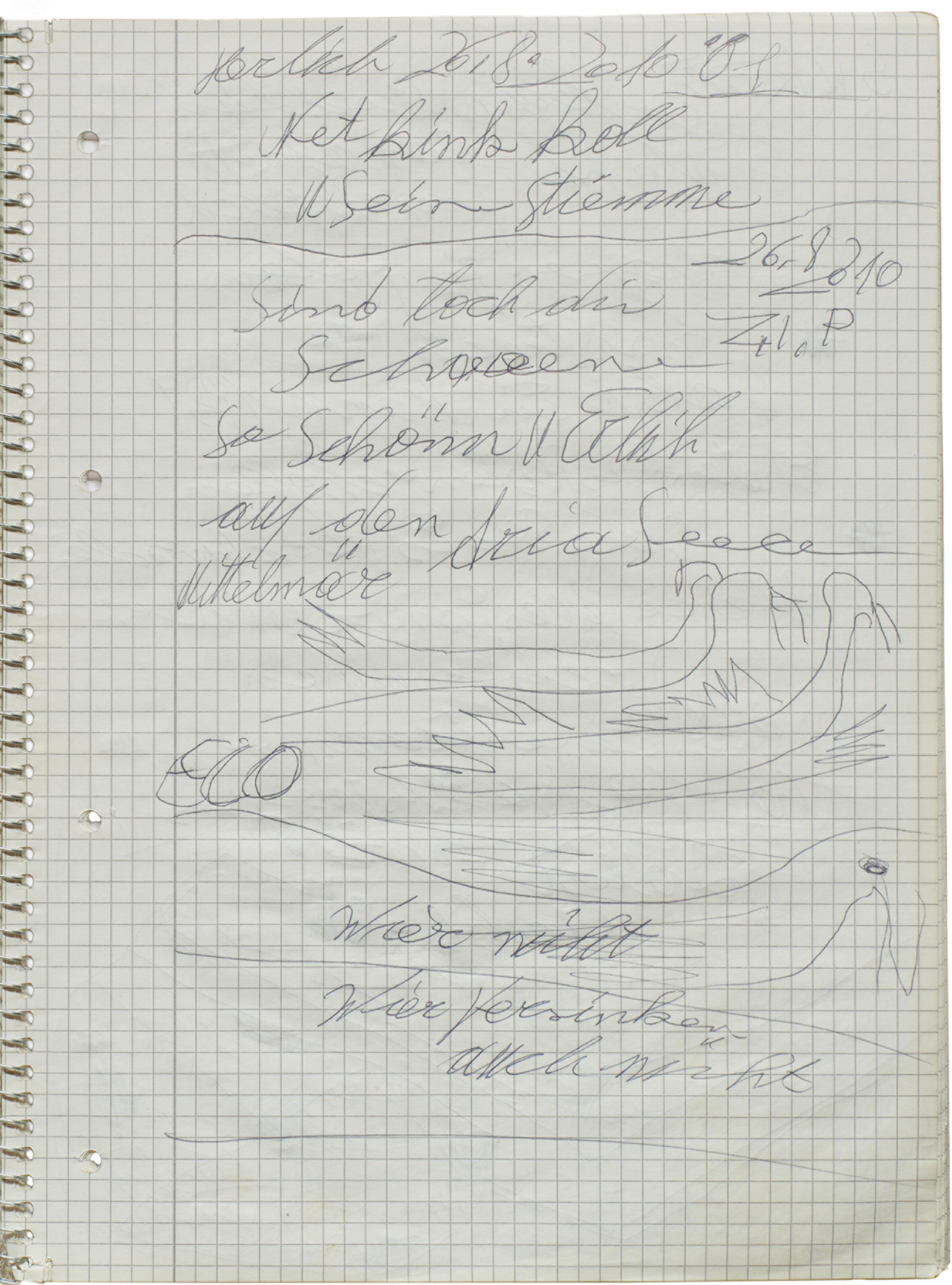
53
Ceija Stoka
wer braucht heute noch Rösser das Fuhrwerk nicht einmal die Fiaker brauchen sie wer denkt wie wir uns alle einschränken müssen die Gasche
Herrlich 20.08.2010 Ö1
Nat King Kole und seine Stimme
Sind doch schön
so schön und ehrlich ORF 26.08.2010 auf der Adriasee Mittelmeer
Wir nicht wir versinken auch nicht
Awake always feeling what’s happening with Hitler’s Earth. And with that there would be so much
Who would have something to say
Who would have protected our people from Hitler
Nobody
Who made us into social beings
Even the Gasche in the modern times
They took away our trades and then they scolded us and said they are really the poor people freeloaders as they still called us just like those who were portrayed as scum looked down on the people and puts them in a light full of thunder and shame
Who is that fair to, who today still needs a tinker, umbrella and knife sharpener who today still needs horses a wagon not even the carriages21 need them who considers how we have had to limit ourselves the Gasche
54 Ceija Stoka and Scenes of Roma Life
21 Fiaker : horse-drawn carriages in Vienna that remain a tourist attraction
Wonderful 8/20/2010 Ö1
Nat King Cole22
and his voice are really beautiful
so beautiful and honest ORF 8/26/2010 on the Adriatic Sea Mediterranean Sea
Not us we are also not sinking
22 Nat King Cole (1919-1965): American jazz singer, pianist, and actor
55
Stoka
Ceija
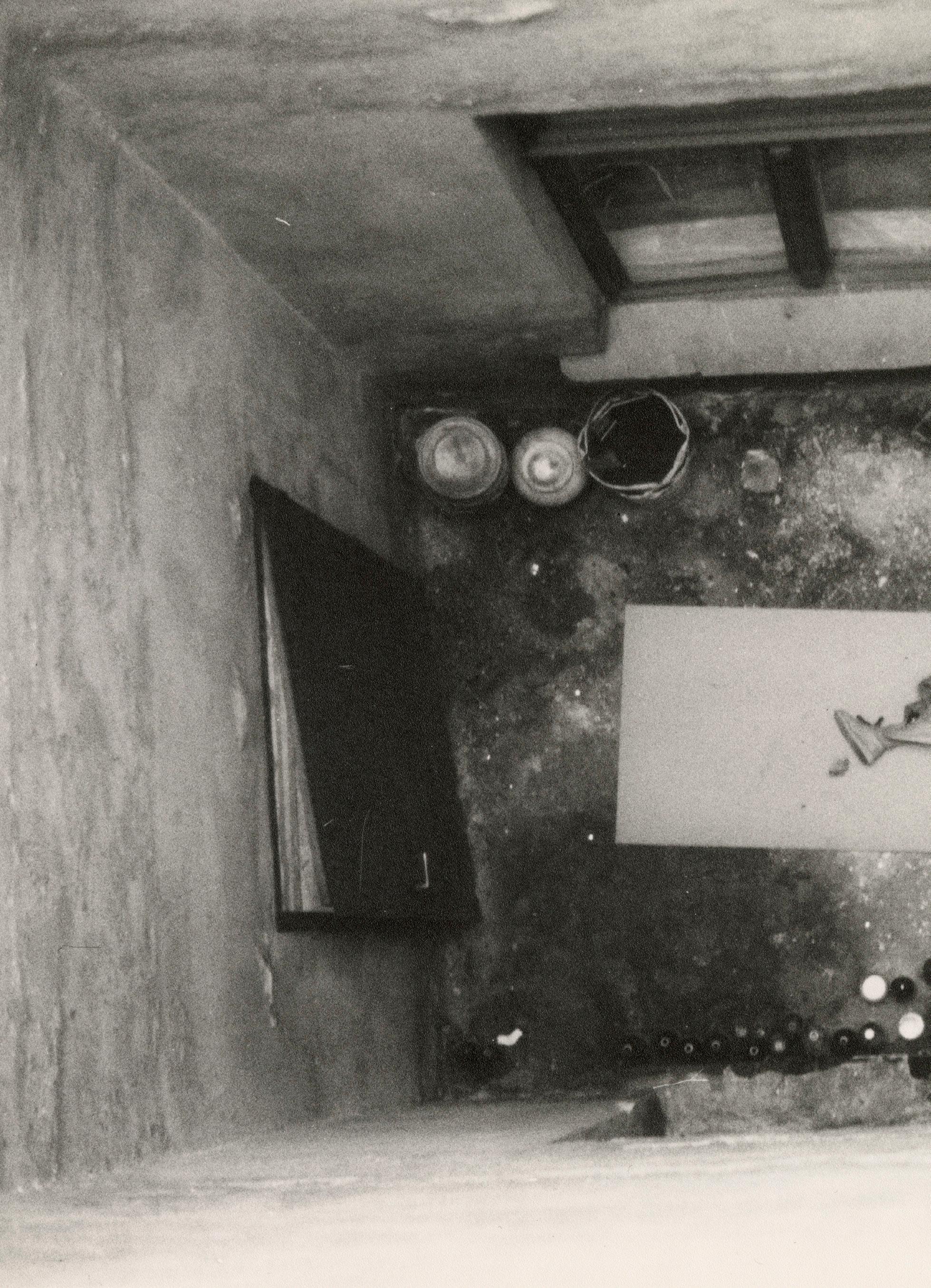
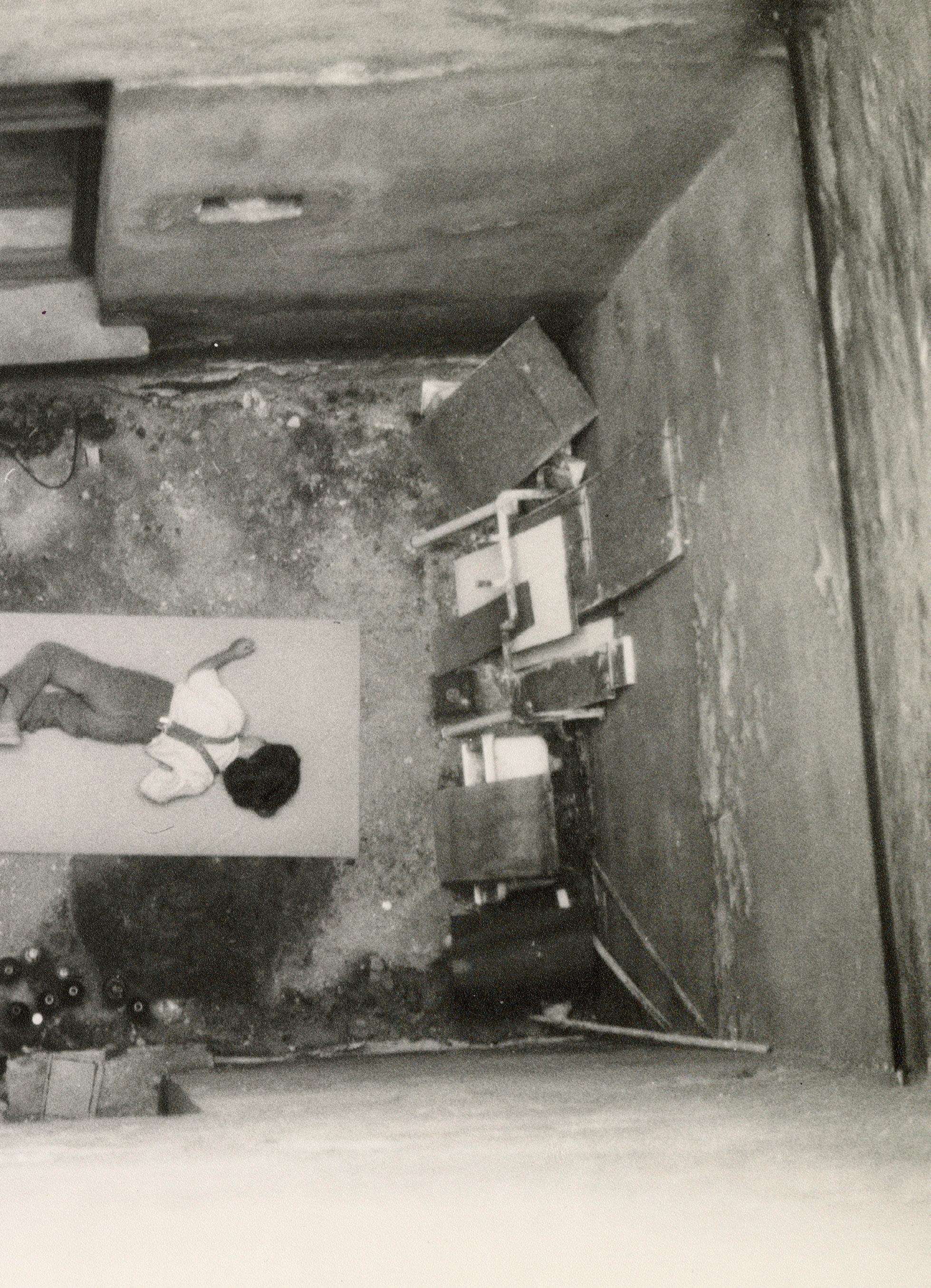
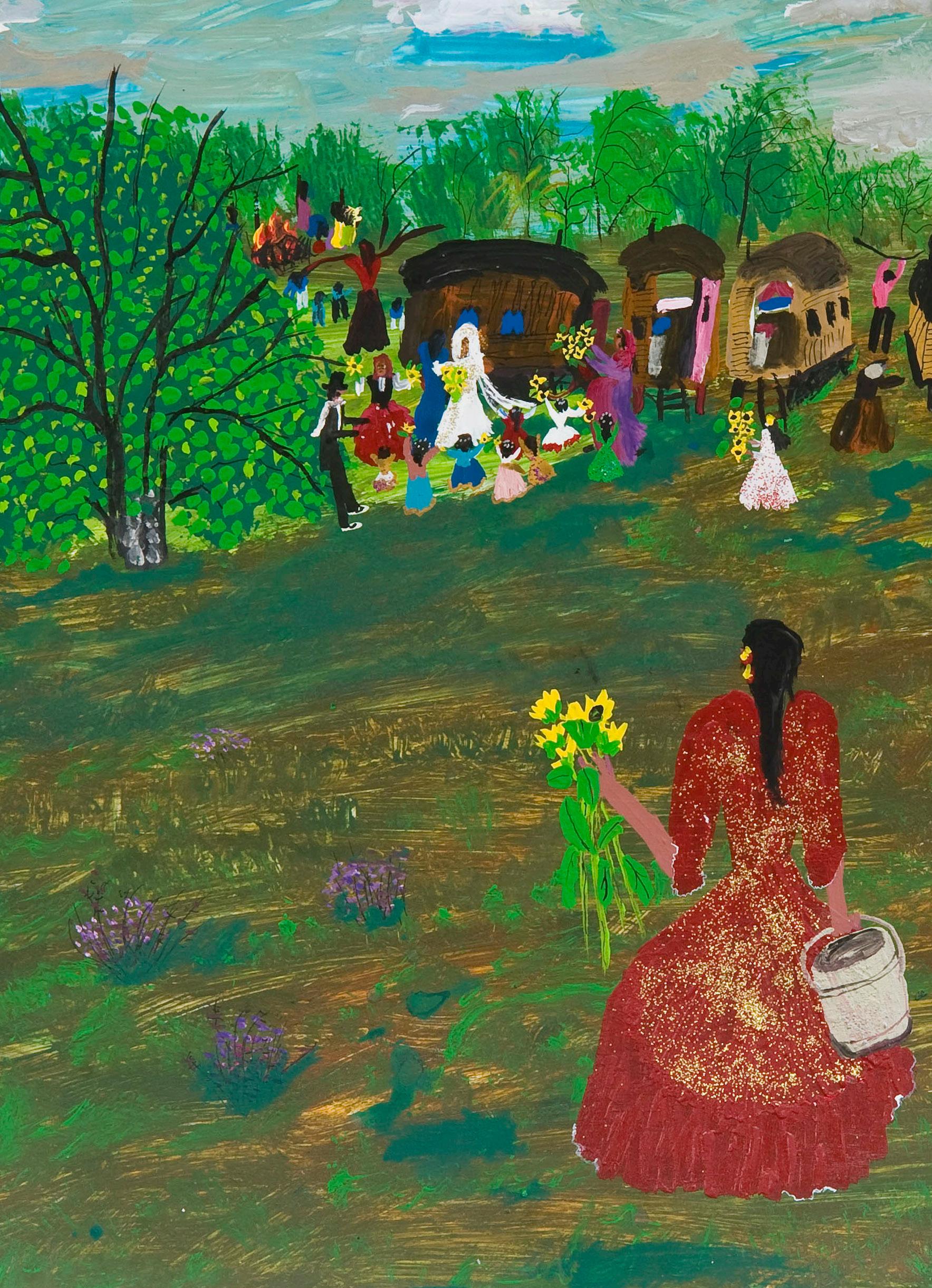
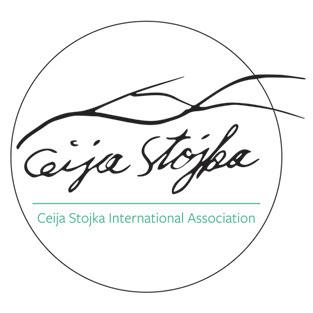
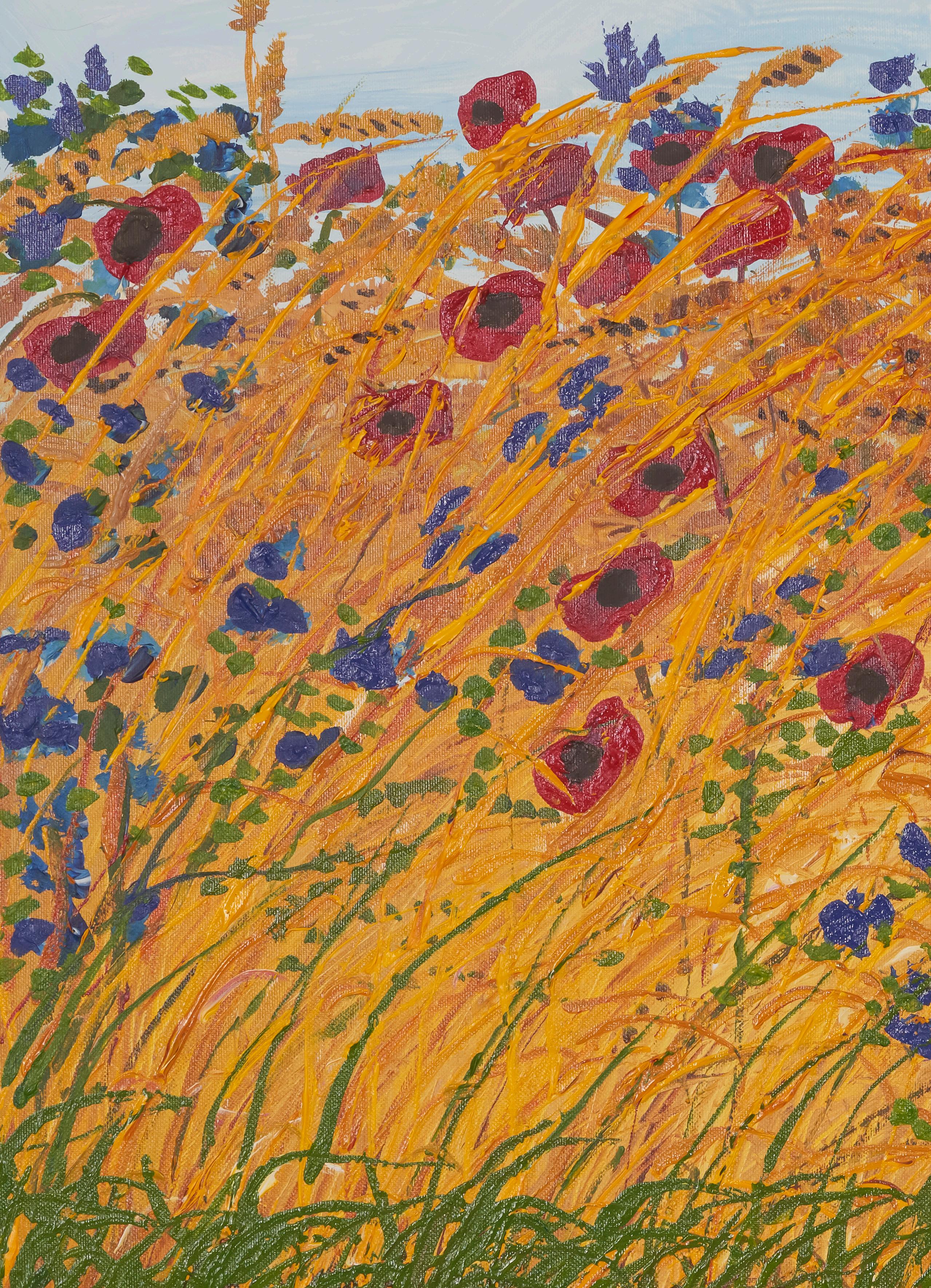
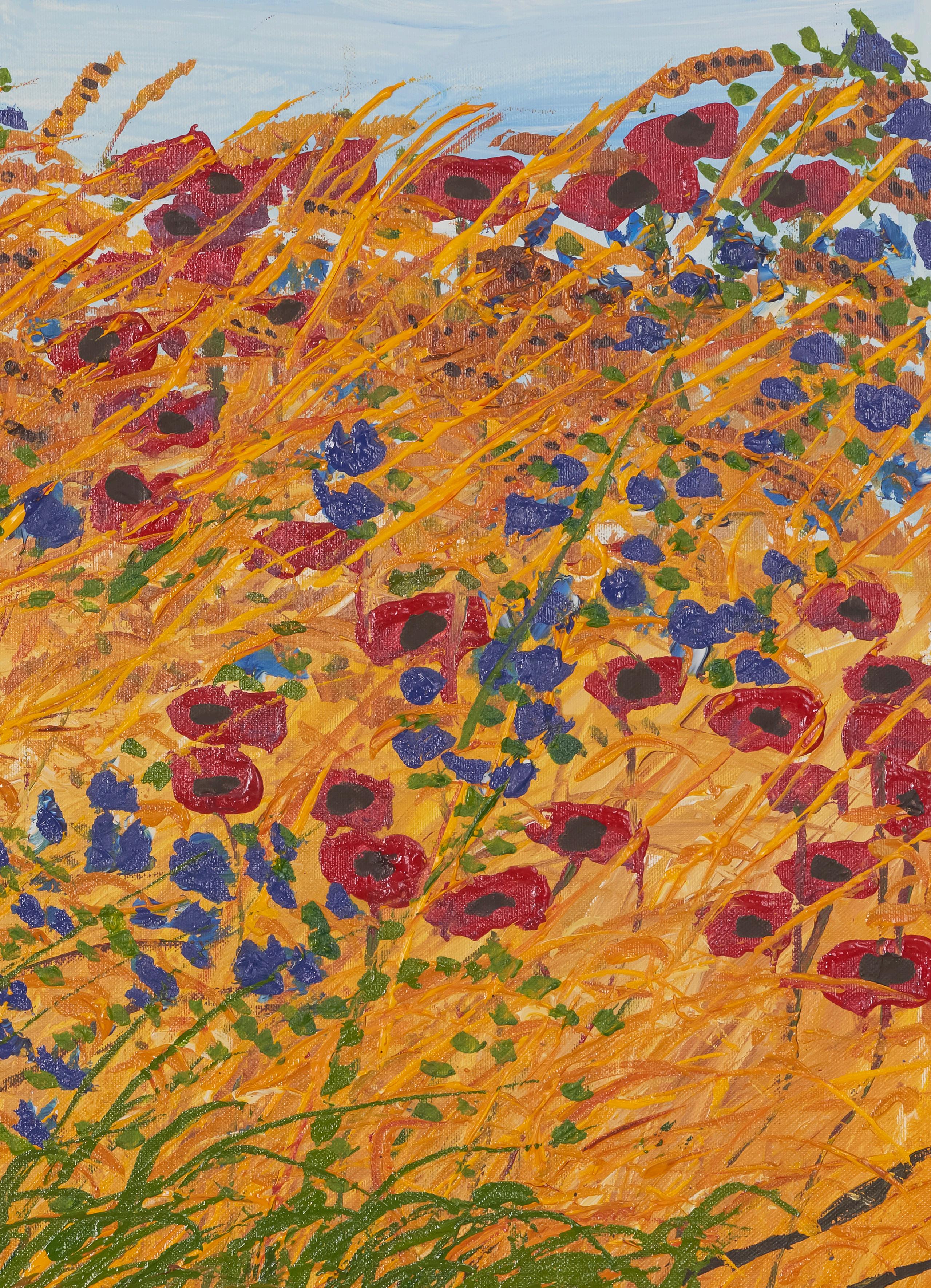
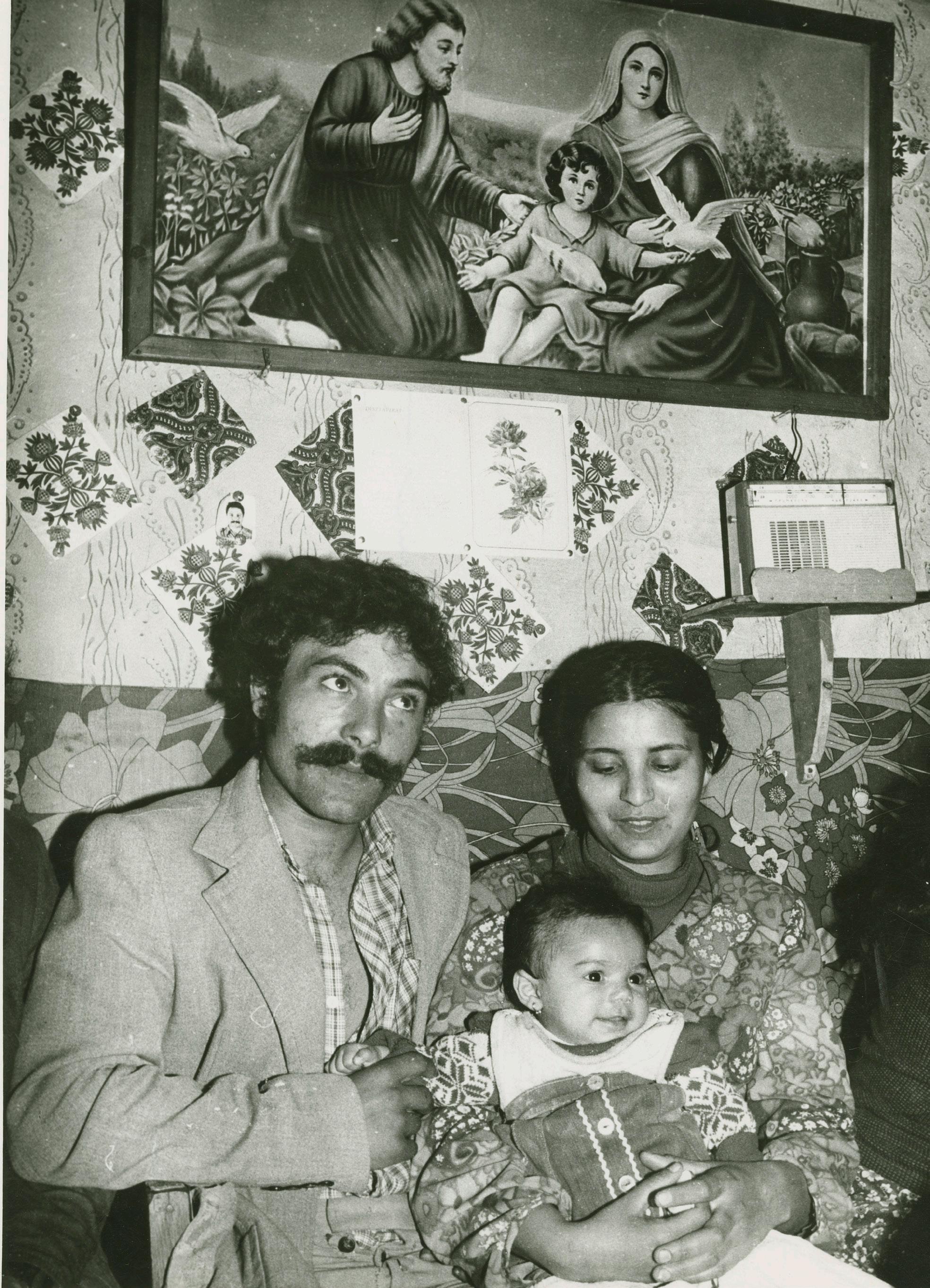

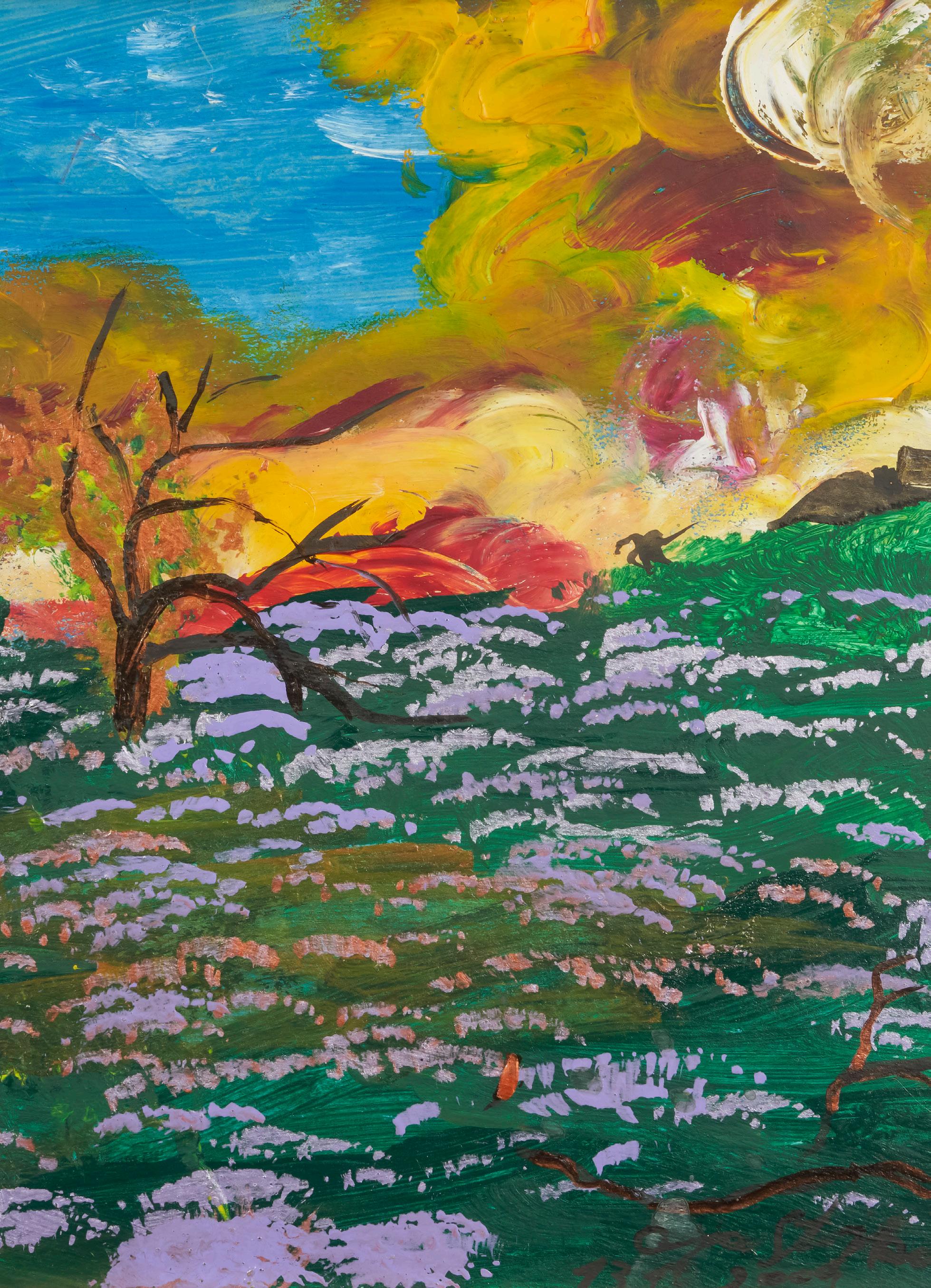

 Collection James Draznin
Collection James Draznin





























